Hiking pants are a critical piece of outdoor gear that protect our legs and help us regulate our temperature in both hot and cold weather. Finding the right pair of hiking pants isn't always easy. Finding a pair of women's pants can be even more difficult. With so many options to choose from, from high-waisted to low-waisted, stretchy to stiff, curvy to straight, picking out a pair that's not only functional but fits you well is quite the task.
The ExplorersWeb team has tested over 10 pairs of women's hiking pants to create this guide. We looked for pants that were breathable and gave protection from the sun and rain, didn't restrict our movement, and fit a variety of women's bodies.
If you're looking for the right footwear to pair with your hiking pants, check out our guide to the Best Hiking Boots. If you're looking for men's hiking pants, head to our The Best Hiking Pants of 2024 guide.
Our Picks for the Best Women's Hiking Pants
- Best Overall Women's Hiking Pants: Kari Traa Henni Pants
- Best Lightweight Hiking Pants: Arcteryx Gamma Lightweight Pants
- Most Stylish Hiking Pants for Women: 5.11 Shella Pants
- Best Hiking Joggers: Kari Traa Thale Jogger Pants
- Best Hiking Leggings: Icebreaker Merino 260 Fastray High Rise Tights
Best Overall Women's Hiking Pants:
Kari Traa Henni Pants
Features: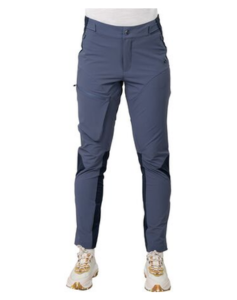
- 80% of the textiles in the pants are bluesign® approved
- PFAS-free water-repellent treatment
- 4-way stretch and articulated knees for increased mobility
- Ventilation zippers
- Large, zippered thigh pocket that easily fits phones
Why we like them: Comfortable softshell pants for hiking, climbing, or mountaineering
What we don't like: Heavier fabric may not be suitable for hot conditions
Fabric: Polyamide 88%, elastane 12% | Fit: Regular | Weight: Unknown | Water Resistant: Yes | UPF: 40+ | Extended sizes/inseams?: No
The first thing we noticed on the Kari Traa Henni Pants ($150) was the large, zippered thigh pocket, perfect for holding your phone. Finding functional pockets on women's pants is often a trial of patience and futility, but the Henni Pants did not disappoint. They also have zippered hand pockets, as well as zippered vents. The waistband is high and comfortable, and the pants come with four-way stretch, articulated knees, and a gusseted crotch for maximum mobility. They are one of the most comfortable pairs of pants we've ever worn and are perfect for hiking and climbing.
Kari Traa was founded by a woman and creates women-specific gear. They've also been PFAS-free since 2013, and their main fabric suppliers are bluesign® certified, meaning they only use safe input chemicals, monitor air and water emissions, and prioritize worker safety.
Best Lightweight Hiking Pants:
Arcteryx Gamma Lightweight Pants
Features: 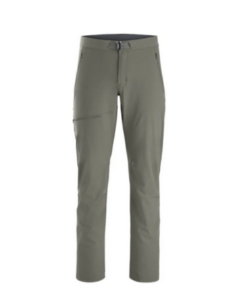
- Made from recycled materials
- Low profile belt doesn't rub under a pack or harness
- Three zippered pockets
- UPF rating of 40+ for sun protection
- High elastane percentage for stretch
- Lightweight fabric that balances breathability with wind resistance
Why we like it: All of the best features of the Gamma Pants in incredibly lightweight, breathable material
What we don't like: Thinner fabric may be less abrasion-resistant
Fabric: 86% nylon, 12% elastane | Fit: Fitted | Weight: 7.8 oz. | Water resistant: Yes | UPF: 40+ | Extended sizes/inseams?: 3 inseams available
The Arcteryx Gamma Lightweight Pants ($160) are made of a light, more breathable fabric and are our pick for lightweight pants. Chelsey has used the Gamma Lightweight Pants for years for her spring and fall backpacking and canyoneering trips in Utah. She likes the flexibility of the four-way stretch fabric and how lightweight the pants feel in hotter temperatures. They also have three zippered pockets for storing valuables. Despite their light weight, they also have adequate wind and water resistance, as well as UPF 40+ for sun protection.
She's found that the pants are more prone to abrasion than the original Arcteryx Gamma Pants, though any pants would be hard-pressed to stand up to repeated seasons of slithering through Utah's slot canyons.
Most Stylish Hiking Pants for Women:
5.11 Shella Pants

Features:
- Minimalist design for daily wear
- Reinforced belt loops
- Six total pockets, including large cargo pockets
- DWR finish
- Reinforced belt loops
- Extremely comfortable
Why we like them: Minimalist, casual enough for daily wear, very comfortable waistband
What we don't like: No integrated belt or adjustable cuffs, only zipped back pockets
Fabric: 89% polyester, 11% elastane | Fit: Straight | Weight: 5.5 oz. | Water Resistant: Yes | UPF: No | Extended sizes/inseams?: 2 inseams available
The 5.11 Shella Pants ($68) are Chelsey's favorite hiking pants for daily wear, long travel days, and day hikes. The stretchy, DWR-treated fabric is ideal for hiking, while the functionally minimalist look doesn't look out of place for casual wear. Kirby and Chelsey thought they were one of the most comfortable pairs of hiking pants they tested. They have two hand pockets, two zippered back pockets, and two cargo pockets, providing ample storage.
Additionally, the belt loops are reinforced, so you can hang small items off them with a carabiner if needed. The waistband is also wider than many other women's pants and doesn't cut into our stomachs when sitting, squatting, or bending over.
Best Hiking Joggers:
Kari Traa Thale Jogger Pants
Features: 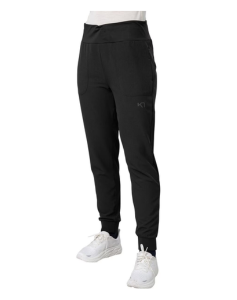
- High, wide waistband with drawstring for fit
- Made with recycled fabrics
- Secure, zipped hand pockets
- Ankle cuffs for a secure fit
Why we like them: Ridiculously comfortable, with athletic, breathable fabric
What we don't like: Heavier than other jogger options
Fabric: 60% polyester, 30% recycled polyester, 10% elastane | Fit: Relaxed | Weight: N/A | Water resistant: | UPF: 40 | Extended sizes/inseams?: No
Durable, comfortable, and functional, the Kari Traa Thale Jogger Pants ($110) are our choice for the best hiking joggers on the market. Featuring a relaxed fit and straight leg, these joggers are classy enough to wear into town as well as on the trails. The wide, high waistband was designed with comfort in mind, with a drawstring to help secure the joggers at your waist. Two zipped hand pockets provide a secure place to keep things while out on the trail.
Best Hiking Leggings:
Icebreaker Merino 260 Fastray High Rise Tights

Features:
- 97% merino wool
- Stash pocket large enough for a phone
- High-rise waist
- Body contouring details
- Flatlock seams to prevent friction
Why we like them: Comfortable high waist, stash pocket for phones
What we don't like: Not water or wind-resistant, expensive
Fabric: 97% merino wool, 3% elastane | Fit: Legging | Weight: 9 oz. | Water Resistant: No | UPF: No | Extended sizes/inseams?: No
Leggings are a popular choice for hiking because they are stretchy and can pull double duty at yoga, the gym, or layered under hiking pants during colder seasons. The IceBreaker Fastray High Rise Tights ($120) are Kirby's favorite hiking tights. She likes the insulation the merino wool provides and how easy it is to move in them. The high waist also gives them a form-hugging and flattering fit, and there's a gusseted crotch for increased mobility and airflow. While most leggings don’t have pockets, these feature a thigh stash pocket large enough for a phone. Like most leggings, these are not water or wind-resistant.
Honorable Mentions:
Prana&subId2=explorersweb Halle Pants

Features:
- Trouser-like pants for both active or casual wear
- Option to roll up pants and secure with a button closure
- Stretch Zion fabric
- Five total pockets
- DWR finish
- UPF 50+
Kirby and Chelsey tested the Prana Halle Pants while hiking, backpacking, and climbing. They liked the durability, the pockets, and the option to roll up the pants legs and secure them. However, Chelsey found that the pants stretched out a lot over a few days of wear, making for a baggy fit on backpacking trips. There's also no integrated belt to help hold them up, and some of the pocket closures and the button at the waist eventually fell off.
About our testing process
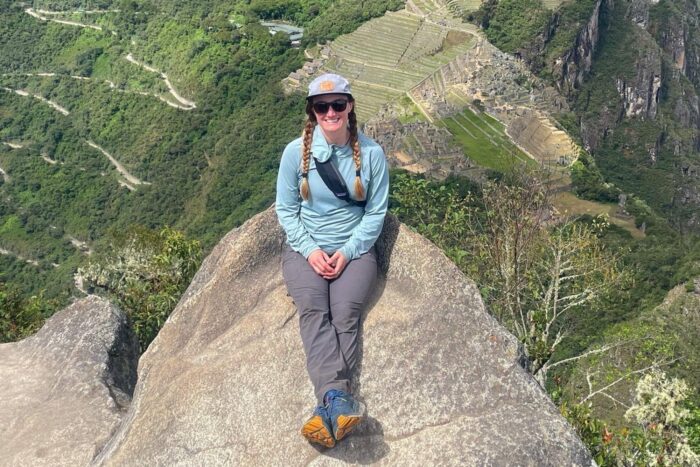
Gear Editor Chelsey Cook started the guide to women's hiking pants in July 2024. She has over twenty years of experience hiking, backpacking, and mountaineering. She tested the pants in this guide on day hikes, backpacking trips, and longer expeditions in Alaska, Washington, Utah, Scotland, Peru, and the Faroe Islands.
Chelsey routinely spends several consecutive weeks wearing a single pair of hiking pants on expeditions and knows the value of a good pair of pants you don't mind living in. Chelsey looks for hiking pants that are, above all else, comfortable and durable. She also likes pants that are designed to comfortably fit women's bodies, look great in the frontcountry, and have large, functional pockets.
Kirby Kahl is a tester for our Best Hiking Pants guide, and several pairs that she tested also made it to our Best Women's Hiking Pants guide. Kirby's been hiking her entire life and is an avid rock climber. She likes hiking pants that can do it all. She tested the 5.11 Shella Pants, the IceBreaker Fastray High Rise Tights, and the Prana Halle Pants, wearing them on hiking trips and long alpine climbs.
We tested our hiking pants by wearing them as much as possible. Chelsey took a few of our favorite pairs canyoneering in Utah, and squeezing through slot canyons and stemming rough canyon walls quickly separated which pants could stand up to some abuse.
When testing the comfort and stretchiness of hiking pants, we wore them scrambling and rock climbing and looked for the pants that hindered us the least. We also tested hiking pants in a range of different conditions, from wet, cold, and snowy to hot and dry, and evaluated each pair for their breathability and wind- and water resistance.
Things to consider when buying women's hiking pants
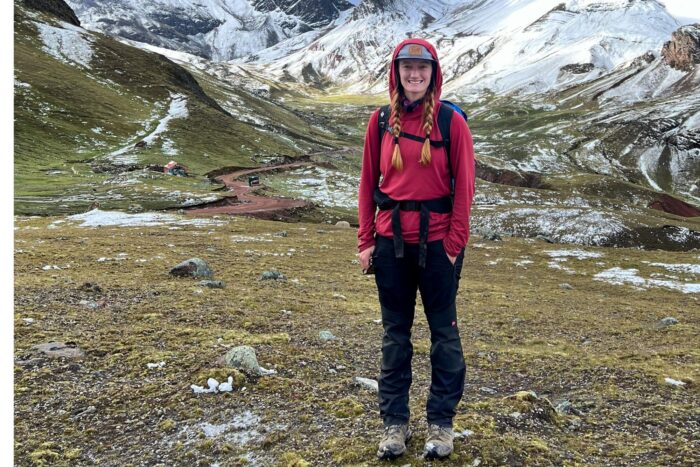
Types and lengths of hiking pants
Hiking pants come in different types, including traditional, convertible, roll-up, joggers, and tights. Traditional pants are typically full-length and water-resistant. These are a versatile option for most hiking needs, as the full-length legs will protect you from the sun and any bushwhacking and the DWR finish will keep you warm and dry during bad weather.
Convertible hiking pants — which aren't featured in this guide — have zip-off legs that turn the pants into shorts. This is a great feature for all-day hikes or backpacking trips when it could be cool in the mornings and hot in the evenings. However, zip-off pants aren't the most stylish, and you usually have to remove your hiking boots to pull the legs off. Roll-up pants are a happy medium between traditional and convertible pants. They have a button or drawcord that secures the pant cuff when you roll them up.
There are also hiking tights, like the IceBreaker Fastray High Rise Tights. Some people may find tights more comfortable than hiking pants. However, they don't offer any weather protection and snag easily on rocks and branches. There are also joggers, which are essentially loose tights. Some joggers provide weather protection.
Materials
Most of the hiking pants in this guide and on the market are made of a blend of different synthetic materials, like polyester or nylon, and an elastic fiber like elastane. Polyester and nylon are durable fibers, while elastane gives hiking pants some stretch. Coupled with a water-repellent finish, this fabric is often called "soft-shell," and is both breathable and protective.
Cotton blends are also occasionally used in hiking pants. This material is very breathable but absorbs moisture and isn't insulating when wet. Cotton pants should be reserved for hot, dry climates and are not featured in this guide.
Hiking tights and joggers are generally made of the same materials as hiking pants, though some feature merino wool, which wicks away moisture, prevents odor buildup, and will keep you warm even when wet.
Weather protection
Hiking pants, particularly soft-shell ones, often have a durable water-repellent finish (DWR). A DWR coating doesn't necessarily mean waterproof, but it does add enough water resistance to keep you dry when hiking in light rain or through wet foliage. It does lower breathability, however, and water-resistant pants often feel heavier.
Some hiking pants, like the Prana&subId2=explorersweb Halle Pants, also have a UPF (ultraviolet protection factor) rating, which measures how well the fabric blocks harmful UV radiation from the sun. The higher the UPF rating, the more UV radiation the fabric blocks. If you hike in the desert or at high altitudes, consider hiking pants with a high UPF for added protection.
Mobility and fit
Hiking pants should move with you. You may not need the stretchiest pants on the market if you usually hike well-groomed trails, but if you plan on scrambling or climbing in your pants, you'll want those with a higher percentage of stretchy materials like elastane. Features like a gusseted crotch and articulated knees also improve the range of motion.
Hiking pants come in a variety of fits. Slim fits may restrict motion, while baggier fits could snag on rocks and undergrowth. It can be particularly difficult to find pants that fit if you have a female-shaped body. Some brands offer extended sizing for their hiking pants, while other brands offer different inseam lengths and curved versions.
Because everyone is shaped differently, it's best to try on several different pairs of hiking pants before settling on one you like. You want your pants to fit snuggly, but not restrict your movement. If you will carry a heavy backpack, look for hiking pants that don't require you to wear a belt, as a belt can rub against a pack and your skin.
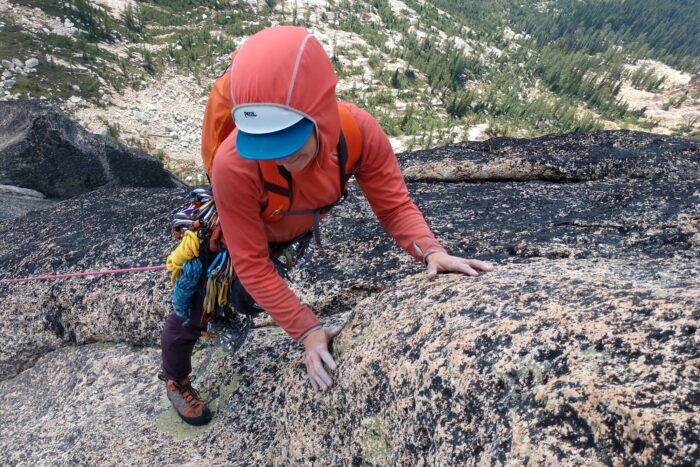
Additional features
Hiking pants' designs range from fully featured to minimalist. Ideally, you want a pair of pants that have all the features you find necessary without adding weight or restricting movement.
If you like carrying things in your pockets, look for pants with a mix of large cargo pockets and zipped pockets for extra protection. Historically, one of the main complaints we've had for women's hiking pants is not having large, functional pockets. Thankfully, the market seems to be catching on. We particularly loved the secure thigh pockets on the Kari Traa Henni Pants.
Waist closures are also an important feature. Most hiking pants have a zipper and button closure, while joggers and tights have a stretchy, thick waistband. Integrated belts can also be a nice feature, but make sure the system is comfortable and, if you're going backpacking, minimal enough that it won't rub against a backpack's hip belt.
Some pants come with adjustable cuffs, which can be helpful if you wear a variety of different shoes and boots when hiking.
Frequently asked questions about women's hiking pants
What types of pants are best for hiking?
The type of hiking pants that works best for you depends on where you hike, what weather you hike in, the duration of your hiking trips, and your personal preferences. If you hike in cold, wet conditions, look for pants with a DWR finish. If you prefer to hike in the desert or hot conditions, look for lighter fabrics with a UPF rating, convertible pants, or roll-up pants. Above all, make sure your hiking pants fit you well and don't restrict your movement.
Should hiking pants be loose or tight?
Hiking pants should be comfortable and not impede your movement. They should neither be too tight nor too loose. Here’s how you can test your pants before you venture onto the trail with them.
Squat – Your pants shouldn't pinch you anywhere when squatting, or riding up more than a few inches. The waist should still be flush against your back.
Sit – If the pants are tight or uncomfortable when sitting, you may need another size or another design.
Raise one knee at a time – Raise each knee as high as possible. Your pants shouldn't block your movement, pinch at your hips, split at the crotch, or ride up more than a few inches.
Do I need to wear long pants when hiking?
This comes down to personal preference and where you are hiking. Full-length pants provide optimal protection from rain, sun, mosquitoes, and abrasions from rocks and undergrowth. However, even the lightest pair of hiking pants can feel too hot on warm days. If you mostly hike in the desert, you may appreciate the breathability of shorts. Just make sure to wear plenty of sunscreen on your lower legs if you do.
Can I hike in jeans?
Jeans are a great choice for the frontcountry, but not for hiking. They're made of cotton, which doesn't wick away moisture or insulate when wet. They're also not breathable, don't stretch, and are heavy compared to hiking pants.
What shoes should I wear with hiking pants?
You should wear sturdy shoes that offer good foot support and protection. Check out our Best Hiking Boots of 2024 for a full guide.
In recent years, outdoor adventurers have become more careful about sun protection, as the dangers of sun exposure become better known and skin cancer rates continue to rise. It's rare to be at a trailhead or crag these days and not see someone wearing a sun shirt, the hood pulled up to protect their face from UV rays.
The ExplorersWeb team is a big fan of sun shirts, and we wear them for everything from backpacking to climbing to packrafting to gardening. We like sun shirts that are breathable, comfortable, and odor-resistant. A high UPF rating helps increase a sun shirt's UV protection, as do hoods and thumb loops.
With so many sun shirts on the market these days, it can be difficult to know which is the right one for you. Luckily, we did the hard work for you, testing 10 different sun shirts to find our favorites. Gear Editor Chelsey Cook took on the lion's share of testing, wearing different sun shirts while guiding in the Alaska Range and Peru, as well as on personal trips in the canyons of Utah and volcanoes of the Pacific Northwest.
As someone who's had several friends already diagnosed with skin cancer in their 30s, Chelsey takes sun protection seriously. She is rarely without a sun shirt, even in the frontcountry. The sun shirts she chose for this guide are a good mix of fashionable and functional, synthetic and natural fibers, and light to medium weights.
Our Picks for the Best Sun Shirts
- Best Overall Sun Shirt: Black Diamond Alpenglow Hoody
- Best Sun Shirt for Hot Weather: Patagonia Tropic Comfort Natural Hoody
- Best Sun Shirt for Women: Kari Traa Sanne Sunshirt
- Best Natural Fiber Sun Shirt: Voormi River Run Hoodie
- Best Button-Up Sun Shirt: Outdoor Research Astroman Sun Shirt
Best Overall Sun Shirt:
Black Diamond Alpenglow Hoody
Features: 
- UPF 50+ and in-fiber cooling technology to reflect 71% of near-infrared rays
- Under-the-helmet hood design
- Polygiene odor control
- Underarm gussets for increased range of motion
Why we like it: Incredibly lightweight, durable, and comfortable
What we don't like: Zip pocket is not accessible when wearing a harness or hip belt, no thumbholes
Materials: 87% polyester, 13% elastane | Weight: 8.6 oz. | Pockets: Yes | UPF: 50+
The Black Diamond Alpenglow Hoody ($95) has been Chelsey's go-to sun shirt for several years. She practically lives in hers during her mountain guiding seasons. She also wears one while teaching mountaineering courses in the Alaska Range and leading backpack trips in Alaska and Peru.
She loves the loose, breathable material and finds it comfortable in warm and cool temperatures. The deep hood pulls over her baseball cap and the panel along the collar helps protect her neck. Although made of polyester, the Alpenglow Hoody has surprisingly good odor control and feels fresh even after several consecutive days of wear.
There are no thumb loops, but the sleeves are long and drapey enough to cover the backs of the hands. A small zip pocket is along the right side of the hem. However, its placement makes it difficult to access while wearing a climbing harness or a backpack's hip belt.
Check Men's Price at Black Diamond
Check Women's Price at Black Diamond
Best Sun Shirt for Hot Weather:
Patagonia Tropic Comfort Natural Hoody
Features: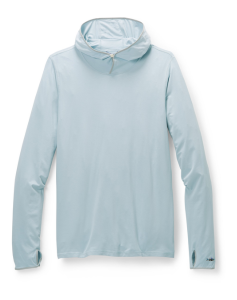
- Made from renewable, beech tree pulp modal fabric
- Long sleeve length with thumb loops for added protection
- Generous hood fits over a baseball cap
- Made in a Fair Trade Certified
 factory
factory
Why we like it: Lightweight, super soft, and cool against the skin
What we don't like: Currently only offered in light colors
Materials: 96% modal sun, 4% spandex | Weight: 9.4 oz. | Pockets: Yes | UPF: 40+
Chelsey could barely manage to take the Patagonia Tropic Comfort Natural Hoody ($99) off while she was testing it, it was so comfortable. The buttery soft, breathable, and lightweight fabric is especially good for hot climates. The silky feel is thanks to the modal fabric, created from renewable, beech tree pulp. Modal fabric is eco-friendly, and more sustainable than synthetic fabrics and more durable than cotton. It also retains its hygroscopic properties after washing, giving it long-lasting odor control.
The Tropic Comfort Natural Hoody also has a generous hood and thumb loops for added protection.
Check Women's Price at Backcountry
Best Sun Shirt for Women:
Kari Traa Sanne Sunshirt
Features: 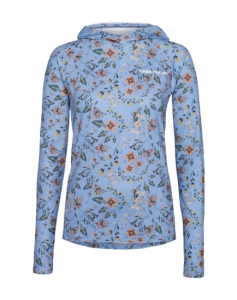
- Secure hand pocket to keep important items safe
- Made from recycled polyester
- Curved hem for extra coverage when bending and sitting
- Thumbholes for a secure fit
Why we like it: Relaxed fit, fun patterns
What we don't like: Material feels a little heavy on the skin
Materials: 90% polyester, 10% elastane | Weight: Unknown | Pockets: Yes | UPF: 40+
The Kari Traa Sanne Sunshirt ($60) is a women's specific sun shirt, with a loose fit, raglan sleeves, and a curved hem. Chelsey loves the fun colors and patterns, and the flattering fit is at home in the backcountry and in town. Thumb loops help protect the back of your hands. While the hood isn't as deep as other sun shirts, it's sufficiently large to pull over a hat or helmet. The material does feel heavier and less breathable than other sun shirts, so it may not be the best pick for hot weather or hard efforts.
Kari Traa was founded by a woman and puts sustainability at its forefront. The Sanne Sunshirt is made with 90% recycled polyester, and Kari Traa fabrics are PFAS-free.
Best Natural Fiber Sun Shirt:
Voormi River Run Hoody
Features: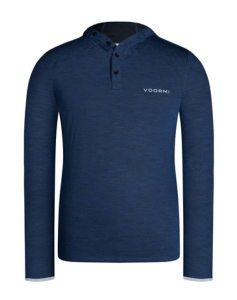
- DUAL SURFACE
 UL Precision Blended Wool
UL Precision Blended Wool - Integrated thumb loops
- Buttoned, full-cover hood
- Odor-resistant and wicks sweat
- Retains some insulating properties when wet
Why we like it: Ridiculously lightweight and breathable
What we don't like: Expensive
Materials: 52% merino wool, 48% polyester | Weight: 7 oz. | Pockets: No | UPF: 30
The Voormi River Run Hoodie ($139) is one of the lightest, full-coverage merino wool sun shirts on the market and our choice for the best natural fiber sun shirt. Chelsey has worn hers while guiding Denali and on backpacking trips above the Arctic Circle. She loves how odor-resistant it is, even on long expeditions. The merino wool helps wick sweat away while also insulating when wet. Thumb holes and a buttoned, full-cover hood offer great UV protection. though it has a lower UPF rating than other sun shirts.
Like most wool, the River Run Hoodie may be a little itchy when you first pull it on. Chelsey has very sensitive skin but finds that the itchiness fades quickly, especially as the fabric becomes worn in.
Best Button-Up Sun Shirt:
Outdoor Research Astroman Sun Shirt
Features: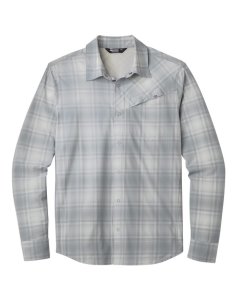
- AirVent
 inner back yoke aids ventilation
inner back yoke aids ventilation - Welted chest pocket with a secure snap closure
- Shirttail hem for a casual look
- Lightweight. stretchy, and bluesign® approved fabric
Why we like it: Stylish look for the front and backcountry, cooling, lightweight fabric
What we don't like: No hood and shorter sleeves make for less coverage than other sun shirts
Materials: 85% nylon, 15% spandex | Weight: 6.1oz. | Pockets: Yes | UPF: 30-50+ depending on color
While we generally prefer sun shirts with hoods for maximum sun protection, we understand they're not everyone's preference. Hoodless, button-up sun shirts are a great option for those looking for a more stylish, versatile option. The Outdoor Research Astroman Sun Shirt ($110) is our pick for the best button-up sun shirt. This lightweight shirt is soft and cool on the skin, perfect for warmer days. The Astroman Sun Shirt is low on features, however. While there is a chest pocket with a snap closure, there are no zippered pockets and no thumb loops. Despite that, the plaid patterns, button-up closure, and shirttail hem make it a versatile option for both the backcountry and the frontcountry.
Check Women's Price at Backcountry
About our testing process
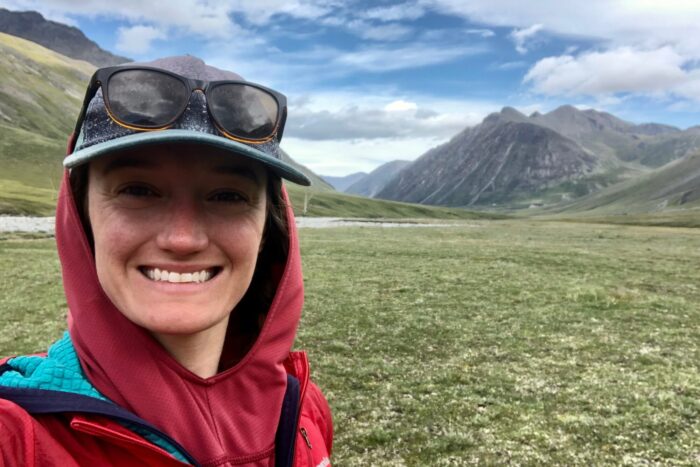
Sun shirts have become more and more popular over the past decade and are now an integral part of many outdoor kits. Gear Editor Chelsey Cook started this guide to sun shirts in July 2024. She has been wearing sun shirts almost daily for over seven years, relying on their UPF rating and hoods to keep her skin safe whether she's hiking, climbing, mountaineering, or packrafting. She tested the sun shirts in this guide on day hikes, backpacking trips, and longer expeditions in Alaska, Washington, Utah, Scotland, Peru, and the Faroe Islands. She wore them to the summit of Denali while on three-week canyoneering trips in Utah and while fishing to fill her freezer in the rivers of Alaska.
Chelsey is a professional mountain guide and routinely spends several consecutive weeks wearing a single sun shirt on expeditions. She looks for sun shirts that are loose, breathable, and odor-resistant. Because she spends so much time at altitude and on glaciers, where the sun's UV rays are stronger, she also prioritizes high UPF ratings, thumb loops, and deep hoods for even more protection.
She wore sun shirts as much as possible while testing them for this guide, checking them for long-term comfort and durability. Chelsey also enjoys having a minimalist closet and looks for clothing that can pull double duty. She wore the sun shirts in this guide while traveling in Europe, out to local breweries, and to work meetings to ensure they fit in in the frontcountry as well as the backcountry.
Things to consider when buying sun shirts
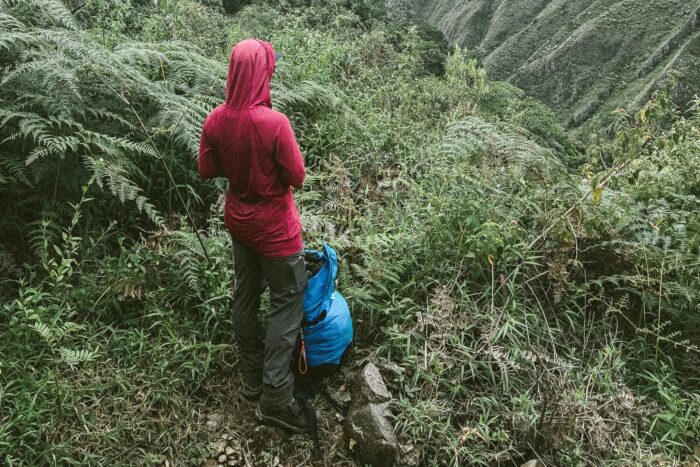
UPF rating
UPF, or Ultraviolet Protection Factor, rates a fabric's ability to filter out harmful UV light. Ratings usually fall between 15 and 50+; a rating of 30 allows about 3%, or 1/30th, of UV rays to pass through it.
Different variables affect a fabric's UPF. Dark colors filter more UV rays out, as do thicker fabrics and tighter weaves. Sun shirts need to strike a balance between breathability and UV protection. All of the sun shirts in this guide have a UPF rating of 30 or above.
Materials
Most sun shirts are made from polyester, with a stretchy material like elastane incorporated as well. Polyester is durable, dries quickly, and offers good UV protection, while elastane increases airflow and stretchiness. There are downsides to this blend, however. Polyester tends to stink after repeated sweaty use, and elastane loses its springiness after a while. So your sun shirt may begin to stretch out over time.
Some sun hoodies are made out of natural fibers instead, like merino wool or beech tree pulp, like the Patagonia Tropic Comfort Natural Hoody. Natural fibers are a great, sustainable choice, and they don't hold onto odor as strongly as synthetic fibers like polyester.
Breathability
Sun shirts are designed to be worn primarily in sunny conditions, so they should be comfortable in warm temperatures. A breathable sun shirt also dries quicker, whether wet from sweat or rainwater. It's better to err on the side of lighter and more breathable than to look for a sun shirt that offers insulation. The sun shirt serves as a base layer and should be breathable enough to keep your temperature regulated when you're working hard.
You can always add layers on top of your sun shirt if the temperature drops. The two most breathable sun shirts on this list are the Black Diamond Alpenglow Hoody and the Patagonia Tropic Comfort Natural Hoody.
Fit
Sun shirts generally have a relaxed fit, and Chelsey always sizes up her sun shirts to make them even looser. A looser fit increases breathability and will help move with you better. Larger sizes also have longer sleeves, providing more coverage for the backs of your hands. They also sometimes have deeper hoods; Chelsey likes to have a hood large enough to cover the brim of her baseball cap to give her face maximum protection from the sun.
Features
Sun shirts are inherently straightforward pieces of gear. Thumb loops are one of the few features offered. Your fingers and hands are exposed to a lot of sun when you're outside and are susceptible to skin cancer. Thumb loops help pull the sun shirt's sleeves over the backs of your hands, affording them more protection. Most sun shirts have hooded pullover thumb loops, though some have simple elastic loops for your thumbs. The hooded pullover thumb loops offer more protection.
Some sun shirts also come with pockets, a feature we appreciate. The pockets are rarely large enough for your phone but are great for stashing keys, chapstick, or small sunscreen face sticks. They're generally zippered, and their location depends on the sun hoody. They can be along the hem, at the chest, or on your side. We prefer them anywhere but along the hem; they tend to get in the way of climbing harnesses and backpack hip belts when they're that low.
Frequently asked questions about sun shirts
Are sun shirts worth it?
Sun shirts are a fantastic way to protect yourself from harmful UV rays and lower your risk of skin cancer. Sun shirts with a high UPF rating block most UV rays and provide added coverage for your arms, the backs of your hands, and your face.
Should I wear a sun shirt when it's cloudy?
While clouds may filter out some UV, they can amplify them in other cases. It's important to wear sunscreen and sun shirts even when it is cloudy out.
What is the best color to wear for sun protection?
Dark colors, like blue and black, absorb more UV rays than lighter shades like white, blocking them from your skin. For maximum protection, stick to dark sun shirts.
Not all hiking boots are created equal. Some hiking boots protect you against wet weather while falling short on ankle support. Others offer ankle support but have soles too flexible for technical terrain. To help you find the best hiking boots for your needs in 2024, we’ve listed our picks for this year's best hiking boots.
Gear Editor Chelsey Cook has over 20 years of experience hiking and backpacking. She has spent six years working as a professional mountain guide in Alaska. Chelsey put the hiking boots in this guide through the wringer, crossing glacial rivers and tussock fields on two-week backpacking trips above the Arctic Circle, dropping into slot canyons and packrafting through Utah's Canyonlands, and summiting Kilimanjaro. She prioritizes comfort and support for long days and seeks durable boots that last several seasons in the Alaska bush.
Throughout our testing process, we considered quality, materials, purpose, construction, waterproofing, and traction. The ExplorersWeb team tested each pair of hiking boots in terrain across the West Coast and Alaska. If you're looking for more technical footwear, check out our guides to the best mountaineering boots and best rock climbing shoes.
Editor’s Note: We updated this guide on July 20, 2024, to announce the Salomon&subId2=explorersweb X Ultra Mid Hiking Boots as the best overall boot. We also included the Salomon Quest 4 GORE-TEX as the best hiking boots for backpacking.
Our Best Hiking Boots Picks:
- Best Overall Hiking Boots: Salomon X Ultra Mid Hiking Boots
- Best Hiking Boots for Backpacking: Salomon Quest 4 GORE-TEX Hiking Boots
- Best Hiking Boots for Technical Terrain: Scarpa Men’s Zodiac Plus GORE-TEX Hiking Boots
- Best Boots for Light Mountaineering: La Sportiva Trango Tech GORE-TEX Boots
- Best Hiking Boots for Style and Performance: Timberland Men’s White Ledge Mid Waterproof
- Best Hiking Boots for the Desert: 5.11 A/T Hiking Boots
- Best Budget Hiking Boots: NORTIV 8 High Waterproof Hiking Boots
Best Overall Hiking Boots:
Salomon X Ultra Mid Hiking Boots
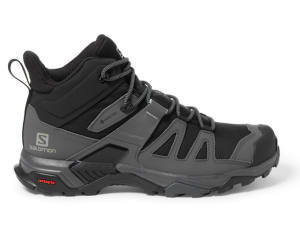
Features:
- Lightweight and nimble, feels like a pair of trail runners
- Gore-Tex membranes are waterproof and breathable
- Mid-height supports ankle without being constricting
- All Terrain Contagrip® outsoles grab the terrain, even when it's wet or slippery
Why we like it: Lightweight, flexible, and supportive
What we don't like: Not as durable as we would like, narrow toe box
Materials: Polyurethane-coated leather and textile, rubber sole | Weight: 1 lb 14.4 oz | Waterproof: Yes
While the Salomon&subId2=explorersweb X Ultra Mid Hiking Boots ($175) fall solidly in the hiking boots category, the design is inspired by trail running shoes, and lightweight flexibility is a key element. They're a great choice for a do-it-all boot that can handle backpacking and backcountry objectives, while are still lightweight enough to be comfortable on groomed day hikes. Salomon's industry-leading GORE-TEX liner also provides plenty of weather-proofing to keep your feet dry.
The burly Contragrip sole gives great traction on a range of surfaces, from wet rocks to slick grass to scree fields. While the boots are only mid-height, the Advanced Chasses insert in the outsole still gives you plenty of lateral support. Chelsey's had a few ankle surgeries and usually only wears boots that extend over her ankles. However, she found the X Ultras to be surprisingly supportive despite their low height. The toe box is on the narrower side, which could make a comfortable fit difficult if you have wide feet. Chelsey also found them to be slightly less durable than other options. After running them through the backcountry-wringer in Alaska, she noticed more wear than expected on the textile material.
Best Hiking Boots for Backpacking:
Salomon Quest 4 GTX Hiking Boots
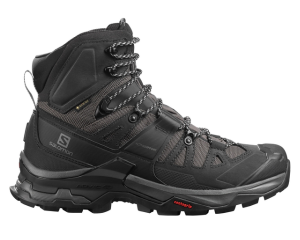
Features:
- Gore-Tex membranes are waterproof and breathable
- Contragrip rubber outsoles
- Deep lugs for grip and durability
- ADV-C 4D chassis for ankle support
Why we like it: Supportive all-around boot that excels in most environments, including off-trail backpacking
What we don't like: Heavy, might be too much boot for non-technical hikes or warm climates
Materials: Leather, textile, Contragrip rubber sole | Weight: 2 lbs 14.4 oz | Waterproof: Yes
While the Salomon Quest 4 GTX ($230) is a beefy boot that falls solidly in the hiking boots category, its design also comes from trail running shoes, where lightweight flexibility is a key element. We tested these boots over three seasons of backpack guiding in remote Alaska. Their ankle support and deep lugs excelled in all types of terrain, from slippery tussocks to scree fields to river crossings. The boots were also comfortable and light enough to keep our feet happy on several 10-hour hiking days, even with a heavy pack.
Although designed for longer expeditions and tough conditions, the boots were flexible and comfortable enough for groomed on-trail travel, though you may want a mid-height boot or hiking shoe, if that is the only type of hiking you plan on doing. While some third-party reviews mentioned durability issues, we put over 100 days of hard travel on a single pair of Quest 4 GTXs without significant issues and still use the same pair for personal trips.
Best Hiking Boots for Technical Terrain:
Scarpa Zodiac Plus GORE-TEX Hiking Boots

Features:
- 100% suede construction
- Gore-Tex performance comfort
- Three densities of EVA midsole to optimize performance
- Asymmetric lace for a precise fit
- Sock-Fit DV construction reduces bulk and creates a snug fit
Why we like it: An asymmetric lacing system helps you get a precise fit, suede upper is very abrasion-resistant
What we don't like: Wide toebox may not fit narrow feet, no heel welt for crampon use, expensive
Materials: Suede leather, Vibram outsole | Weight: 2 lbs 6.4 oz | Waterproof: Yes
Scarpa is renowned for their mountaineering and ice climbing boots, and the Scarpa Zodiac Plus GTX ($349) is our choice for hiking in technical terrain, including scree fields and scrambling. These mid-weight hiking boots are comfortable enough for long approaches and supportive enough to handle 3rd- and 4th-class terrain, and snow.
Made with Gore-Tex Performance Comfort, these boots keep your feet bone-dry while hiking. They have a strong rubber sole that, while not the sturdiest we’ve encountered, can handle a lot of wear. The shaft measures about six inches from the arch of the foot. It laces up with an asymmetric lace system, with a Sock-Fit DV construction for a snug fit. The suede upper is extremely abrasion-resistant and the Vibram outsole offers exceptional grip on all types of terrain. Scarpa boots tend to fit wider, and they may not be suitable for narrow feet.
Best Boots for Light Mountaineering:
La Sportiva Trango Tech GORE-TEX Boots
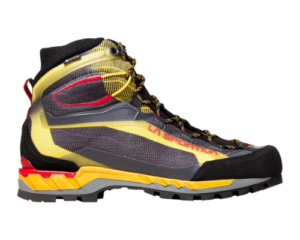
Features:
- Multi-directional upper hinge supports ankle movement
- Vibram sole offers high-performance traction
- Impact brake system reduces impact forces
- Heel-welt to attach semi-automatic crampons
Why we like it: Excellent light mountaineering boot that's light enough for long approaches
What we don't like: Expensive, stiff, not for everyday hikes
Materials: QB3 waterproof fabric, Vibram sole | Weight: 2 lbs 15 oz | Waterproof: Yes
The La Sportiva Trango Tech GTX ($299) is designed to bridge the gap between hiking and mountaineering boots. It is ideal for all-in-one objectives that include hiking, snow, and climbing. We used them while hiking and climbing in the Cascades of Washington, where it's not unusual to start the day on a trail and end up on a glacier. We were impressed by how comfortable they were while hiking, while still being secure enough for climbing.
A multi-directional upper hinge is responsible for much of this comfort, as it allows your ankle to flex more than in a traditional mountaineering boot. That said, this flexibility comes at a cost, and for climbs or approaches where you will be on snow and ice for most of the route, you may want a burlier mountaineering boot.
Best Hiking Boots for Style and Performance:
Timberland Men's White Ledge Mid Waterproof Hiking Boots

Features:
- Made from premium Timberland leather
- Waterproof lining keeps feet dry
- Rust-proof fast-lacing
- Sturdy and fashionable
- Lining made with at least 50 percent recycled plastic
Why we like it: Sturdy and fashionable, at home whether you’re on the trail or at home
What we don't like: The rubber welt around the toe isn't the most durable
Materials: Leather, rubber sole | Weight: 2 lbs 4 oz | Waterproof: Yes
The Timberland White Ledge Mid Waterproof Hiking Boots ($89) are sturdy enough for trail hiking, and their all-leather look also makes them a stylish choice for casual wear. From a leisurely hike to a night out at the brewery, these men’s hiking boots can go just about anywhere.
The shaft measures approximately five inches from the arch, giving moderate support on non-technical trails. The White Ledge Hiking Boots also have a premium, full-grain waterproof upper, and the seams are sealed with waterproof construction. The lace hooks are rustproof, and the hooked closure design lets you lace up the boots quickly and securely. These boots are a great option for people looking for a daily walking shoe that can handle hiking trails as well.
Best Hiking Boots for the Desert:
5.11 A/T Mid Hiking Boots

Features:
- 5.11 A.T.L.A.S. Load bearing system
- Ortholite footbed
- 3D molded heel and toe protection
- High traction outsole that is slip and oil-resistant
- Welded mesh upper
- Mid-height support
Why we like it: Lightweight and breathable, with mid-height support
What we don't like: Water-resistant only, not suitable for wet conditions
Materials: Welded mesh, rubber | Weight: unknown | Waterproof: No, water resistant
This boot ($150) felt closer to a trail running shoe but offered similar weight distribution and support to many hiking boots. The 5.11 A/T Mid Hiking Boots' load-bearing assistance system helped us feel well-supported, despite the mid-height size of the boot.
Other key features include the Ortholite footbed for added comfort, 3D molded TPR heel and toe protection, the high traction outsole, and the foam cushioning throughout the boot. However, the welded mesh upper is only water resistant, not waterproof. While this makes these boots unideal for wet conditions, their breathability without full waterproofing makes them a great pick for the desert, where they aren't likely to get wet and will dry quickly if your feet get sweaty.
Best Budget Hiking Boots:
NORTIV 8 High Waterproof Hiking Boots

Features:
- Multi-directional lugs to support traction
- Shock-absorption midsole
- Slip-resistant
- Waterproof lining
- EVA footbed insole
- Half the price of many other options
Why we like it: Multi-directional lugs support traction, slip-resistant with a waterproof lining
What we don't like: Don't hold up in sustained wet conditions
Materials: Suede, mesh, rubber | Weight: 2 lbs | Waterproof: No, water resistant
As one of the most durable and affordable boots on our list, the NORTIV 8 High Waterproof Hiking Boots ($53) are fantastic budget hiking boots. The rubber outsole is non-slip, with multi-directional lugs to support traction, and the shaft measures approximately five inches from the arch, giving you moderate ankle support. They also feature a cushioned EVA footbed to support the foot's arch and provide comfort.
The water-resistant finish on these hiking boots help keep your feet dry through puddles and light rain. However, they lack full waterproofing and are not recommended for full-on wet conditions.
Honorable Mentions
Merrell Moab 3 Mid Waterproof Hiking Boots

Features:
- Merrell Air Cushion for maximum shock absorption
- Kinetic Fit contoured insole for comfort
- 100 percent recycled laces and mesh lining
- Waterproof membrane
- Vibram sole for maximum traction
Merrell's Moab 3 Mid Waterproof Hiking Boots ($150) is a mid-height hiking boot that prioritizes cushioning and comfort. An advanced Kinetic Fit removable contoured insole supports the heel and arch structure and absorbs shock. The soles are also durable, and we found them to stand up well to the stresses of hiking. The boots also have a sturdy rubber sole, with a waterproof finish reinforced by the M Select Dry Barrier, a breathable waterproof membrane.
Merrell Moab 3 Mid Waterproof Hiking Boots are very comfortable for long days on your feet. The waterproof membrane keeps out water while allowing internal moisture to evaporate. This is an excellent budget hiking boot that will last you a while.
La Sportiva Ultra Raptor II Mid GTX
Features: 
- Gore-Tex Extended Comfort waterproof/breathable lining
FriXion XF 2.0 rubber outsoles with Impact Brake System
Flexible ankle support
Lightweight trail-runner-like design
If you’re looking for a hiking boot that is light enough for fast-paced day hikes, yet protective enough for multi-day missions or when the conditions get rugged or wet, the La Sportiva Ultra Raptor II Mid GTX ($199) is a great hybrid option.
These mid-high hiking boots have a nearly identical design as the Ultra Raptor II trail runners, with the addition of soft and flexible ankle coverage for lightweight support -– while only weighing 2.4 ounces per foot more than the trail runners. We’d recommend the trail runners if you’re going to be mostly running or doing short day hikes in dry conditions, but the boots are preferable for multi-day hikes or adventures through ankle-deep or higher water or snow.
The Ultra Raptor II Mid GTX boots have a great balance of agility and support, but with their lightweight design, they don’t provide as much support as a more dedicated backpacking boot like the Salomon Quest IV. And while the FriXion XF 2.0 rubber outsoles give great traction out of the box, we found that once the outsoles got a full season of regular wear and tear, they started to lose a little traction on loose surfaces like sand or gravel. Overall, we think these boots are a solid choice if you’re looking for one hiking boot that handles various conditions.
Garmont Vetta Tech GTX

Features:
- Efoam inserts at heel and toe for added protection and comfort
- Ultralite footbed
- Michelin Off-Road double compound outsole
- Suede leather upper
- Lacing system up the entire boot for a precision fit
- Ankle support and precise fit make these great for backpacking trips
The Garmont Vetta Tech GTX boots ($248) straddle the line between hiking and mountaineering boots, and perform well as an approach shoe to bigger climbing objectives or as a backpacking boot in technical terrain. Unlike the La Sportiva Trango Tech boots, they don’t have a heel welt and aren’t as easy to use with crampons.
Nortiv8 Polar Bear Series Hiking Boots

Features:
- Rubber outsole with tread design for traction on uneven, slippery surfaces
- Exceptional performance for a budget-friendly boot
- TPU midsole and MD Midsole for shock absorption
- Mesh liners for sweat-wicking and breathability
- Water-resistant fabric upper
We found the Polar Bear Series Hiking Boots ($65) very comfortable, thanks to the quick break-in period and support throughout the shoe. They dried quickly and, while they don't feature fancy technology like Vibram or GORE-TEX, they still performed well for budget-friendly boots. We would have liked for them to be a bit warmer but overall were happy with the performance for the cost. These boots are water-resistant, not waterproof.
KEEN Men's Targhee III Mid Waterproof Hiking Boot

Features:
- Waterproof leather construction
- PFAS-free waterproofing
- Contoured heel supports stability
- Good traction on the rubber sole
- Eco anti-odor keeps boots smelling fresh
The KEEN Targhee IIIs ($174) are a great, budget-friendly boot for day hikes and beginner hikers. These comfortable, rubber-soled boots are made from 100% waterproof Nubuck leather and have PFAS-free waterproofing. We like the rubber toe cap for extra toe protection, but this does mean more time to break in the toe box. They don’t offer as much stability as some of the other boots on this list and aren’t the most breathable option.
Columbia Newton Ridge Plus II

Features:
- Waterproof suede/mesh/faux leather combination
- Lightweight midsole for impact-absorption
- Metal hardware, seam-seal construction
- Lace-up closure
- Multi-terrain traction
The Columbia Newton Ridge Plus II ($99) are comfortable, all-around mid-height hiking boots. The boots are made of faux leather, breathable mesh, and waterproof suede to keep your foot dry and comfortable throughout your hike. A unique, lightweight midsole adds comfort and cushioning, and the synthetic outer sole has a multidirectional grip to aid balance. The sole has a specially crafted dual track, which makes these hiking boots a good choice in winter and reduces the risk of slipping.
Lowa Renegade GTX Mid-Hiking Boots

Features:
- Nubuck leather upper
- Gore-Tex and polyester liners
- Vibram soles
- Cordura Ankle bands
- Nylon shanks
- Gusseted tongues
Lowa is one of the biggest names in hiking boots, and they’ve been perfecting the Renegade boots for over twenty years. Waterproof with a sticky Vibram sole, the Lowa Renegade GTX Mid-Hiking Boots ($255) are Lowa’s best-selling hiking boots. They’re also a great option for light backpacking, but if you’ll be hiking in technical terrain or under heavy backpacks, you may want a more supportive boot, like the Salomon Quest 4 GORE-TEX Hiking Boots.
About our testing process

The ExplorersWeb team has tested dozens of hiking boots in terrain all across the West Coast, Utah, and Alaska. We've hiked groomed city trails, through Utah's canyons, across tundra above the Arctic Circle, and took a few pairs on mountaineering objectives.
Kirby Kahl started this guide in November 2022 and brought five years' worth of expertise as a tech rep for several footwear companies to the original testing phases. They tested boots throughout Oregon and Washington, including the high desert of Bend and the Enchantments. Gear Editor Chelsey Cook took the guide over in April 2024. She has over 20 years of experience in hiking, backpacking, and mountaineering and has run through more pairs of boots than she can count. She's worked as a professional mountain guide in Alaska for the past six years and tested several of the boots found on this list during her remote backpacking trips. She also brought pairs on trips to Utah, Scotland, Peru, and Tanzania. Chelsey values comfortable, supportive footwear that will last numerous seasons.
When testing durability, we wear the boots as much as possible, in a variety of conditions, and look to see how the boot holds up physically and how well it continues to support our feet and ankles. When looking at stability, we hike through rocky, uneven terrain, including scree fields and river crossings, both with heavy backpacks on and without. For traction, we test how well the boots grip on a variety of surfaces, including wet rocks, desert slickrock, and wet gravel. Lastly, we test waterproofing by seeking out puddles and shallow creek crossings and wearing the boots in wet, muddy conditions.
Our collection of the best hiking boots is a mix of top-of-the-line boots, budget-friendly models, mid-height, and full-size boots. We looked for a variety of applications, lug patterns, support levels, and materials to appeal to a wide user base. Our best hiking boots guide will continue to grow and change as we test new boots.
Things to consider when buying hiking boots
Hike duration and terrain
If you prefer short hikes on well-maintained trails, a hiking shoe or a mid-weight hiking boot may have enough support to meet your needs. If you're planning to hike in technical rocky terrain, go for long hikes, or undertake backpacking trips with heavy packs, you'll probably want hiking boots that go over your ankle and have a stiffer sole for additional support.
Materials
Traditional hiking boot construction features leather, and many brands also use textiles or mesh combined with leather to make more breathable boots. Soles are typically made of rubber, and certain brands offer features like Vibram or Contragrip that increase your traction.
Waterproofing
Waterproof boots are ideal for people hiking in wet or snowy terrain. A waterproof boot has a layer or a membrane for breathability, while keeping out water and preserving your sock and foot. Some brands offer PFAS-free waterproofing. Remember that a waterproof boot won't keep your feet dry if water goes over the top of the boot. In fact, if that happens, its waterproofness may make the boot harder to dry. Same if your feet sweat inside a hiking boot. If you hike solely in the desert or have a lot of deep water crossings, you may want to consider a non-waterproof boot that dries quickly.
Arch support
The foot's arch is susceptible to damage and collapse, so look for hiking boots that have good cushioning in the midsole area. Consider the shape of your arch as well. If you already have high arches, you may need additional arch support. For folks with low arches, excessive arch support can be tiring on the feet.
Stability
When walking on uneven and rough terrain, a stable hiking boot is a must-have to keep your ankles safe. If you're in rocky, technical terrain, under heavy packs, or have weak ankles, look for hiking boots with high ankle support and a stiff sole. If you'll mostly be hiking on groomed trails, opt for a lighter, more flexible mid-weight hiking boot.
Traction
Traction is key on slippery and uneven terrain. You won't need as much on well-developed and maintained hiking trails. However, if you'll be crossing slippery rocks you'll need solid traction. Traction is created through lugs, the deep grooves on the bottom of the shoe, or the outsole. The deeper the lugs, the more grip and traction.
Types of hiking boots

Hiking boots come in a variety of different types, with different levels of support, depending on the terrain and style of hiking. Choose a hiking boot style that best fits your own needs.
Trail running shoes
Trail running shoes bridge the gap between running shoes and hiking shoes. They generally have aggressive traction but are often not waterproof or as supportive as hiking boots. They’re a good option for short, non-technical hikes or running on rough terrain.
Day hiking shoes
Day hiking shoes are all-around shoes that are suitable for non-technical terrain and shorter hikes. They are generally lighter than hiking boots but don’t offer as much support. They are a good option for beginners and day-to-day activities.
Day hiking boots
Day hiking boots generally are either mid- or high-cut, and offer more ankle support than hiking shoes. They’re also often waterproof and can stand up to prolonged use. They aren’t as heavy or as supportive as backpacking boots.
Backpacking boots
Backpacking boots are meant for multi-day trips where you may be carrying a heavy backpack. They typically extend over your ankle and have stiffer soles and shanks to offer more support in technical terrain and under heavy backpacks.
Mountaineering boots
Mountaineering boots are stiff, rugged boots designed for glacial travel and rock and ice climbing. They extend well above your ankle, have stiff soles, and often come with a heel and toe welt to attach crampons. Because of their stiff shank, they generally alter your walking gait and are not comfortable for long days on the trail.
Frequently asked questions
How to choose the best pair of hiking boots?
Start with assessing your hiking needs (will you be hiking on well-groomed trails or technical terrain) and how much ankle stability you need. If you need more stability or will be hiking on technical terrain, choose boots with high ankle support. If you’ll be on well-groomed trails and don’t need as much support, look for hiking boots that are mid-height or buy hiking shoes.
Do I need waterproof hiking boots?
You may not need waterproof hiking boots if you mostly hike in the desert where it rarely rains. However, for most hikers, we recommend some level of waterproofing in your hiking boots to keep your feet warm and dry in rainy, wet conditions.
How do I know if my hiking boots fit?
Your boots should feel snug and comfortable, but you should still be able to wiggle your toes. If you are concerned about the fit of your boots, look for a boot with a warranty or return policy.
Should my hiking boots be a size bigger?
Sizing is very brand-dependent. However, sizing up your hiking boots by a half-size is often a good idea to account for bulky hiking socks and swollen feet on long days.
Can I wash my hiking boots?
Yes, most hiking boots can be cleaned. Make sure you follow the manufacturer's recommendations when cleaning them. Different boots will have different materials like Nubuck leather, a Vibram sole, or synthetic uppers, and each material requires different care.
Should hiking boots be tight or loose?
Hiking boots should be laced tight enough so that your feet aren’t sliding around and your toes aren’t jamming in the toe box, but should not be so tight that your feet go numb. If you can, try on the boots with your hiking socks in person and ensure a snug fit where your foot doesn't slide around as you walk. Ensure you can wiggle your toes and that the toe box has some space but that your toes are not sliding forward or backward. Not all hiking boots will fit your foot, so try on multiple pairs to find the right size, shape, and support.
Can you wear hiking boots for walking?
You can use hiking boots for daily walks to support your feet and gait. You may want a pair of lightweight hiking boots for this purpose. Many people like to wear hiking boots as their daily shoes, especially if they have long walks to work, have foot problems, or live in a wet climate where a waterproof hiking boot can provide excellent wet weather protection.
If you spend enough time outdoors, getting caught in the rain is inevitable. Thankfully, with the right rain jacket, it doesn't have to be painful.
However, not all jackets are created equal. Some are more storm-worthy than others, and different jackets offer different comfort levels, breathability, durability, and features. The ExplorersWeb team put over a dozen different rain jackets to the test to create this guide. Our efforts were led by Gear Editor Chelsey Cook, a professional mountain guide in some of the wettest places in the world.
Throughout our testing process, we considered waterproofing, layers, breathability, and features. The ExplorersWeb team tested rain jackets in some of the wettest places around, including the Pacific Northwest, Alaska, and the United Kingdom. We looked for comfortable, durable rain jackets that could perform season after season in everything from a drizzle to a downpour.
Our Picks for the Best Rain Jackets:
- Best Overall Rain Jacket: Arcteryx Beta AR
- Best Value Rain Jacket: Patagonia Torrentshell 3L
- Best Ultralight Rain Jacket: Outdoor Research Helium
- Most Comfortable Rain Jacket: Rab Kinetic Alpine 2.0
Best Overall Rain Jacket:
Arcteryx Beta AR
Features: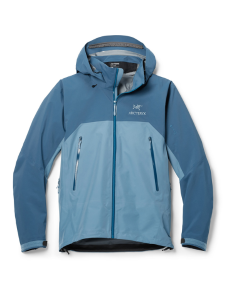
- Hardwearing N80d Most Rugged 3-layer GORE-TEX Pro reinforces high-wear areas
- Helmet-compatible hood with microsuede chin guard
- Taped seams for increased waterproofness
- Longer length for added protection over hips and back
- 2 hand pockets, high enough to use with a harness
- Contains materials that meet the bluesign® criteria
Why we like it: Ridiculously stormproof, keeps wind and water out all day long
What we don't like: Material can feel stiff and is noisy, expensive
Waterproof Membrane: 3-layer GORE-TEX Pro | Length: Hip-length | Ventilation: Pit zips | Weight: 16 oz.
The Arcteryx Beta AR ($600) is our pick for the best overall rain jacket thanks to its incredible weatherproofing, light weight, and durability. Chelsey spent two seasons guiding backpacking trips in some of the wettest Alaskan summers on record in a sub-par rain jacket before she switched to the Beta AR. She hasn't looked back since and wouldn't dream of relying on any other jacket to keep her warm and dry in the worst weather, whether she's backpacking or climbing.
The Beta AR features an incredibly waterproof GORE-TEX Pro Most Rugged membrane and taped seams, keeping water out in even the rainiest conditions. It also has a generous cut and long length, perfect for layering under on those truly heinous days. Pit zips help keep you from sweating in warmer conditions, and the hood fits over most climbing helmets.
The jacket is very comfortable, but the material does feel a bit stiff and is noisy. For that reason, it's better suited to true backcountry wear, and you may want a softer, quieter jacket to wear around town. And, while the price tag may seem steep, we think it's well worth the cost.
Check Women's Price at Arcteryx
Best Value Rain Jacket:
Patagonia Torrentshell 3L
Features: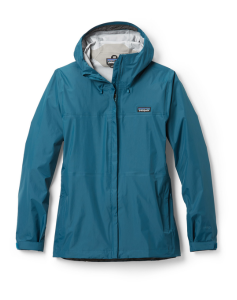
- Three-layer H2No waterproof membrane
- PFC/PFAS-free, 100% recycled nylon fabric
- Adjustable hood that stows away
- Two hand warming pockets; jacket stuffs into the left pocket
- Pit zips for increased ventilation
Why we like it: Sustainable and well-priced
What we don't like: Stiff, plastic-y feeling fabric, no chest pocket
Waterproof Membrane: H2No® Performance Standard 3-layer shell | Length: Hip-length | Ventilation: Pit zips | Weight: 14 oz.
The Patagonia Torrentshell 3L ($179) features a three-layer H2No waterproof membrane at an incredible value. The three-layer construction is weatherproof and durable, keeping you dry for years to come. The lining is also a soft tricot, increasing comfort and preventing the clamminess that you usually feel while wearing a wet rain jacket. The jacket features an adjustable hood that you can stow away, as well as pit zips and two pockets.
The Torrentshell is also PFC-free and made of 100% recycled nylon ripstop fabric, with Fair Trade sewing. The fabric does feel stiffer and crinklier than softer jackets like the Rab Alpine Kinetic 2.0. However, it's by far the most affordable, 3-layer rain jacket in this guide and well worth the investment.
Best Ultralight Rain Jacket:
Outdoor Research Helium
Features: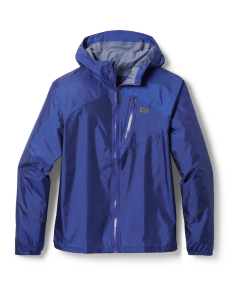
- 2.5 layer fabric with taped seams for increased weatherproofing
- Adjustable hood, with an elastic hem and elastic cuffs to seal out moisture
- Zipped chest pocket that doubles as a stuff sack
- Reflective logo and forearm overlays
Why we like it: Ultralight, affordable, relatively durable
What we don't like: Doesn't breathe well, very few features
Waterproof Membrane: 2.5-layer Pertex Shield Diamond Fuse | Length: Hip-length | Ventilation: None | Weight: 6.3 oz.
The Outdoor Research Helium ($170) is our pick for the best ultralight rain jacket. Pertex's Diamond Fuse fabric is durable and tear-resistant while still being incredibly lightweight. At 6.3 ounces, the Helium is half the weight of other jackets in this guide and stuffs into its own chest pocket. The light weight is also accomplished by streamlining the jacket; the Helium doesn't have many features, but the ones it does are well thought out. An adjustable hood, elastic hem, and elastic cuffs help seal out moisture, while a reflective logo and forearm overlays are a great addition for road runners.
While this jacket doesn't have the same weatherproofing as a true 3-layer rain jacket, it can manage light to moderate rainfall, making it a great option as an emergency rain jacket or for running the rain. Just remember that heavy downpours will overwhelm the fabric, and leave it sticking to your skin. There also aren't any pit zips to help you shed heat when the temperatures rise.
Most Comfortable Rain Jacket:
Rab Kinetic Alpine 2.0
Features: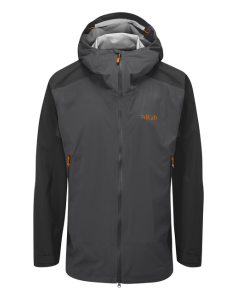
- Recycled stretch-knit Proflex
 fabric
fabric - Nylon woven Proflex panels in the hips, arms, shoulders, and hood handle abrasion and exposure
- Helmet-compatible hood with front and rear adjustments
- Designed for alpine climbing and mountaineering
Why we like it: Comfortable, stretchy, soft against the skin
What we don't like: No pit zips, not as waterproof as other jackets
Waterproof Membrane: 3-layer waterproof | Length: Hip-length | Ventilation: Core vents | Weight: 14.9 oz.
The Rab Kinetic Alpine 2.0 ($310) is the jacket that almost made this buyer's guide impossible to complete. Not because it was so bad - because it was so good. The Kinetic Alpine is so ridiculously comfortable that Chelsey had a hard time taking it off to test any of the other rain jackets. The soft fabric feels more like a softshell than a rain jacket, and the relaxed fit means you can easily layer underneath it.
As stated in the name, the Alpine 2.0 was designed for alpine adventures. The two hand pockets are placed high, allowing you to access them while wearing a harness, and adjustable cuffs will fit over most gloves. The hood is helmet-compatible and adjustable, and woven panels in the hips, arms, shoulders, and hoods increase the jacket's durability where it needs it most. The Alpine 2.0 isn't the most waterproof option in this buyer's guide, however, and is better suited to light to moderate rain than a true downpour. It also doesn't have any pit zips.
About our testing process
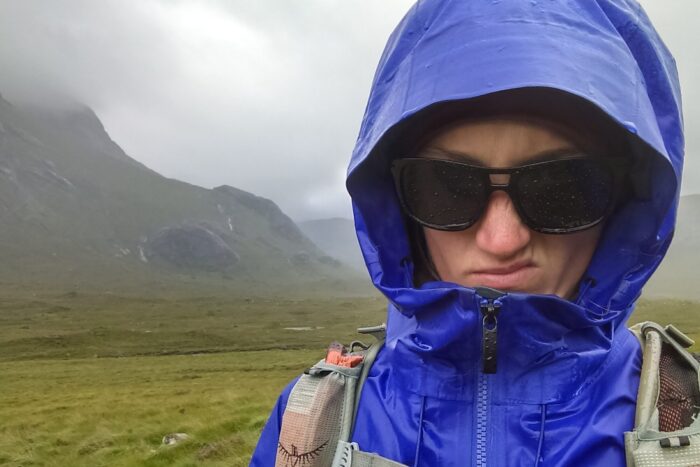
The ExplorersWeb team has tested over a dozen rain jackets, from ultralight running jackets to technical hard shells designed for the alpine. Gear Editor Chelsey Cook began this guide in July 2024. She has over twenty years of experience hiking, backpacking, and mountaineering, and relies on rain jackets to keep her dry and happy in the backcountry. Chelsey has had the pleasure of living in the Pacific Northwest, renowned as one of the wettest places in the world during the winter. She also frequently travels to Scotland, England, and the Faroe Islands, famously rainy places, and guided backpacking trips through two of the wettest Alaskan summers in recent memory. A rain jacket is a standard part of any outfit she wears, and she's extensively tested numerous brands and styles.
Chelsey tested the rain jackets in this guide while backpacking in Alaska's Arctic, trekking the Salkantay Trail to Machu Picchu in Peru, guiding volcanoes in the Pacific Northwest, and wearing them in her day-to-day life in Alaska. She tested their versatility while running, backpacking, and skiing and their durability by climbing and scrambling over rocks. Chelsey also wore them in different climates, from the warm temperatures near the equator to the frigid cold of the Alaska Range.
She looked for rain jackets with different fits and purposes, as well as value rain jackets, technical rain jackets, and ultralight rain jackets. This guide will continue to grow and change as we test new rain jackets.
Things to consider when buying rain jackets
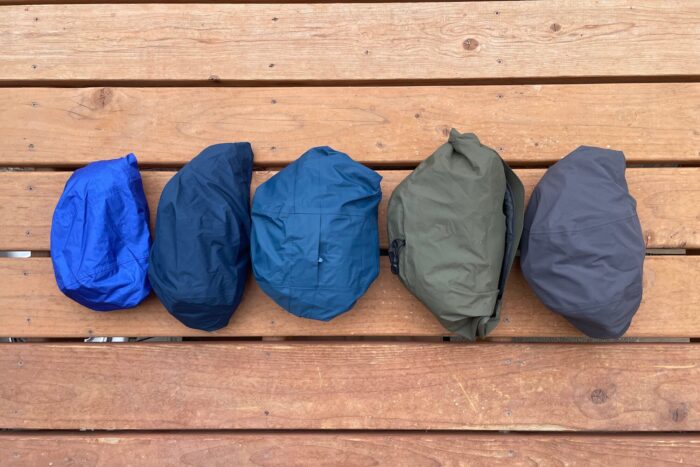
Waterproofness
When shopping for outdoor gear, you'll see terms like "water-resistant" and "waterproof". Water-resistant jackets will shed water in light rain and are often breathable, but they aren't completely waterproof or suitable as rain jackets. Waterproof jackets, on the other hand, have a built-in laminate layer or coating that blocks outside moisture from entering. They also have taped seams for increased waterproofing.
Forever chemicals, known as PFAS or PFCs, were frequently used to make fabric waterproof and water-resistant. However, they have been linked to long-term health effects, and many states are beginning to ban their use in textiles. Rain jackets like Patagonia Torrentshell 3L are already PFAS-free.
Breathability
Breathability is key in a rain jacket. Without it, you'll feel more like you're wearing a garbage bag than a rain jacket. Not only is this uncomfortable, but your sweat also has nowhere to go and will leave you cold and clammy, defeating the purpose of the rain jacket. Lower-end rain jackets generally aren't as breathable as higher-end ones; the Rab Kinetic Alpine 2.0 is by far the most breathable rain jacket we've tried, but also not the most budget-friendly.
Some jackets have also increased their breathability by adding ventilation options, like pit zips. These are a great way to dump heat in warmer conditions or while working hard.
Fabric layers
Rain jackets typically consist of a combination of layers, which not only make them waterproof but also let sweat and hot air out. Rain jackets come in 2, 2.5, and 3 layers. Rain jackets with 2 layers are the most basic and generally have a mesh liner to protect the jacket's inner coating. They're not very breathable and, because of the mesh, are often bulky and heavy. They are, however, budget-friendly and are a great entry-level option, especially for the frontcountry. We didn't feature any in this guide.
A 2.5-layer rain jacket, like the Outdoor Research Helium, has a thin interior fabric attached to the waterproof coating. This makes them more lightweight and compressible than a 2-layer jacket.
A 3-layer rain jacket has three separate fabrics: a waterproof membrane, a breathable membrane, and then an interior fabric. They're more bulky than 2.5-layer jackets, but also more durable, more comfortable, and wick moisture better. They're also the most expensive, but well worth the cost if you'll be spending a lot of time in your rain jacket.
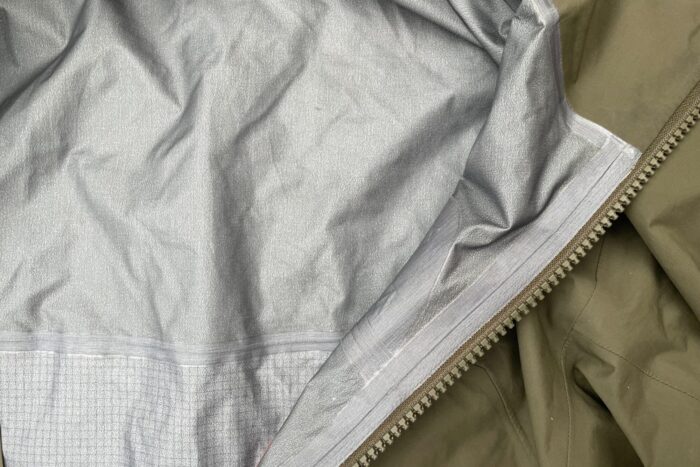
Weight
Most of the full-size rain jackets in this guide weigh around one pound, which is pretty standard. Lightweight jackets, like the Outdoor Research Helium, weigh only half that; however, they don't offer as much protection or features. Generally speaking, the more durable and feature-laden the jacket, the more it will weigh. The Arcteryx Beta AR is the heaviest jacket in this guide, and it's also the most durable and waterproof. While it's a great option for long trips and bad weather, it (and its weight) may be overkill for many day hikes or good weather days.
Features
Most rain jacket features come down to pockets, hoods, and ventilation. Rain jackets typically have at least two hand-warming pockets, and some may have an additional chest pocket. Ultralight jackets, like the Outdoor Research Helium, may have no hand pockets to save weight. If you plan on wearing your rain jacket with a climbing harness, look for one with a chest pocket, or hand pockets that are placed higher up, so you can still access them while in harness.
A good hood is a big factor in helping keep the rain out. Rain jacket hoods are typically adjustable; if you plan on wearing your rain jacket in truly stormy weather, look for one with a visor to keep the rain out of your face and a high collar. If you plan on wearing your rain jacket with a helmet, make sure the hood is helmet-compatible.
Lastly, some rain jackets have vents to help you shed hot air when you're working hard. Common venting solutions are pit zips, side zips, and core vents. Jackets in this guide only have pit zips. If you plan on sweating a lot or live in a warm, humid place, consider getting a rain jacket with venting options.
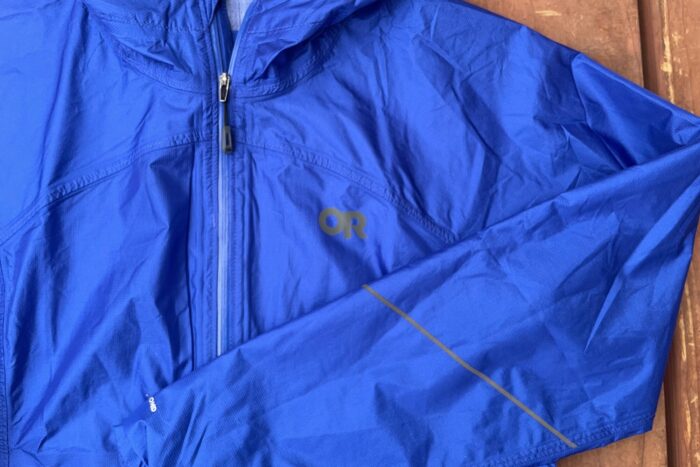
Frequently asked questions about rain jackets
What is the best waterproof rain jacket??
While we think that the Arcteryx Beta AR is the best waterproof rain jacket, the best one for you is one that fits your needs and budget and is comfortable to wear. When choosing the right rain jacket for you, consider waterproofing, features, fit, weight, and durability.
My jacket lost its waterproofing. What happened?
Waterproof membranes slowly degrade over time and can be negatively affected by sweat and dirt. If your rain jacket doesn't seem as waterproof as it used to be, try cleaning with with a detergent made for waterproof fabric, and re-waterproof it with a new DWR finish, with a product like NikWax.
When do I need to take a rain jacket hiking?
Personally, Chelsey always carries a rain jacket when hiking, even if the weather calls for sun. Rain jackets are not only great for keeping the wet out, but they also are good wind layers and an important emergency item if the worst should happen. If you live in an area that is rarely rainy, consider carrying a lightweight rain jacket like the Outdoor Research Helium. At just over 6 ounces, you'll hardly notice it in your pack until you need it.
While you may be able to get by with just protein bars and trail mix on a backpacking trip, there's nothing quite like a hot meal at the end of a long day. There are dozens of stoves out on the market that can get the job done, and picking the right one can be daunting. That's where we come in.
Gear Editor Chelsey Cook has over 20 years of experience backpacking and has spent six years working as a professional mountain guide in Alaska. She cooks over a backcountry stove for over a third of the year, whipping up meals for up to 10 people in all sorts of conditions, from epic snowstorms on Denali to endlessly rainy backcountry trips in Alaska's Arctic. She has experience with almost every backpacking stove on the market and knows the importance of having a reliable, easy-to-use stove that's designed for your needs and weather conditions.
She put the stoves in this guide through their paces, cooking with them at 17,000 feet, brewing her morning coffee while on the road, and making carbonara for 10 under a tarp while a storm raged outside. Throughout her testing process, she considered boil time, weight, reliability, and their ability to function in harsh weather.
Our Picks for the Best Backpacking Stoves
- Best Overall Canister Stove: MSR Pocket Rocket Deluxe
- Best Overall Liquid Fuel Stove: MSR Whisperlite International
- Best Budget Backpacking Stove: MSR Pocket Rocket 2
- Best Backpacking Stove System: Jetboil Flash Cooking System
- Best Stove for Windy Conditions: MSR Reactor Stove System
- Best Stove for Expeditions: MSR XGK EX Multi-Fuel
- Best Stove with Simmer Control: MSR Dragonfly
- Best Alternative Fuel Stove: Solo Stove Lite
Best Overall Canister Stove:
MSR Pocket Rocket Deluxe
Features:
- MSR's lightest, smallest stove, made for ultralight backpacking
- Push-start ignition doesn't require a lighter
- Precision flame that goes from torch to simmer
- Broader burners improve wind resistance
Why we like it: Ultralight and packable, quick boil time for the size
What we don't like: Best for small pots, very little wind protection
Fuel type: Canister | Burn time: 60 min. per 8 oz. canister | Time to boil 1L water: 3.3 min. | Weight: 2.9 oz.
MSR's iconic Pocket Rocket stove has been a favorite among backpackers for over 20 years, thanks to its miniscule size and comparatively powerful output. Chelsey has been cooking with the Pocket Rocket on backpacking trips for over 10 years and even keeps one in her truck to boil water for roadside coffees on her long Alaskan drives. MSR upped the ante with their Pocket Rocket Deluxe ($85), adding a piezo lighter to their tried-and-true Pocket Rocket 2 for easier ignition. The burner is also broader on the Deluxe, spreading the flame rather than concentrating it under the pot. This doesn't affect the boiling time (the Deluxe still boils water faster than the Pocket Rocket 2) and lets you cook real food without scorching it. MSR also added a small lip to the burner, increasing wind resistance.
The updates only add 0.3 ounces to the Pocket Rocket Deluxe, over the Pocket Rocket 2, and the stove still fits in the palm of our hands. It's ridiculously easy to use, especially with the piezo lighter, and our pick for the best canister stove for almost all of your needs, from backpacking trips to day hikes to quick roadside hot drinks.
Best Overall Liquid Fuel Stove:
MSR Whisperlite International
Features:
- 20 years of proven field use
- Folds down and fits inside most MSR pots
- Rugged stove with self-cleaning Shaker Jet
 technology
technology - Capable of burning white gas, kerosene, and auto fuel
Why we like it: Reliable, durable, burns most fuels
What we don't like: Prone to carbon build-up, doesn't simmer well
Fuel type: Liquid | Burn time: 1 hr. 50 min. per 20 oz. white gas | Time to boil 1L water: 3.5 min., white gas | Weight: 11.2 oz.
The MSR Whisperlite has long been the best-selling liquid fuel stove. The MSR Whisperlite International ($160) offers the same reliability, with the incredible versatility of being able to burn white gas, kerosene, and auto fuel. We've used the Whisperlite International on Denali, on thru-hikes, and in the Andes of Peru, and we love its reliability, durability, and easy field maintenance
It is significantly more expensive than most canister stoves (and the price doesn't include a fuel bottle), but the price is well worth it if you require a stove for cold temperatures, longer backpacking adventures, or international trips. You also won't have to replace your Whisperlite anytime soon, so it's money well invested. Chelsey's been dragging the same Whisperlite around for over 15 years and it still fires right up. Just keep in mind that, like any liquid fuel stove, there's a bit of a learning curve to using it. It also requires some basic stove maintenance and upkeep to keep it running well, but it is easy to disassemble and clean right in the field.
Best Budget Backpacking Stove:
MSR Pocket Rocket 2
Features:
- Precision flame control that goes from torch to simmer
- WindClip® windshield boosts efficiency in breezy weather
- Folding pot supports make for a tiny packed size
- Comes with an ultralight, hard-carry case
Why we like it: Reliable, ultralight, easy to use
What we don't like: Lacks some of the features of the Deluxe, like the push-start ignition and broader burner
Fuel type: Canister | Burn time: 60 min. per 8 oz. canister | Time to boil water: 3.5 min. | Weight: 2.6 oz.
The MSR Pocket Rocket 2 ($50) was Chelsey's go-to canister stove right until she got an MSR Pocket Rocket Deluxe. Reliable and lightweight, the Pocket Rocket 2 has been the classic canister stove for years and is beloved by thru-hikers, alpine climbers, and first-time backpackers alike. It's also surprisingly affordable, at less than half the price of a Jetboil Flash Cooking System, and considerably cheaper than the Pocket Rocket Deluxe.
This low price point means that the Pocket Rocket 2 doesn't have many frills or features. There's no push-start ignition or integrated pot. But it boils water fast, packs down to a tiny size, and is the lightest non-alternative fuel stove in this guide. No frills also mean it's easy to use (making it a great choice for first-time backpackers), and very little can go wrong with it. Chelsey's been using the same Pocket Rocket stove around for 10 years, tossing it in backpacks and truck beds, and it has yet to fail her or require maintenance.
Best Backpacking Stove System:
Jetboil Flash Cooking System
Features:
- Includes a 1L insulated cooking cup
- Push-button igniter eliminates the need for a lighter
- Color-change heat indicator lets you know when water's ready
- Compatible with other Jetboil products, like a coffee press and skillet
- Includes fuel canister stabilizer
Why we like it: Easy to use, integrated, insulated pot, quick boil time
What we don't like: Relatively small pot
Fuel type: Canister | Burn time: 42 min. per 8 oz. canister | Time to boil 1L water: 4.2 min. | Weight: 13.1 oz.
The Jetboil Flash Cooking System ($130) is one of the most popular stove systems amongst backpackers, especially newer backpackers, and with good reason. Everything you need for camp cooking, besides the canister, comes with the system, including a stove, pot, stand, cup, and lid. All of it nests easily together and weighs under a pound. It's also ridiculously easy to use, with a push-button igniter, a pot that locks firmly onto the stove, and a heat-indicating sleeve that lets you know when water is boiling, helping prevent dangerous boil-overs and fuel waste.
The main downside is that you're constrained to cooking what you can fit in the integrated, one-liter pot. This isn't too much of an issue if you're cooking for one or two, and mostly eating freeze-dried meals, but you'll want a different stove if you're cooking for a larger group.
Best Stove for Windy Conditions:
MSR Reactor
Features:
- Integrated stove and cookware system, with different-sized cookware available
- Outperforms most stoves when boiling water, boiling 0.5L in 1.5 minutes
- Heat exchanger encloses burner, eliminating effects of most wind
- Stove and fuel canister nest inside the pot
Why we like it: Incredible wind protection, simple to use
What we don't like: Expensive, pot doesn't fit snugly on the stove
Fuel type: Canister | Burn time: 80 min. per 8 oz. canister | Time to boil 1L water: 3.5 min. | Weight: 14.9 oz., with 1L pot
The MSR Reactor ($309 for 2.5 L) is one of the fastest, most fuel-efficient stoves on the market, and was specifically designed to withstand windy, harsh conditions. Chelsey brings one on most of her mountaineering trips (though keep in mind, canisters don't fair well below 11˚F) and it's the first thing she fires up in the morning. She appreciates its simple design, fast boil time, and sturdiness in windy conditions when she's trying to get that vital first round of coffee going for her climbing partners. She usually uses the 1L version, but the Reactor also comes in 1.7L and 2.5L versions.
That said, the Reactor isn't the lightest stove system on the market, and don't expect it to operate on anything but "full blast". This stove is designed to boil water fast in windy conditions, and lacks some of the frills, like simmering, that fair-weather backpackers might want. It's a great choice for people venturing into the alpine, or mountaineers and backcountry skiers.
Note: MSR has released a voluntary recall for some of their cooking pots, including the pot that comes with the Reactor. The pot handle can potentially come loose, causing the contents to spill.
Best Stove for Expeditions:
MSR XGK EX Multi-Fuel
Features:
- Trusted by mountaineers for over 35 years
- Nests inside a 1.5L MSR pot
- Retractable legs and supports create a secure platform
- Easy to field maintain; Shaker Jet
 cleans fuel jet with a simple shake
cleans fuel jet with a simple shake - Capable of burning white gas, kerosene, autogas, and diesel
Why we like it: High out-put, built for extreme conditions
What we don't like: Very loud, overkill for most trips
Fuel type: Liquid | Burn time: 1 hr. 49 min. per 20 oz. white gas | Time to boil 1L water: 3.5 min., white gas | Weight: 13.5 oz.
The MSR XGK EX Multi-Fuel ($210) is an absolute snow-melting machine, combining the wind resistance of the MSR Reactor with a liquid fuel system that continues to be a powerhouse in cold temperatures and at high altitudes. It's our stove of choice on winter or glaciated expeditions, where efficiently melting snow for drinking water is crucial. It can also burn white gas, kerosene, auto gas, and diesel, making it a fantastic choice for international expeditions, where your usual fuel source may be hard to come by.
While the EGK is bulkier and a few ounces heavier than the Whisperlite, it packs down to a surprisingly small package thanks to the flexible fuel line and retractable legs. It is impressively loud and doesn't simmer well, thanks to its incredible output, so it's a bit overkill for most backpacking trips. But if you spend a lot of time on snow or at altitude, it's a reliable, powerful stove choice.
Best Stove for Simmer Control:
MSR Dragonfly
Features:
- Dual-valve design for precise simmer-to-boil control
- Extra wide pot supports comfortably hold 10" wide pots and fry pans
- Easy to field maintain; Shaker Jet
 cleans fuel jet with a simple shake
cleans fuel jet with a simple shake - Folds to 1/3 its size and nests within 2L MSR pots
- Burns white gas, kerosene, auto fuel, diesel, and jet fuel
Why we like it: Best simmer control on the market, very stable
What we don't like: Bulky, noisy, and takes some getting used to
Fuel type: Liquid | Burn time: 2 hr. 6 min. per 20 oz. of white gas | Time to boil 1L water: 3.5 min., white gas | Weight: 14.1 oz
The MSR Dragonfly ($190) is our go-to stove for backpacking trips when there's more on the menu than freeze-dried meals. A dual valve design provides incredible flame precision, letting you both simmer complicated meals and boil water. There are also extra wide pot supports, providing stability for large pots and skillets. Chelsey's used a Dragonfly for three seasons of guiding backpacking trips in Alaska and has cooked everything from carbonara to breakfast burritos on it. The pot supports are large enough to easily hold a five-liter pot, letting her cook meals for up to 10 people at a time.
Like most MSR stoves, the Dragonfly comes with a windscreen, a fuel pump, and a field repair kit. It can also use the widest range of fuels in this guide, including white gas, kerosene, auto fuel, diesel, and, incredibly, jet fuel. Like the EGK, it is very noisy when on full power, though significantly quieter when simmering. We also like how the simmer option lets you be more fuel-efficient.
Best Alternative Fuel Stove:
Solo Stove Lite
Features: 
- Ultra-efficient at burning twigs and kindling to create a hot cook fire
- Designed to increase airflow, making it easy to start and maintain fires
- Double-walled design reduces smoke
- Lifetime product warranty
Why we like it: Doesn't require you to carry fuel, more sustainable with no canisters to recycle
What we don't like: Stove itself gets very hot, making it hard to pack away, and requires effort upfront to find fuel
Fuel type: Wood, alcohol | Burn time: Endless, depending on wood/alcohol supply | Time to boil water: 8 to 10 min. | Weight: 9 oz.
The Solo Stove Lite ($70) is a great option for those looking for a lightweight alternative fuel stove. The stove burns small sticks and twigs for fuel, and the design not only increases airflow but also reduces smoke, making it a painless, easy stove to use even for beginners. It's also relatively light, especially considering you don't have to carry any fuel with you to use it. The flame isn't quite as hot as those produced by other backpacking stoves in this guide, so cooking times will be a bit longer.
Keep in mind that you'll need a substantial pile of sticks to cook with. If you'll be backpacking somewhere that doesn't have a lot of wood available, like the desert or the tundra, you may want to pair your stove with the Solo Stove Alcohol Burner ($20). The Alcohol Burner runs off denatured alcohol and nests inside the Solo Stove Light. It also has a flame regulator for more precise cooking.
About our testing process

The ExplorersWeb team collectively has untold decades of experience cooking meals in the backcountry, both for themselves and the hundreds of clients they've guided throughout the world. From quick and easy meals on a thru-hike of the Scottish Highlands to elaborate, multi-course meals made from scratch in Utah's canyons, they know their way around a backpacking stove and have extensively used most stoves on the market these days.
Gear Editor Chelsey Cook started this guide in June 2024. She's been a professional mountain guide in Alaska, Washington, Peru, and Tanzania for over six years and has been backpacking and mountaineering for two decades. She's cooked just about every meal on every stove at this point and routinely has to cook carbonara, hashbrowns, and skillet scrambles for up to 10 hungry guests. As a mountaineering guide, she's also spent an incredible amount of time cooking at high altitudes, in winds gusting to 40mph and temperatures as low as -30˚F. As a Denali guide, she likes to joke that she's actually a professional snow melter; on a busy day, she spends upwards of four hours in front of a stove, making water for climbers. And it's not all work. When Chelsey isn't on the clock, she's cooking herself elaborate meals in the backcountry (including, famously, a chicken pot pie from scratch during a three-week canyoneering trip), or brewing herself some coffee with her Pocket Rocket while on the road.
Safe to say, she knows a good stove when she sees — or hears — one, and is always looking for the best stove to suit her needs. Above all, she values durable, fuel-efficient stoves that can put out a lot of power when needed.
Chelsey has decades of experience with most of the stoves on this list. She's spent a dozen years cooking with her Whisperlite (she still uses her original stove), over seven years with the Reactor and XGK EX, three seasons of backpack guiding with a Dragonfly, and well over a decade using Pocket Rockets for her daily coffee when living in her van. Beyond her field experience, she also put the stoves through their paces at home, evaluating their packability, burn time, how fast they boiled water, and how easy they were to use.
Things to consider when buying a backpacking stove

Type of stove and fuel
Canister: Canister stoves, like the MSR Pocket Rocket Deluxe, screw directly into a fuel canister that is filled with a mix of isobutane and propane. They are extremely easy to use and generally don't require much maintenance. However, because the canisters can't be refilled, they are very wasteful and can become bulky on longer backpacking trips with higher fuel needs. Canisters also don't do well in the cold, as isobutane loses significant performance below 11F.
Liquid fuel: Liquid fuel stoves, like the MSR Whisperlite International, connect to refillable fuel bottles. They generally run off white gas, though some stoves can also operate on gasoline and kerosene. This makes them a great option for international travel, as canisters are often hard to find in remote areas. They're also great for cold temperatures, as white gas will burn down to -40˚F. Liquid fuel stoves are often a bit finickier to use than canisters; most require priming before lighting them, and they are more prone to needing maintenance. Most come with a stove repair kit, and we recommend carrying it with you on your trips and teaching yourself basic stove maintenance.
Alternative fuel: This ever-growing category of stoves runs on different materials, from alcohol to fuel pellets to wood. If you choose an alternative fuel stove, make sure the fuel is readily available in the area you're backpacking (for instance, don't use a wood-burning stove in the Alaskan tundra), and that you've practiced with the fuel before heading out into the backcountry.
Integrated versus non-integrated canister systems

Some canister stoves come with integrated cooking pots. The burner screws into the fuel canister, and then a twist-on cooking pot fits onto the burner. Examples include the Jetboil Flash Cooking System and the MSR Reactor. These stoves are incredibly easy to use and are designed to boil water quickly and efficiently. However, they're also heavier and more prone to tipping than non-integrated canister stoves. Depending on the brand, they may not be compatible with a wide range of other pots and skillets, limiting the function of the stove if you lose the included pot, or want to cook using a frying pan.
Size and weight
The stoves in this guide weigh anything from under 3 ounces to nearly a pound. Some can fit in the palm of your hand, while others are the size of a softball or larger.
Integrated canister stoves are often the bulkiest options. However, you can generally nest the burner and canister inside the integrated pot. Liquid fuel stoves like Whisperlites and Dragonfly also take up more space, though their legs collapse into each other, and they have flexible fuel lines that you can tuck in. We usually store them in their stuff sack and then put them inside our pot to keep them safe and compact.
Smaller stoves are great for backpackers who are interested in cutting ounces, while larger stoves are often better suited for harsh conditions and cooking for large groups.
Intended cooking purpose
The type of cooking you'll be doing in the backcountry will affect your choice of stove. If all you're interested in is boiling as much water as fast as possible to rehydrate backpacking meals, a stove like the MSR XGK EX Multi-Fuel, the MSR Reactor, or the Jetboil Flash Cooking System may be the choice for you. They'll put out a ton of heat, boiling your water quickly and efficiently. Don't expect them to have a lot of finesse, though.
If you prefer more complex backcountry meals that involve cooking ingredients at low heat or different heat, you'll want a stove that has a simmer function, like the MSR Dragonfly or even the MSR Whisperlite International. We've managed to cook scrambles, noodle stir-fries, pot pies, quiches, and pancakes on both stoves.
Performance in harsh conditions
If you're mostly a fair-weather backpacker, a stove like the MSR Pocket Rocket Deluxe is likely plenty for your trips. You can also always couple it with a windscreen in harsh conditions. However, if you frequently backpack in cold winter conditions or above tree-line or are a mountaineer, you're going to want a stove that can handle the elements. Remember, if you're going to be in conditions regularly below 10˚F, don't bring a canister stove. And, if your canister does freeze, never try to heat it with another stove or strong heat source. Canisters have and will explode by doing this.
The tried and true stoves for trips up Denali and in Alaskan winters are the MSR Reactor, the MSR XGK EX Multi-Fuel, and the MSR Whisperlite International.
Backpacking Stove Advice

Liquid fuel or canisters?
If you're heading out on a quick backpacking trip in moderate temperatures, a canister stove like the MSR Pocket Rocket Deluxe is likely the simplest, most efficient stove for the job. Canister stoves are very user-friendly; simply connect the stove to the canister, light it, and start cooking. They can also boil and simmer and are lightweight and compact.
However, they do have their drawbacks. Canister stoves don't excel in cold weather, and the canister itself is bulky, which can be a problem if you need to carry fuel for an extended backpacking trip. You also can't fly with canisters, and they can be hard to find in some countries.
We recommend using a liquid fuel stove, like the MSR Whisperlite International, for cold-weather trips, trips that are longer than a week, and international trips. Liquid stoves take some getting used to; they take more set up than canister stoves, require priming, and often need field maintenance with long-term use. They're also bulkier, heavier, and more expensive than canister stoves. However, they can burn a variety of fuels — everything from white gas to auto gas to jet fuel — all of which do a lot better in the cold than isobutane and are far more readily available internationally and in remote areas. You can also purchase liquid fuel in bulk, reducing your waste and making it easy to top up your fuel bottle. Just make sure you play with your new liquid fuel stove before taking it to the backcountry, and keep a basic stove repair kit with you.
Cooking at altitude and in the cold
There's a reason you don't see many canister stoves when climbing Denali; with altitudes reaching over 20,000 feet and temperatures generally well below 10˚F, canister stoves are mostly ineffective on the upper mountain. Instead, climbers choose to use liquid fuel stoves, as white gas and other liquid fuels continue to work long after isobutane quits from the cold. The fuel pumps on liquid fuel stoves also let you regulate the pressure of your fuel bottle, ensuring you have a strong flow of fuel to the stove. Canisters often depressurize in the cold or at high elevations, providing a weak flow to your stove.
Cooking will always, unfortunately, be slower at high altitudes. Water has a lower boiling point at higher elevations, so you'll need to compensate by increasing cooking time. Chelsey likes to give her meals a boost by using high-powered stoves like the MSR XGK EX Multi-Fuel, and will often stick two to three stoves under one large pot when she's cooking for larger groups. If you're cooking on snow, keep in mind that your stove will naturally melt the snow around it and could create an unstable surface. Chelsey generally brings a small, thin piece of wood, known as a stove board, to put under her stove when cooking on snow.
Wind resistance and windscreens

Wind and backpacking stoves do not get along. Strong winds can tip over your stove system and put out your burner altogether. Windscreens, often sold separately, are vital if you'll be cooking in windy conditions. They're lightweight, bendy metal screens that you can wrap around your stove to protect it from gusts and speed up your water boiling time.
If you frequently cook in gusty conditions, you may want to purchase an integrated stove system like the MSR Reactor. In integrated stove systems, very little of the stove is exposed, and you won't need a separate windscreen to protect it. Avoid alcohol and wood-burning stoves, as it can be extremely hard to get a consistent flame from them in windy conditions.
Staying safe while cooking
Believe it or not, one of the most common injuries in the backcountry is a scald from spilling hot water. To keep yourself and your partners safe, follow basic stove safety when cooking in the backcountry.
- To avoid tipping over, set your stove up and cook in the flattest place possible. Flat rocks are a great choice.
- Don't overfill your pot, and watch out for the water boiling over.
- Never grab a pot with your bare hands. Many pots come with pot grippers or handles; make sure you use them.
- Never cook inside your tent or vehicle. Carbon monoxide poisoning is a silent killer, and the deadly gas can easily build up in small, enclosed spaces without warning. If you're often backpacking in wet conditions. consider carrying a small tarp for a kitchen shelter.
Calculating Fuel
Determining how much fuel you should bring on a backpacking trip is an important part of your trip planning. You'll need to consider the length of the trip, the number of people, the altitude and weather, and what you'll be using the stove for and how frequently. How efficient your stove is also plays a part. As a baseline, bring at least 1.5 ounces of fuel per person per day on most backpacking trips. As you learn your stove and your fuel needs, you'll be able to dial this to your own specific cooking needs.
If you'll be cooking at altitude or in cold temperatures, and especially if you'll be melting snow for drinking water, you'll have to bring even more fuel per person. Alaskan outfitters recommend at least 2 oz of white gas per person per day during the Denali season, but on midwinter arctic expeditions, when you might be melting -40˚snow instead of 0˚F snow, you'd need even more.
It is always better to have fuel left over at the end of a trip rather than run out. This is especially true on remote backcountry trips that require a bush plane pick-up. Weather often shuts down flights, and you may end up staying in the backcountry longer than you expected, waiting on a weather window!
Recycling canisters
One of the biggest downsides to canister stoves is how difficult canisters are to dispose of, let alone dispose of sustainably. Canisters, unlike fuel bottles, are a one-use-only item and can't be refilled. You can, however, transfer fuel from one to another using something like the FlipFuel. The FlipFuel lets you consolidate your used canisters together, so you're not left with a bunch of half-used canisters at the end of the backpacking season.
It is possible to recycle canisters, though it isn't easy. You'll have to empty the canister completely and then puncture it with a sharp object like a screwdriver. Most curbside recycling programs don't handle mixed metal, let alone fuel canisters, so you'll have to drop them off a a mixed metal recycling center. For more information, check out MSR's recycling guide.
Flying with Backpacking Stoves
If you're going on an international trip, chances are you're going to want to bring your backpacking stove with you. TSA allows backpacking stoves in carry-ons and checked bags, as long as they are empty of fuel and thoroughly cleaned of all residue and fuel vapors.
You won't be able to fly with canisters, but you can fly with clean, empty liquid-fuel bottles. If you're taking a bush flight into the backcountry, most air taxis let you fly with full liquid-fuel bottles that are properly sealed with their caps, not their fuel pumps. Be sure to talk to the individual air taxi about their specific policies.
Frequently asked questions about backpacking stoves
How is a backpacking stove different from a camping stove?
Backpacking stoves are smaller, lighter, and more packable than camping stoves, and are designed primarily to boil water. They are also less stable than camping stoves and often have a slight learning curve because they are quite different than your cooktop at home.
What type of stove is best for backpacking?
Canister stoves are ideal for shorter backpacking trips that don't require much cooking. Canister stoves are also generally easier to operate than liquid fuel stoves. If you're going on a longer trip or will be operating your stove in very cold conditions, a liquid-fuel backpacking stove like the MSR Whisperlite International is the way to go.
Can I cook inside my tent?
We don't recommend cooking inside of your tent, as backpacking stoves produce deadly carbon monoxide. There have been numerous injuries and deaths from carbon monoxide poisoning due to cooking inside a tent. If you absolutely must cook inside your tent, only do so in the vestibule, and ensure that you have the door unzipped and the most ventilation possible.
A pocket knife should be strong and versatile, but compact enough to carry easily. It should cut rope, carve stakes, clear brush, and help with food prep. It should also be durable.
There is no single, perfect pocket knife to meet all these needs. However, there are quite a few options that might be right for you. We tested a variety of pocket knives for over three seasons, while camping, backpacking, foraging, and fishing. We wanted to ensure that our tested models had been put in various situations and they were suitable for all sorts of camping, backcountry, and everyday uses. Our focus was on quality and versatility, but we also paid special attention to ergonomics and size.
Without further ado, here are some of the best pocket knives on the market.
Editor’s Note: We updated this guide on July 25, 2024, to announce the Smith & Wesson Extreme Ops Folding Knife as the Best Budget Pocket Knife. We also included new categories for the Best Pocket Knife for Climbing and Best River Knife.
Our Picks for the Best Pocket Knives
- Best Overall Pocket Knife: Benchmade Bugout
- Best Budget Pocket Knife: Smith & Wesson Extreme Ops Folding Knife
- Most Versatile Pocket Knife: 5.11 Ferro Knife
- Best Pocket Knife for Climbing: Petzl Spatha Knife
- Best Boating Knife: NRS Pilot Knife
Best Overall Pocket Knife:
Benchmade Bugout
Features:
- Incredibly lightweight, without compromising durability
- Ergonomic, textured grip that is fully ambidextrous
- Reversible clip with a lanyard hole for versatile carrying options
- Benchmade offers free sharpening services for life
Why we like it: Durable, lightweight, and versatile
What we don't like: Expensive
Overall length: 7.5 in. | Blade length: 3.3 in. | Blade steel: CPM-S30V Premium Stainless Steel | Handle material: Grivory | Lock type: Axis lock | Weight: 1.9 oz.
The Benchmade Bugout ($180) is a power-packed knife in a pocket knife package. Kirby has had this knife for years and uses it for camping, backpacking, gear repairs, foraging, and more. It’s razor-sharp to this day, comes backed by an incredible company, and the Grivory handle is highly textured.
The blade length is a bit short at 3.24 inches, but that makes this versatile knife more discreet and easy to tuck into a pocket, bra, sleeve, or bag. While you won’t be splitting wood with it, it works well for food prep and easy tasks around camp. Benchmade is a leading knife manufacturer, known for its quality knives and premium steel. The Benchmade Bugout is backed by their warranty and their LifeSharp Services. They'll resharpen your knife to a factory edge for free, for the knife's lifespan. Read our in-depth review of the Bugout here.
Best Budget Pocket Knife:
Smith & Wesson Extreme Ops Folding Knife
Features:
 Double-edged, partially serrated blade
Double-edged, partially serrated blade- Ambidextrous thumb knobs
- Finger flipper for easy opening
- Aluminum handle with jimping for better grip
- Pocket clip for carrying
Why we like it: Affordable, versatile, easy to access and use
What we don't like: Blade deployment can be slow
Overall length: 7.1 in. | Blade length: 3.1 in. | Blade steel: 7Cr17MoV black oxide stainless steel | Handle material: Aluminum | Lock type: Liner lock | Weight: 3.5 oz.
The Smith & Wesson Extreme Ops Folding Knife ($22) is an impressive little pocket knife for its price point. It's an aggressive-looking knife, but it doesn’t sacrifice function for some silly notion of looking "extreme." It’s a beautifully balanced pocket knife, with a 3.1-inch blade fashioned from 7Cr17MoV black oxide stainless steel. The blade is double-edged, with a partially serrated blade that makes it a great choice for both push cuts and small sawing cuts. You’ll have no trouble cutting either tinder or a block of lunch cheese.
The handle is made of aluminum. While it's not the most durable metal, it is lightweight and fits well in your hand. There's also a snug pocket clip for easy carry. The blade is held with a liner lock, which can be difficult and sluggish to open. However, for just over $20, there's no real reason not to buy this knife, particularly if you're new to pocket knives or only use them occasionally.
Most Versatile Pocket Knife: 5.11 Ferro Knife
Features:

- Serrated edge and smooth sharp edge
- Integrated ferro rod with a wrist lanyard
- High visibility coated stainless steel blade
- Teflon protective coating for easy cleaning
Why we like it: Versatile knife with fire-starting capabilities, compact, easy to clean
What we don't like: Carrying case is prone to losing screws, ferro rod takes some getting used to
Overall length: 5.8 in. | Blade length: 2.3 in. | Blade steel: Stainless steel | Handle material: Stainless steel | Lock type: None | Weight: 4.9 oz.
The 5.11 Ferro Knife ($32) is geared toward the survivalist and bushcraft community. Kirby loves having this versatile knife in her arsenal. In addition to the stainless steel blade and serrated blade, there’s an included ferro rod that's capable of producing a 3000˚F spark for fire starting. The ferro rod nests into the handle, and the sheath is designed so you can strike the ferro rod without unsheathing the blade. It does take some practice, however. We recommend learning to use the ferro rod at home before having to rely on it in the backcountry.
The blade itself is Teflon-coated stainless steel, making for seamless cleaning. The blade is a little short, at just two inches long, but that helps keep the overall knife compact. A clipped sheath lets you carry the knife on your belt, though we have noticed some durability issues with the sheath.
Best Pocket Knife for Climbing:
Petzl Spatha Knife
Features: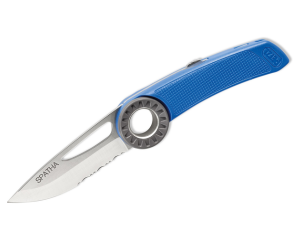
- Hole to clip a carabiner to attach to a harness
- Notch in blade for opening with bare hands
- Textured wheel for opening blade with gloves
- Smooth and serrated blade easily cuts ropes and cordage
Why we like it: Incredibly light, easy to attach to harness, serrated blade section for cutting rope
What we don't like: No locking mechanism when closed, though the blade does lock in the open position
Overall length: 6.9 in. | Blade length: 4 in. | Blade steel: Stainless steel | Handle material: Nylon | Lock type: None when closed | Weight: 1.5 oz.
The Petzl Spatha Knife ($40) is Chelsey's go-to knife for any climbing and mountaineering trips and most of her backpacking trips. The Spatha is a clippable knife that was designed for climbing, with a carabiner hole in the center that lets you easily clip it to your harness or backpack. Chelsey generally carries one on her gear loops, and it is low-profile enough that she doesn't even notice she has it until she needs it. The blade itself is partially serrated, letting you easily cut ropes and cordage, while the straight section is perfect for food prep.
A textured wheel in the center makes the knife easy to open even when wearing belay or snow gloves, and the nylon handle is both lightweight and grippy. The blade doesn't have a lock mechanism to keep it closed but does have a button lock to keep it open. While Chelsey's never experienced the knife opening on accident, the lack of a locking mechanism is something to be aware of.
Best Boating Knife:
NRS Pilot Knife
Features: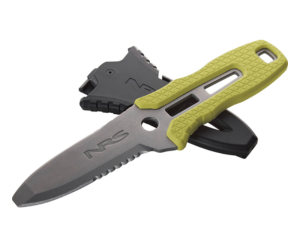
- Quick-release Thumbs Up Sheath
 stashes fixed blades securely and releases with a one-handed flick of the thumb
stashes fixed blades securely and releases with a one-handed flick of the thumb - Partially serrated edge cuts through tough fibers
- Glass-reinforced polypropylene handle with a rubber overlay provides maximum blade control in wet environments
- Oxygen valve wrench in the center of the handle
Why we like it: Durable, purpose-built yet versatile, and easy to access while on the water
What we don't like: Can be difficult to attach to your lifejacket
Overall length: 7.3 in. | Blade length: 3.7 in. | Blade steel: 420 HC stainless steel | Handle material: Glass-reinforced polypropylene with a rubber overlay | Lock type: None | Weight: 4.4 oz.
The NRS Pilot Knife ($50) was purpose-built for professional and recreational freshwater boaters, with rescue in mind. Chelsey uses one for all of her packrafting trips in Alaska, and it lives on her PFD. The blunt tip protects against accidental punctures, especially in a soft boat like a packraft, while the cutting edge has both smooth and serrated sections. The serrated section, with reverse scallop serrations, easily cuts through rope and cordage. The polypropylene handle has a rubber overlay to increase grip in wet conditions.
When not in use, the blade stores securely in its sheath, which fastens to your PFD. While it's difficult to wrangle the sheath onto your PFD, once you get it on it's very secure. The sheath is low profile, with a quick release function so you can release the blade with the flick of a thumb in emergencies. There's also a lanyard attachment at the base of the handle, so you can attach the blade more securely in rough water. Chelsey's never experienced the knife slipping out of the sheath, but it's certainly not impossible, especially given the quick-release mechanism.
NRS also offers a smaller version, the Co-Pilot Knife, with a 2.8-inch blade, as well as a folding version called the Pilot Access Folding Knife. They even offer a titanium version, the NRS Titanium Pilot Knife, for saltwater use. We also tested it around camp and found it useful for prepping food and general use.
Honorable Mentions:
Opinel Carbon Steel Camping Knife
- 3.25in carbon steel blade

- Beachwood handle
- Virobloc safety ring
- Can be exchanged in cases of manufacturing defects
The Opinel Carbon Steel Folding Pocket Knife ($20) provides an excellent cutting edge that stays dangerously sharp for a long time. The Beachwood handle looks simplistic but is surprisingly effective from an ergonomic standpoint. And of course, all Opinel knives sport the Virobloc safety ring which ensures your fingers won’t fall victim to a blade that closes accidentally.
If you want to, you can purchase a sheath that will allow you to carry the knife on your belt. You couldn’t call this a survival knife, but for most tasks around the campsite, it will do the trick. We love this blade, particularly for foraging, and it is an excellent mushroom companion.
Spyderco Tenacious Plain Edge
- G-10 laminated handle

- 8Cr13MoV stainless steel blade
- Four-way pocket clip
The Spyderco Tenacious ($92) sports an 8Cr13MoV stainless steel blade that will more than live up to its responsibilities and an overall balance that is quite good for a folding knife. The blade is 3.39 inches long, and the knife tips the scales at a svelte 4oz.
The handle is comfortable and offset to maximize leverage while inside there are steel liners that work to increase the rigidity of the handle so you can take advantage of that leverage. Great for cutting stakes or cutting steaks.
About our testing process
The ExplorersWeb team collectively has untold decades of testing and reviewing experience under our belts, and both Kirby and Chelsey have been carrying pocket knives for decades. Kirby started this guide in 2022. She's had a pocket knife as an everyday carry item for at least 10 years and has been camping since she was a child. Her dad taught me how to properly handle a sharp blade when she was young, and she enjoys helping others get educated on how to use camping knives safely and responsibly.
Gear Editor Chelsey Cook picked up this guide in July 2024. She lives in a cabin in the Alaskan mountains and has also been guiding backpacking and mountaineering trips for over six years. She uses her pocket knives more than she uses her own kitchen knives and needs a knife that is durable, light, and holds an edge. Chelsey also likes specialized knives for different activities and uses an NRS Pilot Knife for river sports and a Petzl Spatha Knife for climbing.
This guide is for anyone who uses or wants to use a pocket knife. Selecting the best pocket knife is no easy feat, and your needs will vary greatly depending on how you're planning to use your knife — for bushcraft work, processing game, foraging, campsite repairs, food prep, or rescue situations. We've included fixed blades and folding knives, specialized knives for different applications, knives with both straight and serrated edges, and knives of all different sizes.
We selected the best pocket knives after extensive market research and years of testing. We tested our favorite high-quality knives while foraging, camping, and as everyday carry options. Our editor's choice model has spent years as a trusty sidekick to Kirby and has rightfully earned the title of the best pocket knife. Our newer favorites were still put through rigorous testing all over the Pacific Northwest and Alaska, in a variety of weather conditions and terrain.
Features to look for in pocket knives

Knife blade steel
Steel, an alloy of carbon and iron, is the most commonly used material for knife blades because of its hardness and ability to retain an edge. There are an incredible number of different knife steels out there, all created by adding different additives and different finishing processes. New knife steels are coming out every year and can be hard to keep up with. Generally, knife steels are all quite good, though you want to make sure the knife steel you choose meets these requirements.
Wear resistant
Your knife steel should be able to withstand general use wear, including both abrasive and adhesive wear. Wear resistance usually has to do with a steel's hardness, as well as the chemistry of the steel.
Corrosion resistant
You don't want a knife steel that will rust at the first sign of humidity or moisture. Some knife steels are more resistant to water than others, and if you'll be using your knife in wet environments you may want to prioritize corrosion resistance over other factors.
Edge retention
This affects how long the blade will remain sharp after repeated use. While you can sharpen pocket knives, you want your knife steel to hold its edge for as long as possible. This generally comes down to wear resistance and a blade that is not prone to chipping or cracking. Make sure you can easily sharpen your pocket knife too; serrated blades, for instance, are harder to sharpen in the field than straight blades are.

Handle material
While ergonomics play a role in a pocket knife's grip, the material used in the handle, also known as the knife scale, has the greatest effect. You want a material that is durable, lightweight, and grippy in a variety of conditions.
Carbon fiber
Carbon fiber is a polymer that is five times stronger than steel and incredibly lightweight and durable. It's becoming increasingly popular in knife handles because of its strength-to-weight ratio and durability. It's not cheap, however, and knives with carbon fiber handles will be on the pricier end.
Nylon and plastic
Nylon and plastic are durable and lightweight synthetic materials that are popular for knife handles because they are typically textured, offering increased grip. Handles made with nylon or plastic go by a variety of different names, including Grivory (injection molded), GRN (glass-reinforced nylon), GFN (glass-filled nylon), and FRN (fiber-reinforced nylon).
G10 and micarta
G10 and micarta are both composite materials that are created by layering fabric sealed with resin or epoxy and then compressing it under heat. Both materials were designed for their durability and are common in household appliances, including knives.
G10 is nearly waterproof, while micarta is fully waterproof, though more susceptible to dents and dings than G10. Both materials are resistant to temperature extremes and don't become brittle over time.
Aluminum and titanium
Aluminum, particularly anodized aluminum, is lightweight and durable. However, it is a relatively soft material when compared to steel or titanium, and prone to scratches and dents. Titanium, while more expensive, is much more durable and more lightweight.
Wood
Wood was the traditional material used for knife handles. It's durable, provides grip, and is aesthetically pleasing. Hardwoods are ideal, and common types of wood handles include walnut, oak, and maple. Wooden handles do require some maintenance to keep them looking and performing their best; you may need to treat them with oil or wax to prevent them from drying out and to increase their water resistance.
Blade coating
Blade coatings offer a few benefits: they change the look of the knife, as well as make it more durable and resistant to corrosion. Mirror-polished offers great corrosion resistance. Stonewashing hides scratches and is less reflective than other coatings. Bead-blasting gives you a router blade surface that is more prone to corrosion but is not reflective. A satin finish is arguably the most popular and is right in the middle of bead blasting and mirror polishing.
Blade length
For an everyday carry knife (EDC), most people like a medium-sized blade that falls somewhere between 2.5 and 4 inches. This blade length is still versatile enough to handle most tasks while being small enough to carry in your pocket. Different states have different laws restricting knives based on blade lengths. California, for instance, prohibits blades longer than 4 inches in public buildings, while Colorado doesn't allow concealed carry knives of over 3.5 inches. Check with your state's laws before purchasing a knife.
Type of blade point
A drop point blade offers additional strength and control at the tip with a slow curve that lowers the point at the tip of the knife. This makes for an excellent hunting, tactical, and survival knife. A clip point is better for piercing tasks but offers less strength. Spear point knives are great for piercing and stabbing and are often used as throwing knives. When it comes to finding a good knife that can handle heavy-duty tasks, drop-point blades are the primary choice for the best camping knives.
Comfort and ease of use
You want your EDC to be comfortable to hold and easy to use. Otherwise, it's more likely to stay at home rather than ride in your pocket. Handle ergonomics, lock mechanisms, and carry methods all affect how likely you are to use your knife.
Handle ergonomics
The shape and material of the handle scales, the thickness, and the weight all affect how a knife fits in your hand. The handle should be comfortable, grippy, and not fatigue your hand while using. Each person has different preferences, so try to handle as many knives as possible before deciding on your next knife. This is particularly important if you plan on using the knife as an EDC or using it extensively.
Lock mechanism
Folding knives come with different locking mechanisms. The most popular are the liner locks, which use a piece of metal against the tang, frame locks, which use a bar that indexes into the back of the blade, button-style locks, which use a steel barrel to keep the blade out, and crossbar locks, which use a steel bar to hold the knife straight.
The best lock mechanism for you is one that you can open and close easily, preferably with one hand. You may need to practice with a new knife for a while before you get comfortable and efficient at locking and unlocking the blade.
Carry methods
While pocket knives are primarily designed to be carried in your pocket, some brands offer other carry methods, like pocket clips that can clip to the outside of your pocket or belt. The Petzl Spatha has a strong metal loop that you can clip a carabiner through, making it a great choice to wear with a climbing harness, while the sheath of the NRS Pilot Knife has a large clip for clipping to a lifejacket. Other knives may have loops of paracord on the handle. Think about how you want to carry your EDC (do you want to slip the knife in your pocket, carry it on your belt, or do you have specific carrying needs?) and then go from there.
Types of pocket knives
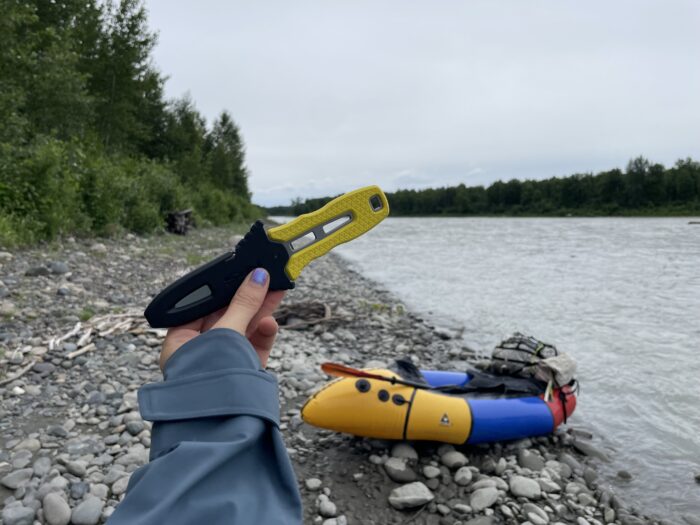
Fixed-blade knives
Generally, a fixed-blade knife is stronger than a foldable knife. The fixed blade and handle provide strength and tactical advantages that are quite valuable in a survival knife. These blades are easier to clean and less prone to breaking. However, a fixed-blade knife is harder to conceal and takes up substantially more space than a folding knife.
Folding knives
A folding knife folds easily into a pocket for concealment and transport. A small folding knife can be a great tool for backpackers, those looking to save space, or for those who want something as an everyday carry option. These models can also provide a small layer of safety around children, given that the blade is not exposed without effort. However, these blades require more maintenance, are not as strong as a fixed-blade knife, and take more time to be ready for action.
Multi-tools
While multi-tools like a Swiss army knife are handy for their versatility, as camping knives they often fall short and we recommend having a backup on hand. The blade edge available is often short and doesn't offer much working area. These can be helpful in a pinch but not as primary survival knives.
Drop-point blade knife
A drop-point blade is one of the most popular choices for both a camping utility knife and a hunting knife. In a drop point blade, the back of the knife lowers in a slow curve offering more strength and control at the tip.
Pocket knife care

A good camping knife is a precision tool that can not only cut your bacon but might also save your life in an emergency. As such, it deserves to be treated with the same respect you’d show your tent or hiking boots. Therefore:
- Don’t put your knife away until it’s clean and dry - Your pocket knife is a workhorse, so it’s going to get wet and dirty. That’s unavoidable. What is avoidable, however, is putting the knife away when it’s in such a state. Always make sure that your pocket knife is clean and dry before putting it away.
- Hone the blade regularly - Honing the knife on a regular basis ensures the blade is always crisp and sharp. Honing the blade is roughly akin to changing the oil in your car while sharpening the blade is like bringing the car in for a tune-up. Hone after each use if you can.
- Don’t abuse the knife - A pocket knife is designed to handle tasks like whittling stakes, cutting rope, and cleaning fish. Unless it has a pommel built into the base it should not be used as a hammer. Also, don’t use the knife as a screwdriver or an ice pick, and don’t practice throwing it.
- Lubricate your knife - Folding knives need to be kept properly lubricated. Most will use some type of oil-based lubricant that is applied to the various moving parts. Be sure to wipe away any excess.
Frequently asked questions about pocket knives
What is a pocket knife?
Pocket knives, also known as EDC knives, are small knives that generally fit in your pocket. Most of them are folding knives, though some are fixed blades that can be carried on your belt. Most pocket knives are defined as heavy-duty knives, typically full tang, with a blade under five inches. They're useful in both the frontcountry and the backcountry.
How do you properly clean a pocket knife?
Cleaning a knife in the backcountry can be tricky, but a wash with soap and water generally does the trick. At the very least, wipe the blade down to remove all visible debris before putting it away. A more thorough scrub can be completed when you are home.
How sharp should a pocket knife be?
A camping knife should be sharp enough to handle anything you throw at it, including food prep and bushcraft work. However, a too-sharp knife could pose a problem if there is a mishap and medical attention is far away. Balance is key.
Should I get a straight-edge or a serrated-edge pocket knife?
Most pocket knives have a straight edge, which is ideal for push cuts, such as shaving, and slicing. Some fixed-blade pocket knives have a serrated edge, which is useful for sawing tough rope or wood. In general, straight blades are fine for pocket knives. They give you better control, cleaner cuts, and are easier to sharpen. Serrated blades are not as precise, and are more tedious to sharpen and maintain.
Watching your phone edge toward the 1% battery mark with no power outlet in sight is especially worrying if you're in the backcountry and rely on your phone for navigation and communication. While today's phones typically have long-lasting batteries, if you're heading out on a multi-day backpacking trip, you'll need to recharge yours at least once. That's where power banks come in.
Power banks are portable, rechargeable batteries that transfer power to other electronic devices, like your smartphone, tablet, or satellite communication device. Simply charge the battery from a wall outlet and take the power bank with you. When you need a charge, just plug your phone into the power bank.
Gear Editor Chelsey Cook spends weeks at a time in the backcountry, both guiding and on personal expeditions. She relies on power banks to keep her phone, Kindle, and inReach charged and ready to use during her trips. She tested numerous different models of power banks to create this buyer's guide, from pocket-sized ones ideal for short trips to bulkier, powerful models that can charge multiple devices on longer expeditions.
Editor's note: We updated this buyer's guide on June 11, 2024. We announced the Anker PowerCore 13000 Power Bank as the Best Overall Power Bank and added superlatives for the Most Portable Power Bank and Best High Capacity Power Bank.
Our Picks for the Best Power Banks
- Best Overall Power Bank: Anker PowerCore 13000 Power Bank
- Best Budget Power Bank: Miady 10000mAh Dual USB Portable Charger
- Most Portable Power Bank: Goal Zero Flip 24 Power Bank
- Best High Capacity Power Bank: Anker 737 Power Bank
Best Overall Power Bank:
Anker PowerCore 13000 Power Bank
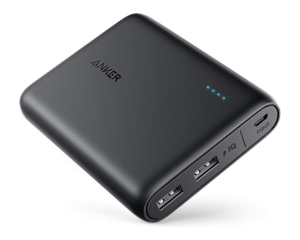
Features:
- Slim and compact given the capacity
- Includes a Mirco-USB cable
- Power IQ and VoltageBoost technology offers fast charging speeds
- Recharges in seven hours
Why we like it: Compact, durable, and powerful
What we don't like: Uses a Micro-USB to recharge, which is slow and a little outdated
Capacity: 13,000 mAh | Outputs: 2 USB-A | Inputs: Micro-USB | Weight: 8.5 oz | Dimensions: 3.8 x 3.1 x 0.9 in
The Anker PowerCore 13000 ($36) is Chelsey's go-to power bank for most of her backpacking trips. She's used the same one for several years and likes how compact and durable the power bank is, while still providing a powerful charge. She hasn't noticed an appreciable difference in capacity despite several years of use and has dropped her power bank more times than she can count without causing any damage.
This slim, compact power bank can charge a smartphone between three to five times, depending on the model of the phone. It also comes with two high-speed USB-A ports to charge two devices simultaneously, and a Micro-USB port to recharge. The one downside it that it takes seven to eight hours to recharge with a 2A wall charger, which is longer than most of the power banks in this guide.
Best Budget Power Bank:
2-Pack Miady 10000mAh Dual USB Portable Charger
Features:
 Comes in a pack of two
Comes in a pack of two- Easy LED button to check the power remaining
- Automatically powers off if not connected to a device
- UBS-C and micro-USB charging
- Holds 2 smartphone charges
- Takes 5 hours to recharge
Why we like it: Great value for a two-pack, slim and lightweight
What we don't like: Slow to charge, starts to lose capacity after several months of use
Capacity: 10,000 mAh | Outputs: 2 USB-C | Inputs: USB-C and micro-USB | Weight: 7.7 oz each | Dimensions: 3.7 x 1.6 x 0.8 in
The 2-Pack Miady 10000mAh Portable Charger ($22) is our pick for the best budget power bank. It comes with two power banks for about half the price of most other banks, and the quality is still impressive for such a low price. Each power bank holds two smartphone charges, and each one comes with two USB output ports, so you could potentially charge four devices simultaneously. The power banks are relatively slim and compact and are equipped with over-heat, over-surge, over-charge, and short-circuit protection.
The low price point does come at a cost, however. The power banks don't have a USB-C port and are slow to recharge. They also seem to lose their capacity quicker than more expensive devices. We noticed a change in capacity after a few months of use.
Most Portable Power Bank:
Goal Zero Flip 24 Power Bank
Features:
- Small enough to fit in your pocket
- Easy-to-read battery indicator
- USB port for input and output, with a flip-out input USB for easy recharging
- Provides 2 smartphone charges and a 50% boost to tablets
- Only takes 4 hours to charge the power bank
Capacity: 6,700 mAh | Outputs: 1 USB- A | Inputs: USB-A flip out | Weight: 4.6 oz | Dimensions: 3.7 x 1.6 x 0.8 in
Why we like it: Compact, lightweight, and great for short-term phone charging
What we don't like: Flip-out USB feels flimsy and can be hard to charge off a wall charger
At just over four ounces and small enough to fit in your pocket, the Goal Zero Flip 24 ($30) is our pick for the most portable power bank. Despite its small size, this power bank holds two smartphone charges and can recharge in just four hours. A flip-out USB input port means you don't have to carry a recharging cable, either. Simply plug the Goal Zero Flip 24 directly into a wall charger. Chelsey does find the flip-out port to be a little flimsy and difficult to plug into a wall charger. She also often pairs the Goal Zero Flip 24 with a Goal Zero Nomad 10 solar panel to recharge her power bank on longer trips.
Goal Zero also offers an even smaller power bank, the Goal Zero Flip 12. However, it only holds one smartphone charge. With such a low capacity, we didn't find it to be the most practical power bank, except for day hikes and quick overnight backpacking trips.
Best High Capacity Power Bank:
Anker 737 Power Bank
Features: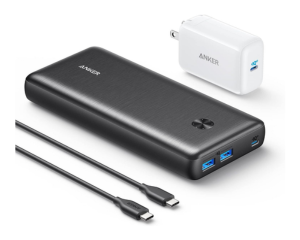
- Can simultaneously charge three devices
- Power IQ 3.0 technology offers fast charging speeds
- Capable of charging your laptop
- Takes 2.5 hours to recharge with the Anker wall charger
- 18-month warranty
Why we like it: Incredibly powerful in a relatively small, light package
What we don't like: Expensive
Capacity: 25,600 mAh | Outputs: 2 USB-A, 1 USB-C | Inputs: 1 USB-A, 1 USB-C | Weight: 1.3 lbs | Dimensions: 7.2 x 3.2 x 0.9 in
The Anker 737 Power Bank ($110) may be the most expensive power bank on this list but with good reason. It has an impressive 25,600 mAh capacity, while still being compact and lightweight enough to be brought backpacking. Chelsey uses the Anker 737 Power Bank on longer expeditions and while guiding Denali, and can get over six iPhone 12 charges from it. It also easily powers her inReach and Kindle, and with two USB-A ports, she can even charge devices simultaneously. Anker also claims that their 737 Power Bank can charge laptops. With the included Anker wall charger, the power bank also recharges in a remarkable two-and-a-half hours.
At over a pound, this power bank is nearly twice as heavy as other power banks in this guide. If weight is a concern, we recommend only using the Anker 737 Power Bank on expeditions that are a week or longer, and sticking with a lighter power bank for shorter trips.
Honorable Mentions:
Goal Zero Flip 36
Features: 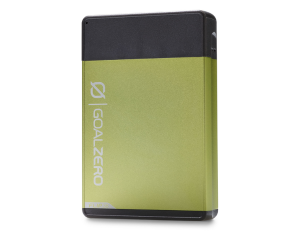
- Flip-out USB-A input port
- 10,050 mAh capacity
- Rechargeable through Goal Zero Nomad solar panel
- Charges in 5 hours
Chelsey has been using the Goal Zero Flip 36 ($40) as a backup, medium-capacity power bank to her Anker PowerCore 13000. It holds a similar amount of power and recharges her smartphone up to three times. The flip-out USB-A port can be convenient for charging because you don't need a cord, however, it feels flimsy and can be hard to set up on a wall charger because of how the power bank hangs off the flip-out port. Chelsey often brings a Goal Zero Nomad 10 solar panel on longer expeditions and uses it to recharge her Goal Zero Flip.
iMuto 20000mAh Portable Charger
Features: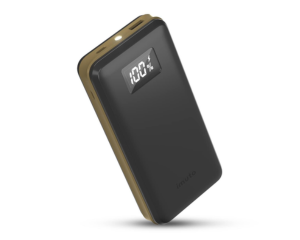
- Two USB ports for fast dual-device charging
- 20,000mAh high capacity
- LED display screen and built-in flashlight
- Works with Micro-USB, USB-C, and lightning cable
This iMuto 20000mAH Portable Charger is a compact power bank with enough juice to charge your phone up to eight times. The LED screen is an excellent addition and shows how much battery you have left in an easy-to-read digital format. There’s even a built-in LED flashlight, great for camping and useful in a blackout. The power bank has ports for Micro-USB, USB-A, and USB-C. It also comes with a Micro-USB cable, a waterproof travel pouch, a user guide, and an 18-month warranty. While the power bank itself is small, it's far from the lightest in this guide and weighs over a pound.
Ekrist 25800mAh Power Bank
Features:
- Two USB ports (2.1A and 1A)

- 25,800 mAh capacity
- Recharges in up to 12 hours with a 2.1A input charger
- Four LED battery indicator lights
If you're looking for a budget-friendly portable charger with high capacity, the Ekrist 25,800mAh Power Bank ($25) is a good choice. With a 25,800 mAh capacity and two USB ports, the Ekrist portable charger can charge two devices simultaneously and holds six to eight phone charges. It has four LED lights that show the remaining power. However, it doesn't have USB-C ports and takes a long time to charge devices, as well as recharge.
About our testing process
The ExplorersWeb power bank testing team, comprised of Chelsey Cook and Jovana Dosenovic, often spends weeks at a time in the backcountry, guiding clients on high-altitude mountaineering trips and exploring remote areas of the world on their personal expeditions. They rely on numerous electronics to support them on these trips, including smartphones for navigation and satellite devices for communication. While most electronics have enough battery life to get you through an overnight backpacking trip, Chelsey and Jovana rely on power banks to keep their devices charged on longer expeditions.
In October 2022, Jovana used her expertise and experience with power banks to create this buyer's guide. It was then taken over by Gear Editor Chelsey Cook in June 2024. As a mountaineering and backpacking guide in Alaska, she often spends four months a year in the field, with trips lasting up to three weeks.
Chelsey never goes into the field without her smartphone, her Kindle, and her inReach, and needs a power bank that can easily charge all three while still being light enough to carry in her backpack. Because she's in the backcountry so often, with very quick turn-around times, she also values power banks that are durable, don't lose their capacity after repeated use, and recharge quickly. Her favorite everyday power bank is the Anker PowerCore 13000, and she's been using the same one for several years.
To compile this buyer's guide, Chelsey tested power banks on expeditions up Denali's West Buttress, on backpacking trips in remote Alaska, and while traveling through South America for two months. She tested power banks with different capacities and ports to meet a variety of charging needs, and looked for power banks that were lightweight, durable, and quick to both charge and recharge.

Things to consider when buying power banks
Capacity
Most power banks measure their capacity by millamps per hour, or mAh, ranging from as low as 5,000 mAh for smaller power banks, to over 20,000 mAh for larger ones. Smartphones, when fully charged, usually contain 3,000 to 4,000 mAh, so a 10,000 mAh power bank, the typical capacity for a medium-sized battery, could potentially charge a smartphone 3 times.
While it may seem like a good idea to get the largest capacity power bank you can find, large capacity power banks are heavier and bulkier than small capacity power banks. If you're backpacking and looking to save weight, only buy the size you need. Chelsey typically brings a 10,000 mAh power bank for backpacking trips up to three or four days in length. That's plenty to keep her phone, Kindle, and satellite device charged. For longer trips, like when she's spending three weeks on Denali, she'll either double up on 10,000 mAh power banks or bring Anker 737 Power Bank, which has a 25,600 mAh capacity. Chelsey also brings a small solar panel on multi-week trips, which she uses to recharge her power banks.
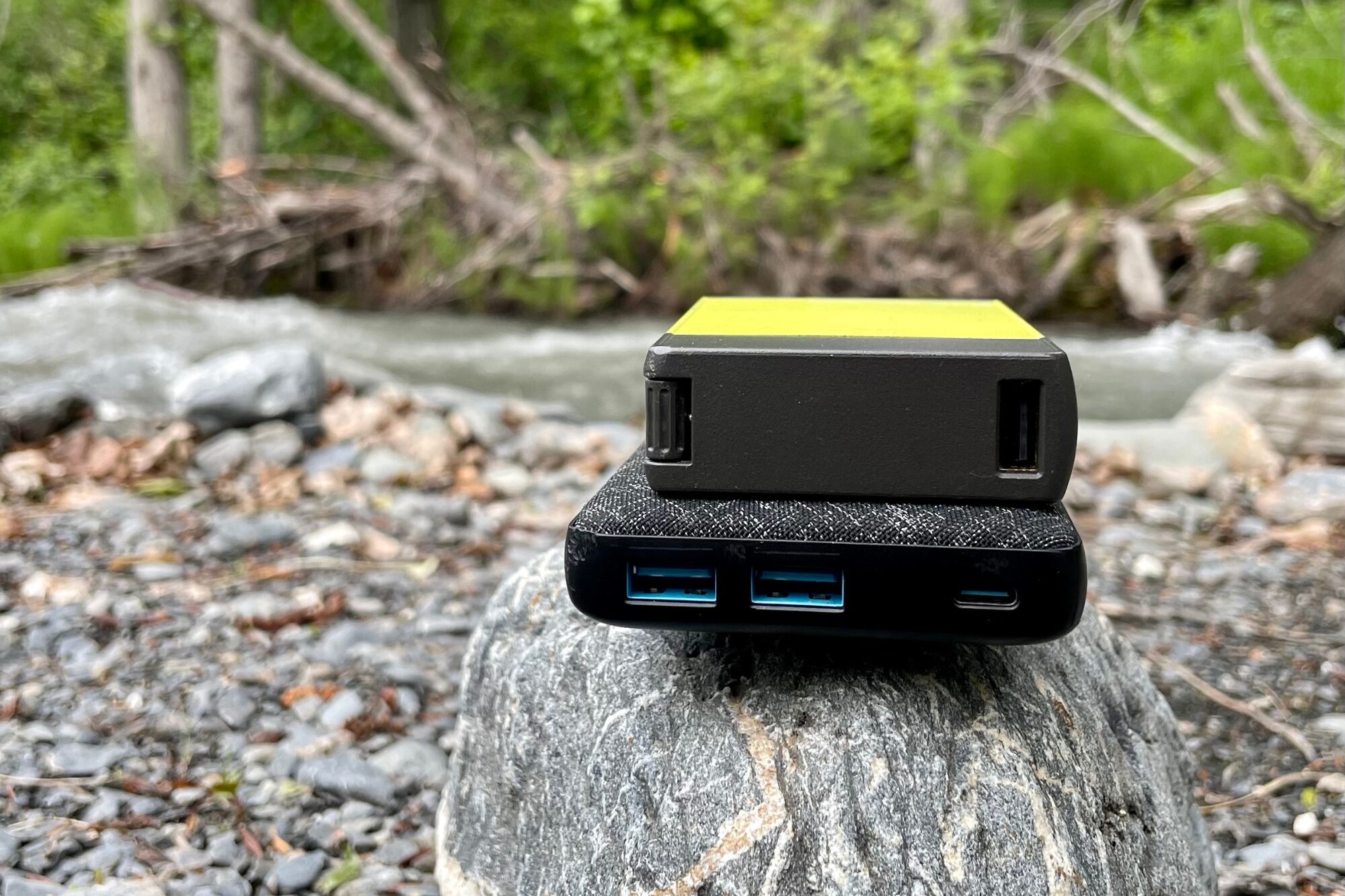
Charging and recharging speeds
The best power banks are the ones that both recharge quickly and charge your devices quickly. High-capacity power banks typically take longer to charge than lower-capacity power banks. The smallest capacity power bank in this guide, the Goal Zero Flip 24, takes around four hours to recharge, while the largest, the Anker 737 Power Bank takes over 17 hours with a standard wall charger.
How quickly a power bank recharges and charges depend on the type of in and out port it has. A 1A USB port, which provides one amp of electrical power, is the slowest, while the 2.1A USB port is marginally faster. The fastest and most efficient charging port is the USB-C.
Many devices, including power banks, claim to support "fast charging" when charging a phone or tablet. However, there is no standard as to what "fast charging" actually means. Each device can handle different amounts of power, and all the pieces in a charging system, including the phone, power bank, and charging cable, affect how quickly power is delivered.
The output of a power bank itself is determined by amperage, the amount of electricity flowing from the power bank to the battery, and voltage, the strength of the electric current. Multiplied together, you get wattage or total power. "Fast charging" devices, including power banks, usually deliver 15W or more. While that may sound desirable, many small devices like headphones and watches can't tolerate that much power. Using a "fast charging" device on a small electronic can cause irreversible damage to your battery life.
Types of in and out ports
Most small electronic devices use three standard ports: Micro-USB, USB-A, and USB-C. Micro-USBs are rarely used anymore, though can still be found on power banks. USB-A ports are more common, both as input and output ports. Flip-out USB-A ports, like on the Goal Zero Flip 24, eliminate the need for a charging cable to recharge. USB-C, the same small port used on the latest iPhones, is the most common port, and generally the most efficient.
Some power banks have several types of ports, which is useful when charging different devices. Just make sure you have the correct charging cable for the ports your power bank has.
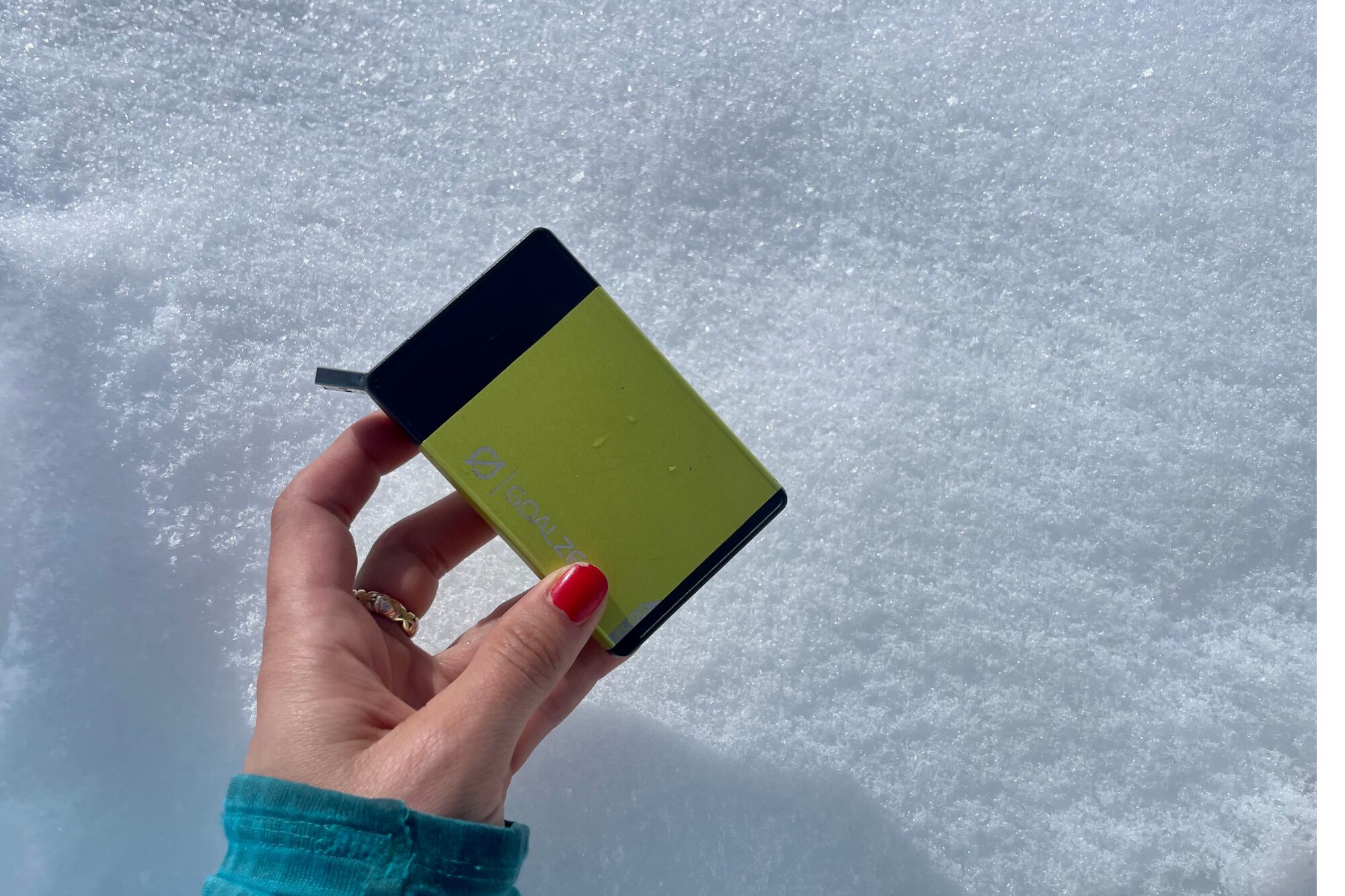
Frequently asked questions about power banks
Is a power bank worth it?
Power banks are a lightweight, relatively inexpensive backup plan for when your phone runs low on battery. They're also a vital piece of gear for backpackers, as they can keep your phone and satellite communication device charged over the days or weeks you're in the backcountry. Chelsey brings them on all of her expeditions, and they help keep her phone powered for navigation, her Kindle charged for long storm days in tents, and her inReach's battery full to deal with an emergency.
How long does a power bank last?
The power banks in this guide should perform for several years. Chelsey's been using the same Anker PowerCore 13000 for nearly four years. All batteries do eventually degrade with regular use, however, and you may notice that older power banks don't hold as much of a charge as they used to.
What capacity power bank do I need?
The power banks on this list are all portable enough to take backpacking and traveling. Most users stick with a power bank that is around 10,000 mAh, which will provide around three smartphone charges. If you'll mostly be using yours on short trips, like overnight backpacking, consider something closer to 5,000 mAh, like the Goal Zero Flip 24.
If you want to charge a tablet or laptop or are going on a week-long trip, look for a power bank closer to 20,000 mAh, like the Anker 737 Power Bank. Just keep in mind that power banks with more capacity are often larger and heavier.
Can I bring a power bank on an airplane?
You can bring most small power banks on an airplane, but they can't be kept in checked luggage. Make sure to keep them in your carry-on.
Hiking socks are a critical piece of outdoor gear. While you may be tempted to grab any old pair out of your sock drawer for your next day out, good hiking socks provide comfort, cushioning, and moisture-wicking that your daily socks can't. They are vital to keeping your feet healthy during long hikes.
To find the best pair of hiking socks, Gear Editor Chelsey Cook and Sam Anderson put dozens of socks to the test, wearing some pairs until they literally came apart at the seams. They hiked and backpacked in the Southwest desert and Alaskan tundra, testing the socks in sand and snow alike and on hard-packed trails and river crossings. Chelsey wore a few pairs for over a week straight while on backpacking trips throughout Alaska to evaluate their durability and odor control, and tested toesocks while running an ultramarathon. She also packed three pairs for a month of travel in Peru, to test how they held up to repeated daily abuse of wandering the streets of Cusco and hiking throughout the Sacred Valley.
Throughout our testing, we considered durability, cushioning, and comfort. We tested socks made from different materials, with different heights and cushioning levels. This guide represents the hiking socks that kept our feet the happiest during long days on the trail.
If you're looking for a pair of boots to go with your hiking socks, check out our guide to The Best Hiking Boots of 2024.
Editor’s Note: We updated this guide on May 29, 2024, to announce our Best Overall Hiking Socks as the Darn Tough Hiker Micro Crew Cushion Hiking Socks. We also added superlatives for Best Hiking Socks for Cold Weather and Best Hiking Socks to Prevent Blisters.
Our Picks for the Best Hiking Socks
- Best Overall Hiking Socks: Darn Tough Hiker Micro Crew Cushion Hiking Socks
- Best Lightweight Hiking Socks: Farm to Feet Max Patch 1/4 Lightweight Hiking Socks
- Best Hiking Socks for Cold Weather: Smartwool Ski Targeted Cushion Over the Calf Socks
- Best Hiking Socks to Prevent Blisters: Injinji Trail Midweight Socks
Best Overall Hiking Socks:
Darn Tough Hiker Micro Crew Cushion Hiking Socks
Features:
- Responsibly sourced merino wool insulates even when wet
- Well-established reputation for long-term durability, coupled with a lifetime warranty
- Micro crew height works with most hiking boots
- Made in Vermont
- Favorite of thru-hikers
Why we like them: Incredible durability with a lifetime warranty, very comfortable
What we don't like: Expensive, may be too warm for hiking in hot climates
Materials: 61% merino wool, 36% nylon, 3% lycra spandex | Height: Micro crew | Weight: Midweight
The Darn Tough Hiker Micro Crew Cushion Hiking Socks ($25) are Sam's and Chelsey's pick for their favorite overall hiking socks. Both Sam and Chelsey have (regrettably) spent weeks in the backcountry with only one or two pairs of socks, and Darn Toughs were the only ones to stand up to the job. The merino wool keeps odor at bay while also providing insulation, and the cushioning is comfortable even after long days on your feet. The height and cushioning level also makes them ideal for a range of activities, including hiking, biking, scrambling, and packrafting.
They're also ridiculously durable. Despite using them for all of her hiking, trail running, and daily sock needs, Chelsey has never managed to wear a hole in any of her pairs, though the elastic ankle has occasionally stretched out after a few seasons of use. Luckily, with Darn Tough's Guaranteed for Life program, Chelsey has just mailed her old, worn-out socks to the Vermont-based company, and they've sent her a new pair or a gift card in exchange. This makes the upfront $25 cost easier to swallow.
Some hikers may find them a little too warm for hot days or hard efforts. Thankfully, Darn Tough also has Light Hiker Micro Crew Socks, which Chelsey uses for trail running.
Check Men's Price at Backcountry
Check Women's Price at Backcountry
Best Lightweight Hiking Socks:
Farm to Feet Max Patch 1/4 Lightweight Hiking Socks
Features: 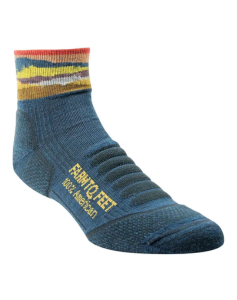
- Supply chain is entirely within the U.S.
- Targeted, light cushion keeps socks comfortable and lightweight
- Seamless toe closure reduces bulk and friction
- Aesthetic mountain pattern around the ankle
Why we like them: Supportive and lightweight, with cushioning in all the right places
What we don't like: Low height may not work with most traditional hiking boots, not as durable as Darn Toughs
Materials: 59% nylon, 37% merino wool, 4% spandex | Height: Ankle | Weight: Lightweight
The Farm to Feet Max Patch 1/4 Lightweight Hiking Socks ($22) are above-the-ankle hiking socks with targeted cushioning to keep them lightweight. The socks are made with 100% U.S.-sourced merino wool, as well as American nylon and spandex, and feature a comfortable seamless toe closure to reduce bulk and blisters. High-density cushioning is focused only along the ball, heel, and top of your foot, to let your feet breathe in warmer conditions. The Max Patch socks also only reach just above your ankle bone. While this helps keep you cool during hot hikes, the low height can cause some rubbing in traditional hiking boots. These socks are best worn with hiking shoes, mid-height hiking boots, and trail runners.
Chelsey found the Farm to Feet socks less durable than Darn Toughs, likely because of the thinner material. However, Farm to Feet also has a Satisfaction Guarantee program that lets you send back socks if you aren't happy with their durability.
Best Hiking Socks for Cold Weather:
Smartwool Ski Over the Calf Targeted Cushion Sock
Features:
- Over the calf height keeps your lower legs warm
- Targeted cushion to protect your feet without making the socks bulky
- Mesh zones increase breathability
- Indestructawool
 technology enhances durability
technology enhances durability
What we like them: Durable, warm without being bulky, merino wool for odor control
What we don't like: Shin cushioning is unnecessary for hiking and may make the socks too warm for some conditions
Materials: 59% merino wool, 27% recycled nylon, 3% elastane | Height: Over the calf | Weight: Midweight
The Smartwool Ski Over the Calf Targeted Cushion Socks ($28) is Chelsey's pick for the best hiking socks for cold weather and winter hikes. The high, over-the-calf length provides ample coverage to keep your feet and lower legs warm, while the targeted cushion in the balls and heels will make those long days on your feet more enjoyable. The targeted cushion also keeps the socks slim enough to fit in hiking boots without squishing your toes. Like the Darn Tough Hiker Micro Crew Cushion Hiking Socks, the Smartwool Ski Socks have a high percentage of merino wool, making the socks softer and more odor-resistant than other materials.
While the shin cushioning isn't necessary for hiking, it may help keep your legs warmer and make the socks more versatile. Chelsey uses the same pair for winter hiking and backcountry skiing. Smartwool also offers the same socks with full cushion and zero cushion.
Check Men's Price at Smartwool
Check Women's Price at Smartwool
Best Hiking Socks to Prevent Blisters:
Injinji Trail Midweight Socks
Features: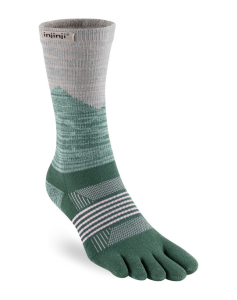
- Mesh top for breathability
- Each toe is protected to reduce skin-on-skin friction and lets your foot splay naturally
- Band around the arch increases support
- Extra cushioning on the footbed
Why we like them: The best blister-prevention out there, light enough for hot days
What we don't like: Toe-socks aren't for everyone, elastic in the ankle stretches out
Materials: 39% CoolMax EcoMade, 58% nylon, 3% lycra | Height: Crew | Weight: Midweight
While the Injinji Trail Midweight Socks ($17) may look a little ridiculous, toesocks are incredibly popular amongst ultrarunners, and for a good reason. These socks are blister--preventing wonders. With each toe individually protected by its own sock, skin-on-skin friction, one of the main causes of blisters, is essentially eliminated. Chelsey tested them for herself throughout several long training runs and ultramarathons and walked away without a single blister. Having each toe separated also lets her feet splay and move naturally in her shoes, reducing the usual pain she feels in her forefoot on long runs and hikes. The mesh top kept her feet from overheating, while the arch band supported her on long days.
While the feeling of fabric between your toes takes time to get used to, it's well worth it for how happy your feet will be after a long hike or run. Injinji also offers mini-crew and ankle socks if you prefer a shorter sock.
Check Women's Price at Injinji

About our testing process
The ExplorersWeb sock testing team, comprised of Chelsey Cook and Sam Anderson, has worn through so many socks during their collective 35 years of backpacking, climbing, and mountaineering that they've lost count. They gladly took on the challenge of testing a batch of new hiking socks to determine which pairs should be included in this guide.
Sam Anderson started this guide in May 2022. He's a jack of all trades — an avid road tripper and passionate rock climber, and a chainsaw operator and carpenter. Whether he's working or playing, he's on his feet and more often than not in boots. Sam relies on the right hiking socks to keep his feet comfortable and prioritizes socks made from moisture-wicking and odor-controlling materials. He tested socks on backpacking and rock climbing trips along the West Coast,
Gear Editor Chelsey Cook took over the hiking socks guide in May 2024. As a mountaineering and backpacking guide in Alaska, she often spends at least four months a year in the field. With an average pack weight over 75 pounds on most expeditions, she cuts weight and bulk where she can, and typically flies into the backcountry with only two pairs of socks to cover her for up to three weeks.
Because she demands so much from each pair, Chelsey values durability, adequate cushioning, and comfort. She's a die-hard Darn Tough fan, exclusively wearing them for all her backpacking and mountain biking needs, and in her daily life. She also tested cold-weather hiking socks while backcountry skiing in France and Washington, and on mountaineering trips in the Alaska Range. She brought the Smartwool Ski Over the Calf Targeted Cushion Socks on Denali, running the socks through their paces for three weeks. Lastly, because she's a glutton for recreational discomfort, Chelsey signed up for a 250-mile ultramarathon in Utah and wore the Injinji Trail Midweight Socks for the first 120 miles. While the rest of her body fell apart, her feet did not, and she walked away from the race without a single blister.
To meet a wide range of hiking needs, we included socks with different heights and cushioning in this guide. All the socks in this guide meet our standards for durability, comfort, and support. They're also all from trusted brands, many of which have outstanding warranty programs.

Things to consider in hiking socks
Materials
The hiking socks market is filled with wool socks and for good reason. Wool regulates temperature and wicks moisture, helping prevent sweaty feet. It insulates when wet, a property that Chelsey appreciates in Alaska, where every hike seems to include a river crossing. Wool also naturally reduces odor.
Most wool socks come in a blend of fibers, including a synthetic material like nylon and a stretchy one like spandex. Merino wool is typically softer and less itchy than regular wool. Look for brands that source their merino wool responsibly.
Some hiking socks, particularly liner socks, are made from polyester, a synthetic material. Polyester socks are affordable, light, and quick-drying. Polyester isn't as breathable or soft as wool and tends to get stinky quicker. It's also a synthetic material derived from petroleum, so not as sustainable as natural wool.
Height
Hiking socks come in all different heights, from no-show to over the calf and everything in between. The right height depends on your footwear. The higher your boots, the taller your socks should be to prevent the boots from rubbing your skin
- No-show: These socks are so short that they won't show over the top of a running shoe. They offer your ankles no protection from abrasions, either from your hiking boots or from brush. We didn't include any in this buyer's guide, but they can be a good option for trail running shoes.
- Ankle: Also called 1/4 crew, these hiking socks come just above your ankle bone. While too short for traditional hiking boots, Chelsey often wears them with running shoes and likes the Farm to Feet Max Patch 1/4 Lightweight Hiking Socks.
- Crew: This is the most common height for hiking socks. They extend a few inches above your ankle bone, protecting your skin from higher-cuffed hiking boots and brushy trails.
- Over the calf: These socks come to just below the knee, and are often labeled as ski socks rather than hiking socks. They provide maximum abrasion protection and warmth and are a good option for winter hiking and mountaineering.
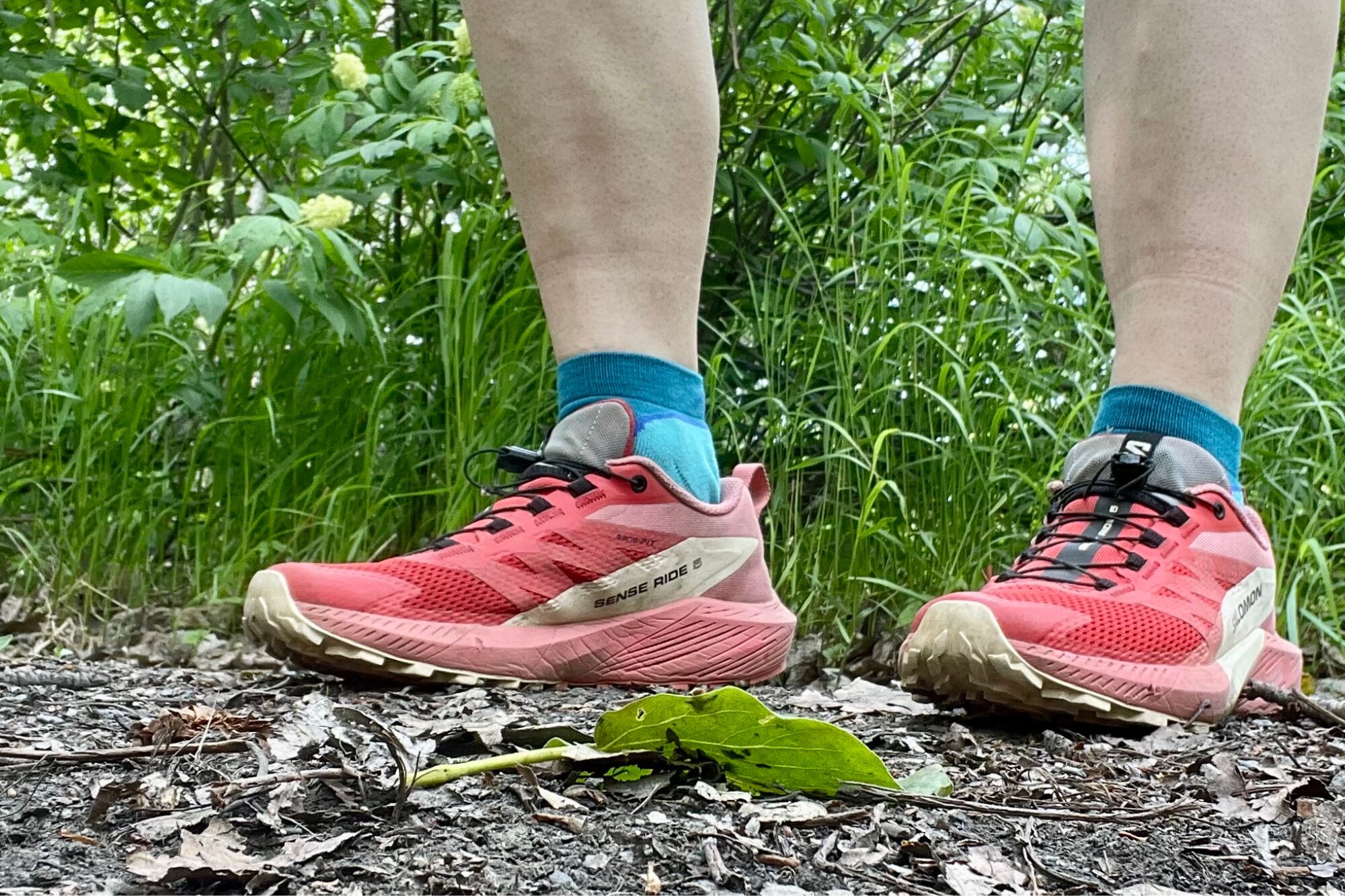
Cushioning
The amount of cushioning in hiking socks affects their thickness, warmth, and comfort.
- No cushioning: Hiking socks with no cushioning are lightweight and breathable. These socks can be a good option for hot day hikes, but your feet may suffer on longer trips without any cushioning.
- Light cushioning: Made for warmer conditions, these socks are lightweight, with cushioning only in a few key areas, like the balls and heels of the feet. Light cushioning is sometimes called targeted cushioning, like in the Farm to Feet Max Patch 1/4 Lightweight Hiking Socks.
- Medium cushioning: These socks have cushioning on the balls and heels, and sometimes the entire footbed. They're a great choice for moderate to cooler temperatures, and the increased cushioning will keep your feet happier on longer days or under heavy packs. Chelsey uses medium cushioning on her backpacking trips and long day hikes.
- Heavy cushioning: These socks are the thickest and warmest available. They're designed for winter conditions and mountaineering and aren't suitable for most backpacking trips. Chelsey brings a pair of heavy-cushioned socks on Denali for summit day, and to use as her "sleep socks". They're generally too thick to fit comfortably in her hiking boots.
Durability
Between long days on the trail, dealing with sweat and dirt, and then being put through the wash cycle, hiking socks go through a lot of wear and tear over their lifespan. You want your hiking socks to last you several seasons of adventure, and durability is a key component to hiking socks choice. While all the brands in this buyer's guide make high-quality socks, some are more durable than others. For instance, Chelsey found that Smartwool hiking socks are prone to holes. The ankles on her Injinji's also stretched out quickly, though the rest of the socks held up well. Darn Toughs, while not the softest and lightest hiking socks, truly live up to their name. Chelsey has not yet managed to wear a hole in them, though she has noticed the ankles loosening after a year of heavy, almost daily use — which is frankly more abuse than any single pair of socks should bear.
Some brands, like Farm to Feet and Darn Tough, have warranty programs. Farm to Feet's Satisfaction Guarantee Program lets you send back socks that don't meet your durability and performance standards in exchange for new ones. Darn Tough's Guaranteed for Life program similarly lets you send back worn-out socks in exchange for a new pair. Chelsey's sent in Darn Tough socks with stretched-out ankles and thin heels and appreciates how quick and easy the program is.
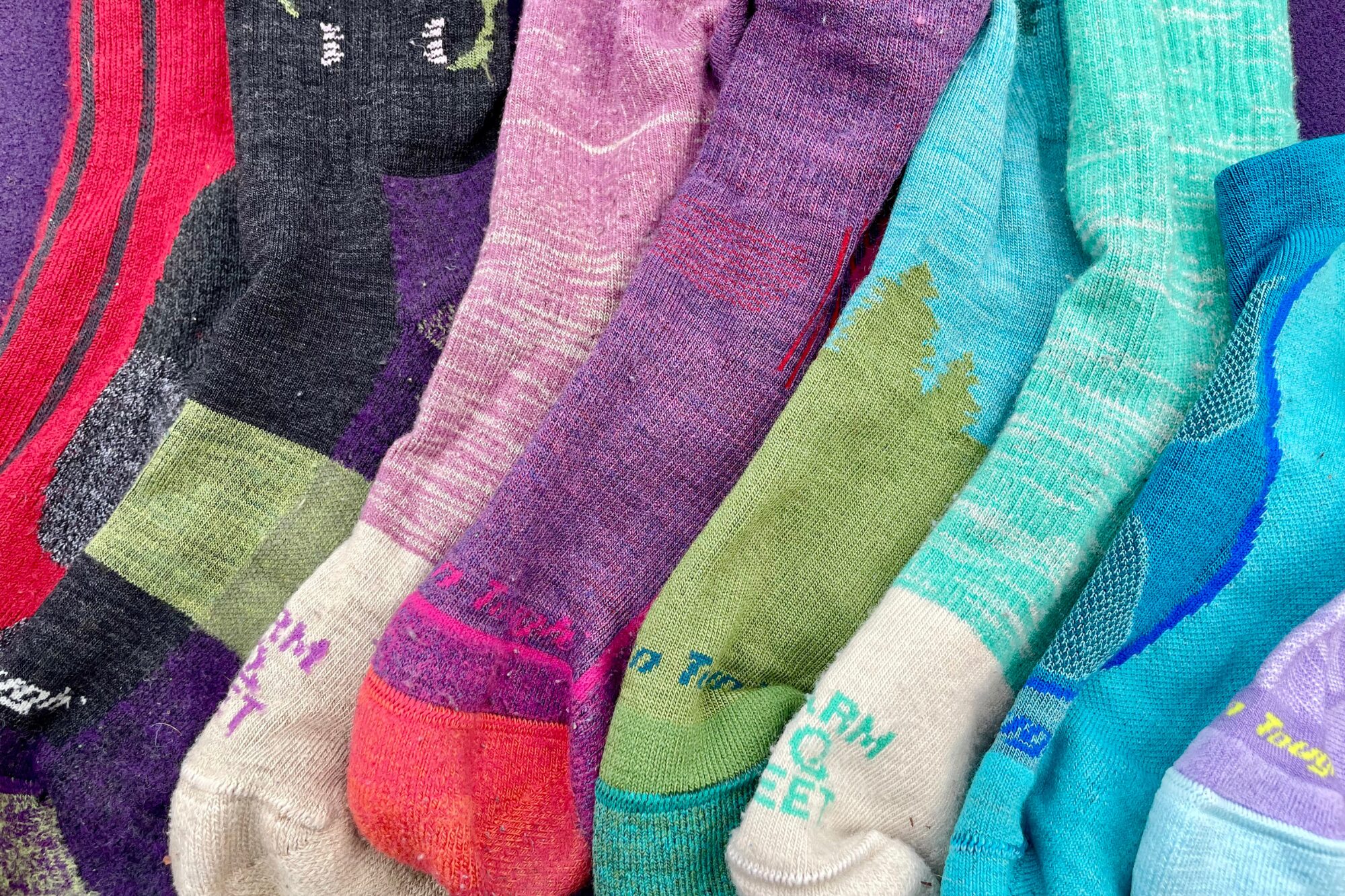
Frequently asked questions
What materials are best for hiking socks?
Wool is the best material for hiking socks. Wool wicks moisture and insulates while wet, and provides cushioning for your feet. Most hiking socks come in a blend of wool, nylon, and an elastic material like lycra. Polyester is also sometimes used, but it doesn't have the same odor control as wool does.
What are the best hiking socks?
Our pick for the best hiking socks are the Darn Tough Hiker Micro Crew Cushion Hiking Socks. We loved how comfortable and cushioned they were, with a height that comfortably fits with most hiking boots. Darn Tough also has an impeccable lifetime warranty for their socks, making them our best-value choice as well.
Are thick or thin socks better for hiking?
It depends on the climate you're hiking in, your personal preference, and the type of hiking boots you're using. Thicker socks offer more cushioning, which might be more comfortable if you're wearing traditional hiking boots, carrying a heavy backpack, or will be spending long hours on your feet. However, they are also warmer and bulkier, which can be uncomfortable on hot days. Thinner socks don't offer as much cushioning but can be a good option if you use light hiking shoes or trail running shoes, or are going on day hikes in hotter weather. Whatever socks you choose, make sure they fit comfortably in your shoes and don't cram your toes. The thicker the sock, the more room in your shoe it will take up!
Should I wear liner socks?
Liner socks, thin socks you wear under your hiking socks, were once a popular method to help wick moisture and keep your feet dry. Most hiking socks on the market today, particularly those made of merino wool, have such high moisture-wicking performance that you don't need liner socks. Some hikers also use liner socks to help prevent blisters. If your feet are blister-prone, it may be worth trying, though we recommend trying the Injinji Trail Midweight Socks first.
A good night's rest is vital to the success of backpacking and climbing trips. Our Gear Editor Chelsey Cook has spent nearly two decades backpacking and climbing around the world, and she's convinced that she can suffer through just about any conditions during the day if she has a comfortable, warm place to sleep at night with a quality sleeping pad. A backpacking sleeping pad is an integral part of any sleep system. It gives the comfort you need to sleep well while also insulating you from the ground.
Gone are the days of thin foam pads or overly bulky air mattresses. The vast sleeping pad market offers everything from lightweight air pads for thru-hikers to high R-value options for winter backpackers and mountaineering to plush, self-inflating mattresses for base camping. We break down some of our favorite backpacking sleeping pads below, chosen for their comfort, durability, and packability after years of testing them in environments as far ranging as Alaska and Peru.
Editor's Note: We updated this guide on May 25, 2024, to announce the Best Overall Backpacking Sleeping Pad as the Therm-a-Rest NeoAir XLite NXT after three years of testing. We also added superlatives for the Best Backpacking Sleeping Pad for Cold Weather, the Best Backpacking Pad for Side Sleepers, and the Best Basecamp Sleeping Pad.
The Best Backpacking Sleeping Pads of 2024
- Best Overall Backpacking Sleeping Pad: Therm-a-Rest NeoAir XLite NXT Sleeping Pad
- Best Budget Backpacking Sleeping Pad: Big Agnes Divide Insulated Sleeping Pad
- Best Backpacking Sleeping Pad for Cold Weather: Therm-a-Rest NeoAir XTherm NXT
- Best Sleeping Pad for Side Sleepers: Big Agnes Boundary Deluxe Insulated Sleeping Pad
- Best Basecamp Sleeping Pad: Exped&subId2=explorersweb MegaMat 10 Sleeping Pad
Best Overall Backpacking Sleeping Pad:
Therm-a-Rest NeoAir XLite NXT Sleeping Pad
Features: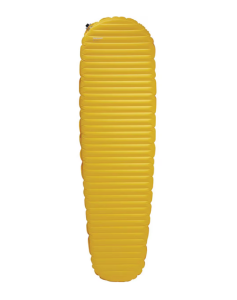
- Incredibly lightweight for a full-size pad
- WingLock
 valve for fast one-way inflation and easy micro-adjustments
valve for fast one-way inflation and easy micro-adjustments - Improved internal construction for a silent sleeping pad
- Includes pump sack and field repair kit
- Packs down to the size of a Nalgene
Why we like it: Lightweight, comfortable, and incredibly durable
What we don't like: Narrow, mummy-shape might not be for everyone
Weight: 13 oz | Thickness: 3 in | R-value: 4.5 | Type: Air | Sizes: Short, regular, large, wide
The Therm-a-Rest NeoAir XLite NXT Sleeping Pad ($209 for regular size), combines comfort with an incredibly light weight and is our overall pick for the best backpacking sleeping pad. Chelsey has been using the XLite NXT for over three years, averaging 40 to 50 days a year sleeping on it. The baffled construction keeps her back happy, and she loves how small it packs down, easily squeezing into any of her backpacks. While older versions tended to make a lot of noise when you were shifting around, Therm-a-Rest has updated its internal construction to achieve a near-silent sleeping pad.
The sleeping pad is surprisingly durable. Chelsey has yet to experience any leaks or tears in hers, despite dragging it across the Alaskan tundra and Utah's slickrock desert for years.
Best Budget Backpacking Sleeping Pad:
Big Agnes Divide Insulated Sleeping Pad
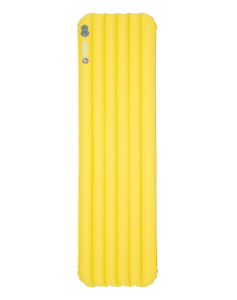
Features:
- I-Beam construction provides stability while reducing the weight
- Aviation-grade weld strength
- Thermolite® insulation with a heat-reflective film to trap body heat
- Great warranty program
Why we like it: Comfortable, packs down small, reasonably priced
What we don't like: Not the most durable sleeping pad, heavy
Weight: 23 oz | Thickness: 3.5 in | R-value: 4 | Type: Air | Sizes: Petite, regular, long, wide, double
Ilana has been using the Big Agnes Divide Insulated Sleeping Pad ($120 for regular) on her backpacking and car camping adventures for years. It has a similar R-value and packed size as the Therm-a-Rest NeoAir XLite, however, it weighs 10 ounces more. One of the reasons for the heavier weight is the rectangular shape, which may be more comfortable than the Therm-a-Rest NeoAir XLite's mummy shape for some people.
The Divide is made of durable, recyclable, double-ripstop nylon fabric and has aviation-grade welds. However, Ilana's pad has sprung a few leaks over the years. Luckily, Big Agnes has an impeccable warranty program and has fixed and replaced the pads for her.
At $120, it's significantly less than many other sleeping pads in this guide, making it a great budget buy for new backpackers. There's also an uninsulated version of the Big Agnes Divide (R-value 1.5) for only $90.
Check Price of the Divide Insulated at REI
Check Price of the Divide Uninsulated at Amazon
Best Backpacking Sleeping Pad for Cold Weather:
Therm-a-Rest NeoAir XTherm NXT
Features: 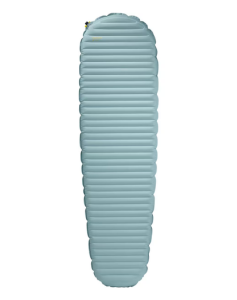
- One of the highest R-values on the market
- Current model is 2.3 ounces lighter than the previous
- Durable, with 70D nylon on the bottom and 30D ripstop nylon on the top
- WingLock
 valve for fast, one-way inflation and easy micro-adjustments for comfort
valve for fast, one-way inflation and easy micro-adjustments for comfort - Comes with a pump sack and field repair kit
Why we like it: Incredibly warm without sacrificing weight
What we don't like: Expensive, shape may be narrow for some bodies, particularly when coupled with a high-loft sleeping bag
Weight: 20 oz | Thickness: 3 in | R-value: 7.3 | Type: Air | Sizes: Regular, large, wide
Chelsey has been using the Therm-a-Rest NeoAir XTherm NXT Sleeping Pad ($239) as her sleeping pad for six seasons of Denali and Alaska Range guiding. With an R-value of 7.3, it's one of the warmest sleeping pads on the market. Coupled with a foam pad underneath, it makes the perfect sleep system for camping in the snow. Chelsey loves how lightweight and packable the sleeping pad is. It packs down to about the size of a Nalgene, making it easy to squeeze into already heavy mountaineering packs. The one-way valve and pump sack also make it easy to inflate and help saves her lungs at high altitudes.
Best Sleeping Pad for Side Sleepers:
Big Agnes Boundary Deluxe Insulated Sleeping Pad
Features: 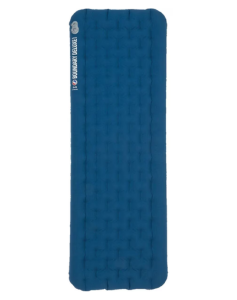
- Great for larger backpackers, comes in extra wide long
- Rectangular shape with bumpers means you won't roll off
- Comfortable for side sleepers
- Soft, quilted top and durable, ripstop nylon bottom
Why we like it: Durable and comfortable, cradles you while you sleep
What we don't like: Large rectangular footprint may not fit well in smaller tents, heavy
Weight: 25 oz | Thickness: 3.5 in | R-value: 4.3 | Type: Air | Sizes: Regular, long, wide, extra-wide
The Big Agnes Boundary Deluxe Insulated Sleeping Pad ($179 for regular) has a smooth, stable sleeping surface that is great for side sleepers. Our tester, Tanner, spent a month sleeping on the Deluxe in Southern California and liked how the inflatable bumpers kept him from rolling off the mat. He was also impressed with its durability; after a month of sleeping on loose gravel, his mat still held air. Big Agnes also offers wide and extra-wide sizes for larger-bodied backpackers. Tanner appreciated the extra room of the wide mat for his broad shoulders.
Best Basecamp Sleeping Pad:
Exped Megamat 10 Insulated Self-Inflating Sleeping Pad
Features: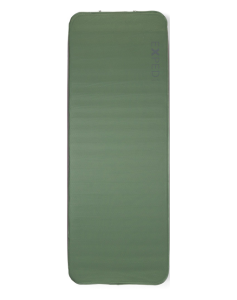
- Incredibly comfortable, with 4 inches of cushion
- Self-inflating for easy set-up, mini-pump included
- 3D construction for the largest possible sleeping surface
- Horizontal air chambers to reduce weight and packing size
- High R-value, suitable for four-season use
- Soft-stretch polyester surface for comfort
Why we like it: Self-inflating and incredibly comfortable
What we don't like: Expensive, heavy, can take a long time to inflate
Weight: 73 oz | Thickness: 4 in | R-value: 8.1 | Type: Open-cell foam | Sizes: Regular, long, wide, extra-wide
If you’re looking for the best basecamp sleeping pad, look no further than the Exped&subId2=explorersweb Megamat 10 Insulated Self-Inflating Sleeping Pad ($240). This self-inflating mattress combines memory foam padding with air to create one of the most comfortable sleeping pads on the market. While the Megamat is too heavy and bulky to carry backpacking, Chelsey uses it for basecamp climbing and skiing trips, as well as car camping. The 4 inches of cushion are plush, and the stretch top fabric is soft and comfortable, with no crinkly sounds if you move around while you sleep. The high R-value makes it a great option for camping in the snow or on-glacier. Exped claims it's suitable for winter camping down to -54°F, but take that with a grain of salt. Testers have found that below about -25˚F, the plastic inflation valve becomes extremely rigid and almost impossible to remove/re-engage. It's not just Exped; all large-valve mats have that issue at extreme temperatures.
It also has a double version, the Exped MegaMat Duo 10 Sleeping Pad. Chelsey has used this version on longer trips and loves how it covers almost the entire floor of smaller tents.
About our testing process
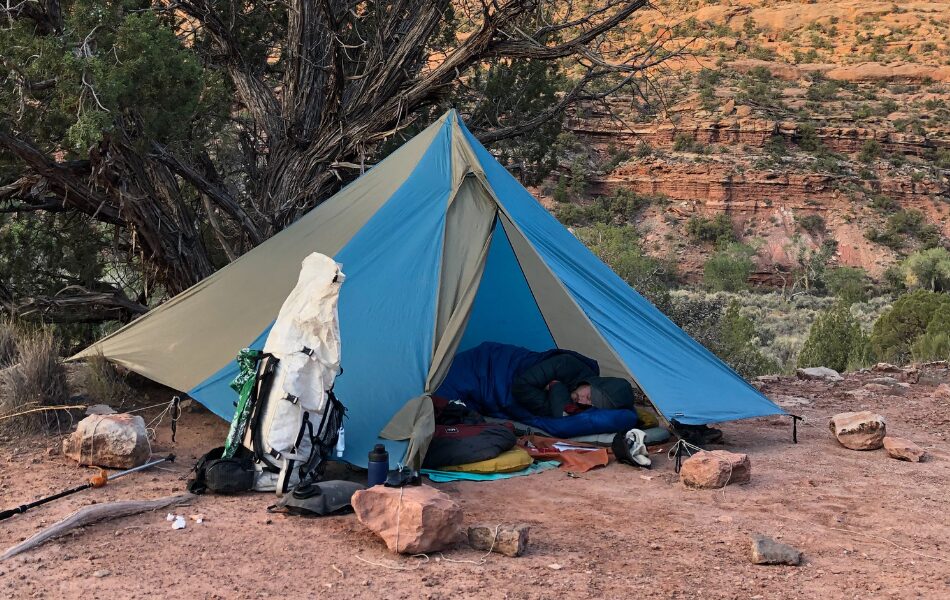
The ExplorersWeb gear team is full of hardcore backpackers and climbers. We've spent untold hours horizontal in tents, and have inflated and deflated more styles of sleeping pads than they can count. We've tested sleeping pads at 17,000 feet on Denali, as well as while backpacking in the Cascades of Washington, the canyons of Utah, the mountains of Peru, and everywhere in between.
Ilana Newman started this guide in October 2022. She's a finicky sleeper who works as a guide and outdoor educator, so she spends upwards of half the year camping out. She values comfortable sleeping pads to ensure she's well-rested. She's tried everything from ultralight sleeping pads to air mattresses and memory foam pads, and likes sleeping pads that provide a stable, soft surface that she can move around on.
Gear Editor Chelsey Cook took over this guide in May 2024. She has over fifteen years of experience backpacking and mountaineering. As a professional mountain guide in Alaska, Washington, and Peru, she spends more time than is probably healthy sleeping in tents. She prioritizes sleeping pads with a high R-value that are lightweight and durable enough to get her through multiple seasons.
She's tried the majority of the sleeping pads in this guide, using them while guiding on Denali and in the Alaska Range, bringing them on canyoneering trips in Utah, and sleeping on them in the Alaskan Arctic. She led the charge on testing backpacking pads for cold weather and side-sleepers, and our pick for the best overall backpacking sleeping pad is the very same pad she's basically been living on for the past three years.
We chose a range of backpacking sleeping pads for our guide, prioritizing weight, packability, durability, and comfort. We tested sleeping pads for winter use, side sleepers, and base camping.
Types of backpacking sleeping pads
Closed-cell foam pads
Anyone who’s ever camped on a budget probably recognizes closed-cell foam pads. They're made from highly dense foam with tiny air cells for extra cushion. Modern closed-cell foam mattresses may also have ridges and patterns to provide more comfort and some versions will come with a layer of reflective insulation for colder climates.
They're cheap and warm, but not that comfortable. Chelsey uses them under her Therm-a-Rest NeoAir XTherm NXT Sleeping Pad to boost warmth while winter camping.
Air pads
Air pads are the lightest and most compact choice for backpacking sleeping pads. When deflated, they simply roll up and get stashed in a stuff sack. They're lightweight and comfortable but can be expensive and are also the most vulnerable to punctures and leaky valves. Most brands include a field repair kit with their air pads.
Self-inflating pads
Self-inflating pads are often combined with open-cell foam to increase durability and decrease the chance of punctures. While the self-inflation is a nice touch, these pads are generally heavier and less packable than true air pads.
Features to look for in backpacking sleeping pads
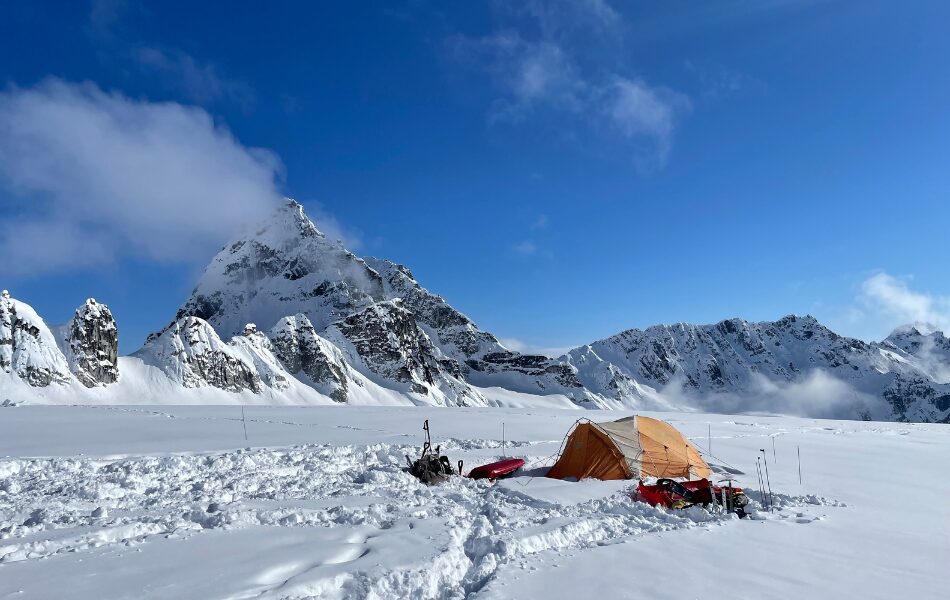
Size and shape
Most sleeping pad brands offer a variety of different sizes, from short to long, wide to extra wide. While most people can use the standard, regular-sized sleeping pads, being able to choose from a variety of sizes can help you save weight by downsizing to a short pad if you are a smaller person, or choosing a wider pad so you can sleep more comfortably if you are larger-bodied.
Backpacking sleeping pads typically come in two shapes: mummy or rectangular. Mummy sleeping pads are tapered, reducing the space the pad takes up in the tent. They are typically the lightest and most packable option, though the smaller sleeping surface may not work for everyone. Rectangular sleeping pads have a greater sleeping surface for additional comfort, but also take up more room both in your tent and in your backpack.
Inflation and deflation
Foam pads don't require inflation, but all other pads have an integrated air valve for inflation and relation. Most backpacking sleeping pads also come with one-way valves, making them easier to inflate and deflate. Some also come with inflation bags that you screw into the valve to inflate the mattress, rather than blowing the mattress up with your own lungs. These can be a great option, especially at high altitudes where you might be struggling to breathe already.
Some backpacking sleeping pads. are self-inflating, and are designed to fill up on their own. However, they usually need some extra, manual inflation to get them firm, and are generally heavier than other sleeping pads.
Weight and packability
Since you'll be carrying your backpacking sleeping pad, a general rule of thumb is the lighter the better. However, keep in mind that ultralight pads tend to not be as durable as mid-weight pads. Backpacking sleeping pads that balance lightweight and durability generally weigh between 12 and 25 ounces.
You should also consider what size your sleeping pad packs down to. Air pads, like the Therm-a-Rest NeoAir XLite NXT Sleeping Pad pack down as small as a Nalgene bottle. Foam and self-inflating pads, on the other hand, can be bulky, and may not fit well in every backpack.
Comfort
Without a decent night’s sleep, you’ll struggle to wake up in the morning, feel drained, and may even suffer from soreness, aches, or pains. If comfort is a priority for you, look for a backpacking sleeping pad that is at least 3 inches thick and has a soft sleeping surface. Some sleeping pads can also be really noisy when you move around, so if you're a light sleeper, go for a quieter model like the Therm-a-Rest NeoAir XLite NXT Sleeping Pad.
R-value
The R-value of a sleeping pad is the amount of insulation the pad offers between you and the ground, which directly affects the warmth of the sleeping pad. The higher the R-value, the warmer the sleeping pad. An R-value below 3 is suitable only for summer camping, while an R-value between 3 and 5 is good for three-season camping. For winter camping, you'll want a pad with an R-value of at least 5. We prefer something with an R-value closer to 7 or 8 for winter camping, like Therm-a-Rest NeoAir XTherm NXT Sleeping Pad.
Frequently asked questions about backpacking sleeping pads
What is the most comfortable backpacking sleeping pad?
Everyone has different comfort preferences when it comes to backpacking sleeping pads, depending on their bodies and what positions they sleep in. The most comfortable pad for you is the one that lets you get the best night's rest. If you can, test out different pads before making your purchase.
How heavy should your backpacking sleeping pad be?
Since you'll be carrying your backpacking sleeping pad, you want to choose one that is as light as possible without sacrificing too much comfort. Three-season pads are lighter than insulated four-season pads, but any sleeping pad between 10 and 25 ounces is suitable for backpacking.
How thick should your sleeping pad be?
The standard-sized backpacking sleeping pad is around three inches thick, whereas some car camping air mattresses can be eight or nine inches thick. If you're looking for something lightweight and packable, you may need to sacrifice thickness. But if you're only looking for comfort and don't mind the added weight, go as thick as you want, as long as it still fits in your backpack.
What is the best sleeping pad for side sleepers?
The best backpacking sleeping pad for side sleepers that we've tested is the Big Agnes Boundary Deluxe Insulated Sleeping Pad It has a smooth, stable sleeping surface and inflatable bumpers to keep you from rolling off.
There's nothing quite as satisfying as digging into a warm, hearty meal after a long day on the trail. And while it's fully possible to design your own meals with food available at the grocery store, there's something delightfully simple about buying pre-packaged backpacking meals. Lightweight, ridiculously simple to make, and packed with calories and flavor, backpacking meals are a great way to streamline your packing process and make meal-time tasty and painless.
Gear Editor Chelsey Cook has been backpacking and mountaineering for over 15 years, spending upwards of 100 days in the field some years. She's tried just about every backpacking meal out there, from Arctic MREs while she was stationed in Fairbanks with the U.S. Army to Backpacker's Pantry meals at 17,000 feet on Denali. The backpacking meals in this guide are some of her tried and true favorites that she reaches for season after season.
We've included backpacking meals that will suit many palettes and dietary needs, including gluten-free, vegetarian, and vegan potions, as well as bulk and budget backpacking meals if you're stocking up for a whole season.
Editor's Note: We updated this guide on May 23, 2024, to announce the Best Overall Backpacking Meal as the Peak Refuel Homestyle Chicken and Rice and the Highest Quality Backpacking Meal as the Heather's Choice Spinach Curry. We also included a new superlative, the Best Breakfast Backpacking Meal.
Our Picks for the Best Backpacking Meals of 2024
- Best Overall Backpacking Meal: Peak Refuel Homestyle Chicken and Rice
- Highest Quality Backpacking Meal: Heather's Choice Spinach Curry
- Best Vegetarian Backpacking Meal: Good To-Go Cuban Rice Bowl
- Best Vegan Backpacking Meal: Good To-Go Mushroom Risotto
- Best Breakfast Backpacking Meal: Peak Refuel Breakfast Skillet
- Best Bulk Backpacking Meals: Mountain House Classic Bucket
- Best Budget Backpacking Meal: Alpine Aire Forever Young Mac and Cheese
Best Overall Backpacking Meal:
Peak Refuel Homestyle Chicken and Rice
Features:
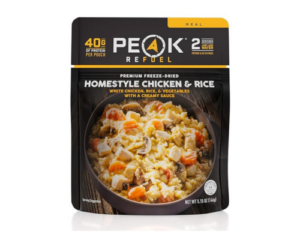
- 40 grams of protein
- 61 grams of carbohydrates
- 37 grams of fat
- 100% real meat with premium ingredients
- only requires 8 ounces of water to rehydrate
Why we like it: Delicious and easy on the stomach, doesn't take a lot of water to rehydrate
What we don't like: A little low on calories for bigger days
Calories: 740 calories | Dry weight: 5 oz | Prep time: 10 minutes
The Peak Refuel Homestyle Chicken and Rice ($14) gets the best-choice nomination for its taste, relatively low weight, and easy rehydrating. The homestyle chicken and rice is delicious and high-protein, and only requires 8 ounces of water to rehydrate. Chelsey finds this particular meal gentle on her stomach because it isn't heavily spiced, making it a great choice for particularly long days or high-altitude expeditions when you may not feel like eating.
Highest Quality Backpacking Meal:
Heather's Choice Spinach Curry
Features:

- 36 grams of protein
- 63 grams of carbohydrates
- 17 grams of fat
- Contains spinach, turmeric, and paprika, and organic chicken
- Gluten-free
Why we like it: High-quality ingredients and organic chicken
What we don't like: A little low on calories, takes a long time to cook
Calories: 540 calories | Dry weight: 5 oz | Prep time: 20 minutes
The Heather's Choice Spinach Curry($15) gets the nomination for the highest-quality backpacking meal. Heather's Choice is an Alaska-based, woman-owned company that specializes in handmade backpacking meals. All of their meals are also gluten-free. Their Spinach Curry includes organic chicken, as well as flavor powerhouses like ginger, garlic, and turmeric for a pleasantly spiced flavor. It also has ghee as an ingredient, which is an excellent source of vitamins, antioxidants, and healthy fats.
The high-quality meal comes at a small price, however, in that it takes 20 minutes to cook and only includes 540 calories.
Best Vegetarian Backpacking Meal:
Good To-Go Cuban Rice Bowl
Features: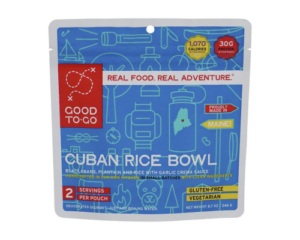
- 30 grams of protein
- 164 grams of carbohydrates
- 35 grams of fat
- Made in small batches
- Vegetarian and gluten-free
Why we like it: Surprisingly high calories, pleasantly spiced
What we don't like: Heavy for backpacking
Calories: 1070 calories | Dry weight: 8.7 oz | Prep time: 12 minutes
Not too spicy and just creamy enough, the Good To-Go Cuban Rice Bowl ($15) is a solid vegetarian and gluten-free backpacking food option for your next backpacking trip. Inside, you’ll find creamy garlic crema topping rice, beans, and plantains. It boasts an astonishing 1070 calories and 30 grams of protein, making it a great choice for dinner after a long, hard day of activity.
With all the extra calories, it is one of the heavier meals in this guide, weighing in at half a pound.
Best Vegan Backpacking Meal:
Good To-Go Mushroom Risotto
Features: 
- 13 grams of protein
- 64 grams of carbohydrates
- 20 grams of fat
- Made in small batches
- Vegan and gluten-free
Why we like it: Clean ingredients, tastes delicious
What we don't like: Takes a long time to cook
Calories: 820 | Servings: | Dry weight: 6.6 oz | Prep time: 20 minutes
Many meat-eaters have written off vegan backpacking food as boring, tasteless, or just plain bad. That’s certainly not the case with the Good To-Go Mushroom Risotto ($15). While it’s not quite the risotto we all know and love, it’s still an excellent, hearty backpacking meal, providing 820 calories and 13 grams of protein. It's also made with high-quality, pronounceable ingredients that are delicious. Our tester Rory particularly liked the chewy mushrooms.
This meal does take 20 minutes to cook, which is significantly longer than other meals in this guide. Our tester also mistakenly added too much water to this meal, and while it turned out fine, it would be nice to have an internal fill line on the packaging.
Best Breakfast Backpacking Meal:
Peak Refuel Breakfast Skillet
Features:
- 31 grams of protein
- 36 grams of carbohydrates
- 31 grams of fat
- 100% real meat
- 5 years shelf-stable
Why we like it: Delicious, easy to make, can be turned into breakfast burritos
What we don't like: Relatively low-calorie for long days
Calories: 540 calories | Servings: | Dry weight: 3.8 oz | Prep time: 10 minutes
The Peak Refuel Breakfast Skillet ($15) packs a punch, with scrambled eggs, pork sausage, potatoes, peppers, and onions, and is the perfect way to start a day of adventure. At less than 4 ounces and taking only 10 minutes to pack, it's a great way to liven up the mornings. Chelsey likes to bring tortillas on her trips to makes breakfast burritos using the Peak Refuel Breakfast Skillet.
Best Bulk Backpacking Meals:
Mountain House Classic Bucket
Features:
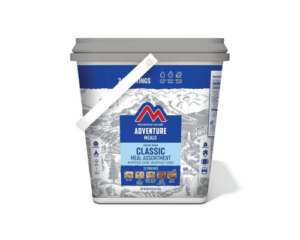
- Five varieties of meals, including breakfast
- No artificial colors or flavors
- 30-year taste guarantee
- Contains 12 meals, with 24 servings
Why we like it: Affordable, good variety, comes with reusable bucket
What we don't like: Only contains two breakfast meals
Calories: | Dry weight: 48 oz | Prep time: 10 to 12 minutes
When stocking up on backpacking meals for a big trip or general emergency preparedness, you can’t beat the Mountain House Classic Bucket ($126). This set comes with twelve pouches (24 suggested servings) of five different entrees from Mountain House. The included meals are Mountain House classics that are tried and tested, including beef stew, beef stroganoff with noodles, chicken fried rice, classic spaghetti, and granola. One of our favorite features of this option is the reusable bucket, which you can repurpose for storage or to pack out trash from your trip.
All the included meals, except the breakfasts, have meat, so it's not ideal for vegetarians or vegans.
See the Mountain House Classic Bucket on Amazon
See the Mountain House Classic Bucket on Walmart
Best Budget Backpacking Meal:
Alpine Aire Forever Young Mac and Cheese
Features:
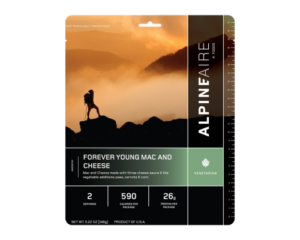
- 24 grams of protein
- 63 grams of carbohydrates
- 18 grams of fat
- Vegetarian
Why we like it: Delicious and inexpensive
What we don't like: The peas can be crunchy even after rehydrating
Calories: 590 | Dry weight: 5.2 oz | Prep time: 12 minutes
Pre-packaged backpacking meals can be expensive, and if you're going on a long trip the cost starts to add up. The Alpine Aire Forever Young Mac and Cheese ($10) tastes great and fills you up, at only two-thirds the price of other backpacking meals in this guide. It's our choice for the best budget backpacking meal. It's also vegetarian friendly, and there's an easy fill-line inside the packaging so you know exactly how much water to add.
The peas take longer to rehydrate than the other ingredients and can end up being very crunchy.
About our testing process
The ExplorersWeb testing team has collectively spent over 30 years backpacking, climbing, mountaineering, and, yes — making and eating backpacking meals. We've tried just about every backpacking meal on the market at this point.
Tuesday Kirby Kahl started this guide in May 2022. She's an avid outdoorswoman, backpacker, and climber, who has spent large chunks of her life in the wilderness. She's eaten a lot of backpacking meals over the years and enjoys how lightweight and easy they are. Many meals she recommended have fueled her backpacking and rock-climbing trips for the last several years. She loves that she can come back to camp after a long day and expend minimal energy on a nice, filling meal.
Gear Editor Chelsey Cook took over the guide in May 2024. Chelsey has worked as a mountain guide for the past six years and spends much of the year surviving off backpacking meals. As someone with a sensitive stomach who is frequently at high altitudes, she favors meals that are quick to make and not overly spiced. She also guides a lot of clients with dietary restrictions and looks for brands that offer vegetarian, vegan, and gluten-free meals.
We taste-tested all of the meals in the guide, chowing down with them on backpacking and mountaineering expeditions, taking them out for lunches on rock climbing trips, and digging in around the campfire with friends. We evaluated them for flavor, how quickly they rehydrated, and how they made us feel afterward. Finally, we curated this guide from our personal favorites, picking meals that we found ourselves craving over and over again. Then, because everyone has different tastes and preferences, we asked friends for their opinions and read reviews to get a view of how particular meals were received more broadly. Kirby also cooked up a smorgasbord of meals and enlisted co-testers Tad and Rory to give feedback on their favorite meals.
If any of the meals on this list pique your interest, we encourage you to explore that particular brand more and try other options, even if they were omitted here. While we believe this selection includes the best backpacking meals on the market, your palette may differ from ours.
Features to look for in backpacking meals

Calories and nutritional value
Depending on your given activity, your caloric needs may vary greatly. A lazy day at camp doesn't burn nearly as many calories climbing, backpacking, or skiing. Different backpacking meals come with vastly different calories, from 400 to over 1,000; look for one that matches your energy output. Keep in mind that if you're adventuring in cold weather, you'll need more baseline calories to keep warm than in hotter temperatures.
Quality of ingredients
We like our backpacking meals to be as close to the meals we cook at home as possible. All of the ingredients should be listed on the back of your backpacking meal, and you should recognize or be able to pronounce them. You'll also want to look for 100% real meat, like what's offered in the Peak Refuel Homestyle Chicken and Rice.
If there are certain ingredients you are sensitive to, read the ingredient list carefully. Also, keep in mind that your stomach may be sensitive at high altitudes; if you're in that particular environment, look for meals that aren't heavily spiced.
Serving size
Backpacking meals come in one or two servings. One serving pouches generally have under 500 calories and can be eaten as a snack or as part of a larger meal. Two servings typically provide enough food for one full meal for one person.
Cooking time
The cooking time for each meal varies, generally falling somewhere between 5 minutes and 20 minutes. We prefer shorter cook times, as there's nothing worse than waiting for your meal to rehydrated while you're exhausted and starving. We recommend always taste-testing your meal after rehydrating. Some ingredients take longer than others to rehydrate, so you may need to wait longer than indicated.
Dietary restrictions
If you have dietary restrictions, don't worry. Gluten-free, vegan, vegetarian, and soy-free backpacking meals exist and are as delicious and filling as their meat- and gluten-laden counterparts. Companies like Heather's&subId2=explorersweb Choice offer plenty of options.
Frequently asked questions about backpacking meals
What food to bring backpacking for 3 days?
Pre-packaged backpacking meals are a great option for any length backpacking trip because they typically weigh under 6 ounces and are calorie-dense. There are plenty of choices for breakfast and dinner to choose from, and you can also substitute them for lunches as well. If you'll be car camping, you can afford to bring heavier foods that require more complicated cooking.
How much water does it take to rehydrate meals?
Each meal varies. You could need anywhere from a few ounces to a few cups depending on how large the meal is and how many people it feeds. Some brands have easy-fill lines marked on their packaging, so you know exactly how much water to pour in.
What's the difference between freeze-dried and dehydrated backpacking meals?
Dehydration is an ancient method of preserving food that removes as much moisture as possible to keep food from decaying. Freeze-drying is a relatively new method, developed in the 1900s. It uses a mix of freezing and a moisture-vaporizing vacuum to preserve food. Freeze-dried food has a longer shelf life than dehydrated food, and generally tastes better. It also retains up to 97% of its nutrients, while dehydrated foods retain only 60 to 75%. Most backpacking meals are freeze-dried.
Are backpacking meals healthy?
Backpacking meals are crafted to be well-balanced and healthy, with plenty of protein, carbohydrates, and fats to fuel you. While some may seem more calorie-dense than meals you would typically eat at home, they are designed to be eaten after outdoor activities, like hiking, backpacking, climbing, or skiing.
If you are really health-conscious, look for backpacking meals that include vegetables and high-quality ingredients, like the Heather's Choice Spinach Curry.
Does backpacking food taste good?
We think so! The meals in this guide constitute some of the best-tasting backpacking foods we've come across. And, with so many different options on the market, there's something out there for every palette to enjoy.
How do I prepare backpacking meals?
Backpacking meals are typically prepared by adding water, usually heated, to the pouch and letting it sit for 10 to 20 minutes. Your meal pouch will come with instructions on how to prepare that specific meal.
If you spend a lot of time outside, regardless of whether you live in a sunny climate or not, you know the importance of a quality pair of sunglasses to protect your eyes from UV light and prevent eye strain. Polarized sunglasses take this a step further by reducing glare from flat surfaces like water and snow, making them a critical piece of gear skiing, mountaineering, packrafting, canoeing, and other adventures. They're also a great everyday option for driving.
With so many different sunglasses on the market, it can be difficult to know which pair to choose. To help you pick, we tested dozens of sunglasses all over the country, from skiing in the Cascades to rock climbing in the Southwest. We've run at 14,000ft, where the sun's rays are more intense, and we've swam, fished, and paddle-boarded on lakes and rivers where polarized lenses help cut the glare from the water's reflective surface. The sunglasses we chose for this guide are made for a variety of different purposes, from everyday wear to running, biking, and skiing. We also chose polarized sunglasses in a range of different shapes and materials.
Editor's Note: We updated this guide on May 15, 2024, to announce the Roka Rory 2.0 Sunglasses as our Best Overall Polarized Sunglasses, and the Goodr OGs Polarized Sunglasses as our Best Budget Polarized Sunglasses. We also added superlatives for Most Protective Polarized Sunglasses and Best Polarized Sunglasses for Biking and Skiing.
Our Picks for the Best Polarized Sunglasses of 2024
- Best Overall Polarized Sunglasses: Roka Rory 2.0 Sunglasses
- Best Polarized Sunglasses Runner-Up: Bajio Cometa Polarized Sunglasses
- Best Everyday Polarized Sunglasses: Ray-Ban Original Wayfarer Polarized Sunglasses
- Best Polarized Aviator Sunglasses: Ray-Ban Aviator Classic Polarized Sunglasses
- Most Protective Polarized Sunglasses: Wiley X Founder Polarized Sunglasses
- Best Sunglasses for Biking and Skiing: Smith&subId2=explorersweb Wildcat Sunglasses
- Best Budget Polarized Sunglasses: Goodr OGs Polarized Sunglasses
Best Overall Polarized Sunglasses:
Roka Rory 2.0 Sunglasses
Features: 
- Durable, lightweight, and flexible with high-impact strength
- Chemical and sweat-resistant
- GEKO Pads
 on the temples and nose for extra traction
on the temples and nose for extra traction - 1,000-day warranty
- Scratch resistant
- Hydrophilic properties - tackier when wet or sweaty
Why we like them: Incredibly lightweight, stay in place while running and jumping, sweat resistant
What we don't like: Expensive, don't offer the most coverage
Frame material: Nylon | Lens material: Polycarbonate | VLT: 9 to 17%
Chelsey has been using the Roka Rory 2.0 Sunglasses ($220) as her daily-wear polarized sunglasses for years. When she finally stepped on and snapped the arm of her original pair, she tried a few other sunglasses before going right back to the Rokas. She loves how lightweight they are, and that they don't bounce on her face while running. The frames are also low enough profile to fit easily under the brim of a baseball cap or a helmet.
The Roka Rory's have several lenses to choose from, with a range of VLT percentages. The lenses themselves are startlingly clear, and offer a crisp view with a wide field of vision. They're fog-resistant, making them a great choice for sweaty adventures.
Best Polarized Sunglasses Runner-Up:
Bajio Cometa Sunglasses
Features:
- Blocks 95% of bad blue light
- LAPIS
 lens technology
lens technology - Ergo, non-slip rubber nose pads
- Comfortable barrel hinges
- Glare-blocking frames
- Carbon neutral company
Why we like them: Excellent color-enhancing protection, scratch-resistant lenses
What we don't like: Expensive, thick frames
Frame material: Nylon | Lens material: Polycarbonate or glass | VLT: N/A
The Bajio Cometa Sunglasses ($209), which are specifically designed for long days on the water, are a stylish and functional addition to anyone’s sunglass arsenal. They feature high-quality frames in a few different colors, and you can choose between polycarbonate and glass lenses, as well as a variety of tints. Ilana has the pink gloss frame and blue mirror lens combination, and they're great for everyday use, as well as fishing, paddleboarding, and river trips. Ilana also wore them to protect her sensitive eyes after she suffered a major concussion, and liked how much of the sun's glare they blocked. A built-in sun ledge on the interior offers even more protection.
The frame is made of bio-based nylon and is sturdy, lightweight, and sits comfortably on your face. We also love the rubber nose pads, five-barrel hinges, and hidden rubber temple tips.
Best Everyday Polarized Glasses:
Ray-Ban Original Wayfarer Polarized Sunglasses
Features:
 Polarized and coated with 100% UV protection
Polarized and coated with 100% UV protection- Unisex acetate frame
- Different frame sizes available
- Crystal Lens
- Case and lens cloth included
Why we like them: High quality and comfortable, classic design
What we don't like: Frames feel heavy and can bounce when running
Frame material: Acetate | Lens material: Glass | VLT: 15%
Ray-Ban Wayfarers ($180) are classically shaped sunglasses that look good on just about anyone. Multiple-sized frames allow you to pick the one that best fits you, and there are also plenty of lens options. The legendary Ray-Ban polarized lenses provide complete UV protection while reducing glare and eye strain, and improving contrast and clarity. The crystal lenses are scratch-resistant and extremely durable.
The Ray-Ban Wayfarers, with their classic look and high-quality lenses, are a great option for everyday sunglasses.
Best Polarized Aviator Sunglasses:
Ray-Ban Aviator Classic Polarized Sunglasses
Features: 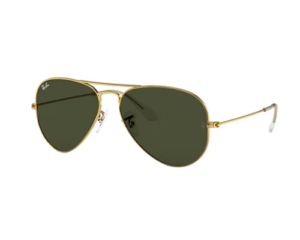
- Adjustable nose pads
- One of the most iconic sunglass models in the world
- Available in prescription lenses
- Available in multiple sizes
Why we like them: Incredibly lightweight, sweat-resistant
What we don't like: Expensive, may not be suitable for running and high-impact sports
Frame material: Metal | Lens material: Glass | VLT: N/A
Propelled back to popularity in the 1980s thanks to the movie Top Gun, Ray-Ban Aviators ($180) are arguably the world’s most iconic sunglasses. Originally designed for pilots back in 1938, they’ve stood the test of time and have retained their popularity thanks to their classic look and crystal-clear lenses. The thin metal frame with the instantly recognizable inverted teardrop lens has spawned a host of imitators — none of which live up to the quality and style of the original.
With plenty of different sizes, lenses, and frame colors to choose from, this is a design that suits just about any face shape. The polarized glass lenses improve clarity and contrast while reducing glare and providing UV protection.
Most Protective Sunglasses:
Wiley X Founder Polarized Sunglasses
Features: 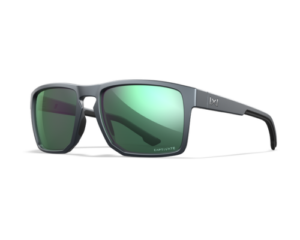
- 100% protection from UVA and UVB with distortion-free clarity
- ANSI Z87.1 safety standards rated
- Lightweight frame
- Removable side shields
Why we like them: Safety glasses rated, full coverage
What we don't like: Expensive, may feel large on smaller faces
Frame material: Nylon | Len material: Polycarbonate | VLT: N/A
Wiley X is a family-owned and veteran-founded company dedicated to creating protective, tactical eyewear that also looks good. The Wiley X Founder Sunglasses ($206) are Chelsey's favorite full-coverage sunglasses. The frames are lightweight with a sleek look and dual-injected rubber temples for a no-slip fit.
Wiley X's entire range of eyewear meets or exceeds industry standards for safety and optics and the Founders have ANSI Z87.1-rated frames, so they can double as safety glasses. Their full-coverage lenses and the removable side shields for the frames also make these sunglasses an ideal choice for high-speed activities such as cycling, skiing, and snowboarding. The polarized lenses can be swapped for custom prescription lenses as well.
Best Sunglasses for Biking and Skiing:
Smith Wildcat Sunglasses
Features: 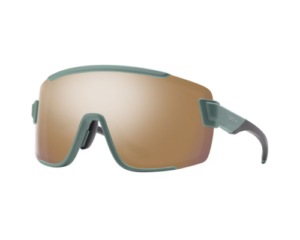
- Performance sunglasses made for cycling, running, and biking
- Hydroleophobic coating resists water, oil, and smudges
- Temple and nose pads are designed for a secure fit when sweating
- Bonus, interchangeable clear lens for cloudy days
Why we like them: Full coverage frame inspired by ski goggles, secure fit that doesn't bounce
What we don't like: Expensive, frames can be tricky to swap in and out
Frame material: Bio-based plastic | Len material: Polycarbonate | VLT: N/A
The Smith Wildcat Sunglasses ($225) are Chelsey's favorite glasses for mountain biking, trail running, and backcountry skiing. The full-coverage lens has a slight wrap-around fit, which protects her eyes and keeps them from watering at higher speeds. The ChromoPop lens also enhances natural colors for sunny days and there's a bonus clear lens for cloudy days when you want eye protection without a tint. With grippy nose pads and temples, these polarized frames won't slip when bounced around or when you're sweaty.
lens also enhances natural colors for sunny days and there's a bonus clear lens for cloudy days when you want eye protection without a tint. With grippy nose pads and temples, these polarized frames won't slip when bounced around or when you're sweaty.
Smith also offers the Bobcat Sunglasses, which are made for smaller faces.
Best Budget Polarized Sunglasses:
Goodr OGs Polarized Sunglasses
Features: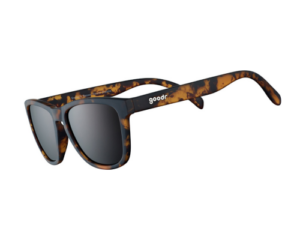
- Glare-reducing lenses that block 100% of harmful UVA and UVB rays
- Classic frame shape with timeless appeal
- Lightweight with a comfortable, no-bounce fit
- Grip-coated frame to prevent slippage when sweating
- Biodegradable, organic lenses
- Climate Neutral Certified brand
Why we like them: Inexpensive, comfortable, and relatively high-performing
What we don't like: Lenses don't have the same clarity as more expensive glasses
Frame material: Copolyester | Lens material: Triacetate cellulose | VLT: N/A
The Goodr OGs Polarized Sunglasses ($25) are less than a quarter of the price of other sunglasses on this list. They're still surprisingly high-performing, making them our pick for the best budget polarized sunglasses. Goodr OGs have a classic, lightweight square frame that comes in a variety of colors. The lenses are non-reflective, which reduces glare, and have a scratch-resistant and shatterproof layer. Compared to more expensive sunglasses, the cellulose lenses lack a little clarity and crispness, but that's to be expected at such a low price. Chelsey keeps a pair of Goodrs in her truck and uses them for packrafting, bushwhacking, and other outdoor adventures where she's likely to lose or scratch her glasses. Since a pair of Goodrs only costs her $25, she can beat them up guilt-free.
Honorable mentions
Sunski Dipsea Polarized Sunglasses
Features:
- Recycled, superlight polycarbonate frame
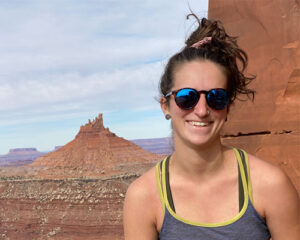
- 100% UV-protected lens
- Interchangeable lenses
- Lifetime warranty
The Sunski Dipsea Polarized Sunglasses ($58) have been Ilana's go-to sunglasses for years. They are an affordable option that doesn't sacrifice quality. They have interchangeable lens options, and, if you scratch or damage the lenses, you can buy new ones without having to purchase a new pair of sunglasses.
Sunski created their own lightweight, recycled material for their frames. The frames also come with a Lifetime Warranty, which includes getting eaten by your dog or dropped off a cliff — they’re designed for adventure and the lifestyle you live. Read Ilana's in-depth review of the Sunski Dipseas here.
About our testing process
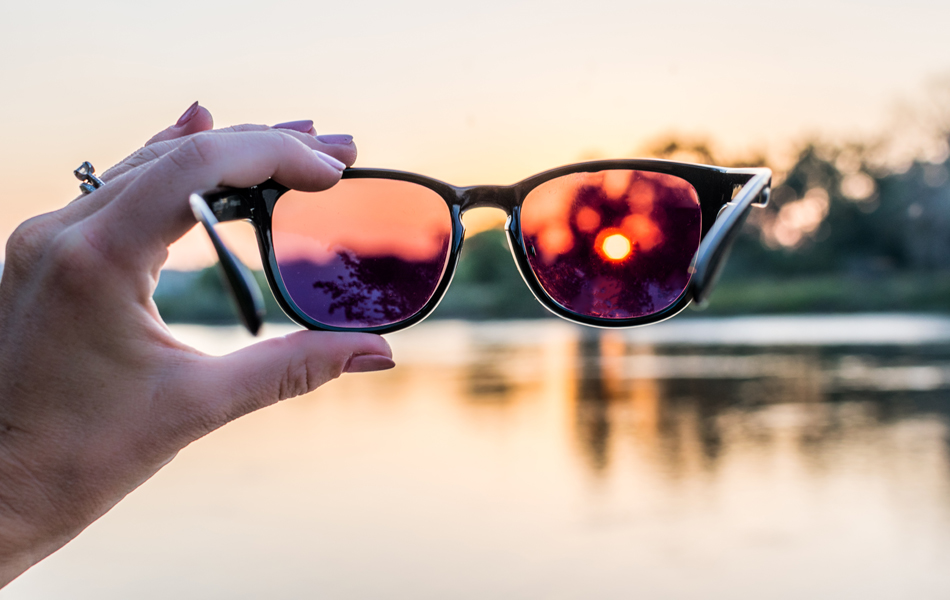
The ExplorersWeb team has tested dozens of polarized sunglasses all across the country, from skiing in the Cascades to rock climbing in the Southwest to packrafting in Alaska. We've tested them at high altitudes, where the sun's rays are more intense, and we've swam, fished, and paddle-boarded on lakes and rivers where polarized lenses help cut the glare from the water's reflective surface.
Ilana Newman started this guide in 2022. She lives in southwest Colorado, where the sun shines more days than not. A good pair of polarized sunglasses is a must for outdoor adventures there, and Ilana takes her eye protection seriously, whether she's climbing in the red rock deserts or skiing in the San Juans. She's known for being rough on her gear and prioritizes durable sunglasses that will last more than one season.
Gear Editor Chelsey Cook took over the guide in May 2024. She's a mountain guide in Alaska and spends most of the year on the snow or the water, and relies on sunglasses to keep her eyes safe. She also has very sensitive eyes and is rarely without sunglasses even in her daily life. Because she wears them so often, she needs comfortable, lightweight sunglasses that offer maximum protection and don't bounce on her face when she's running or biking. She tried most of the sunglasses in this guide, and the top picks represent her favorites after years of testing them while hiking, trail running, biking, skiing, and mountaineering.
We chose the sunglasses on this list after extensive research and testing. When testing sunglasses for comfort, we wore the sunglasses for hours at a time and assessed for any headaches or discomfort afterward. We also ran and biked in the sunglasses to make sure they didn't bounce on our faces, and checked the lenses after bushwhacking in them to make sure they didn't scratch easily.
Our guide includes polarized sunglasses for both casual wear and performance sports, in a range of frame shapes and sizes.
Features to look for in polarized sunglasses

Shape and design
Frame shape and design dictate the aesthetics of a pair of sunglasses, and depending on your preference, you may want square frames or round. Shape and design also have an impact on performance. Wide, large lenses provide more protection from the sun and are ideal for snow and water adventures, where the sun's rays can be more intense. Wraparound frames, or frames with side shields like the Wiley X Founder Polarized Sunglasses, which are also safety-rated, offer the most protection.
Frame material
Frame material affects the appearance and weight of sunglasses. The majority of polarized sunglasses we tested are made from different plastics, including nylon and polyester. Plastic is lightweight and durable, making it a great material for sunglasses for running, hiking, and biking. Some sunglasses are also made of plant-based plastics, like cellulose acetate, which is more sustainable, hypoallergenic, strong, lightweight, and flexible. Metal, used in the Ray-Ban Aviator Polarized Sunglasses, is a durable frame material but can be more expensive.
Lens material
Sunglass lenses come in a few different materials, and each one differs in their performance and clarity. Acrylic is the most affordable but, while lightweight, is less durable and has less optical clarity. Polycarbonate, which is used in the Smith Wildcat Sunglass lenses, is affordable and lightweight with good impact resistance and clarity but is less scratch-resistant than other options. Lastly, glass has the most clarity but is the most expensive. It's also heavier than other options and can "spider" when cracked, like a windshield.
Visible light transmission (VLT)
Sunglass lenses generally have a specification known as VLT, or visible light transmission. This is the percentage of light that reaches your eyes through the lens. The smaller the percentage, the less light is transmitted through the lens. If you have sensitive eyes or will be using your sunglasses while on snow or water, look for sunglasses with a low VLT percentage. Glacier glasses, which are designed to offer the maximum protection for your eyes, have a VLT between 5 and 7%. While great for those specific conditions, they are typically too dark for daily wear. A VLT of 10 to 25% is a good choice for general outdoor use.
Price
Sunglasses come in a range of prices, from $25 to over $200. Cheaper sunglasses generally lack the lens clarity and high-quality frames of more expensive choices but are a great option if you don't use sunglasses often, or have a tendency to lose or break them. More expensive sunglasses generally have crystal-clear lenses that don't distort your vision. They also may have features like rubber grips to prevent slipping, adjustable nose pads, and interchangeable lenses. If you wear sunglasses daily or have very sensitive eyes, you may want to opt for a pricier, higher-performing pair.
Frequently asked questions about polarized sunglasses
How do polarized lenses work?
Polarized lenses absorb reflected light, such as the light that bounces off of water, snow, or any other highly reflective surface. They only allow light in from one direction and reduce glare by blocking all horizontal light, like the light that bounces off of smooth water or shiny surfaces.
How can I tell if lenses are polarized?
There's an easy trick to tell if your new lenses are polarized or not. Find a reflective surface, such as water, metal, or glass, and hold the glasses away from your face slightly. Tilt the glasses 60 to 90 degrees. If the lenses shift to black, then they are polarized. You should also notice a difference when looking at an LCD screen with polarized glasses.
Does the polarized coating on sunglasses wear off?
The polarization does not wear off unless the lenses chip or crack. However, the protective coating that blocks UV rays can gradually wear off.
Are there any downsides to polarized lenses?
Polarized sunglasses are not for everyone nor are they for every situation. They can distort your vision by showing unusual patterns in certain conditions. They can also make it difficult to differentiate ice from snow, and some skiers may prefer non-polarized lenses. Polarized lenses are also not the best for looking at screens, as the light filtering process can make the screen disappear from view at certain angles.
Is 100% UV protection the same as polarized?
No. Your sunglasses can be 100% UV protected and not be polarized, and vice versa. Polarization is not the same as UV protection, however many polarized lenses now also have a UV-blocking feature.
Sleeping bags have the unique ability to make or break an outdoor adventure. Having a warm, dry place to sleep at night is the key to enjoying a trip, whether it's leisurely weekend car camping with the family or a thru-hike on the Pacific Crest Trail.
The ExplorersWeb team has tested over a dozen sleeping bags to help find the right one for you. We tested three-season and summer sleeping bags with temperature ranges from 15° to 30°F, putting them through their paces in the lush mountains of Washington and Peru, the wet tundra above the Arctic Circle in Alaska, and the high mountains of Peru. We looked at both synthetic and down insulation, as well as various shapes of sleeping bags, and took them car camping and backpacking to test their versatility.
In this guide, we recommend our favorite sleeping bags and include helpful advice and answers to frequently asked questions to help you make your own decision.
Editor's Note: We updated this guide on May 20, 2024 to ensure that our product selection and buying advice were up to date with 2024's market. We created new categories, including Best Down Sleeping Bag and Best Synthetic Sleeping Bag. The Feathered Friends Egret UL 20 Women's Sleeping Bag was also chosen as our Best Women's Sleeping Bag after several years of testing, and our Best Value Sleeping Bag is now the Mountain Hardware Bishop Pass 15 Sleeping Bag.
Our Best Sleeping Bags Picks:
- Best Down Sleeping Bag: REI Co-op Magma 15 Sleeping Bag
- Best Synthetic Sleeping Bag: Nemo Forte 20 Sleeping Bag
- Best Sleeping Bag for Women: Feathered Friends Egret UL 20 Women's Sleeping Bag
- Most Versatile Sleeping Bag: Big Agnes Lost Ranger 3N1 15 Sleeping Bag
- Best Wearable Sleeping Bag: Sitka Gear Kelvin Aerolite 30 Sleeping Bag
- Best Double Sleeping Bag: Stoic Groundwork Double Sleeping Bag
- Best Sleeping Bag for Car Camping: REI Co-op Siesta Hooded 20 Sleeping Bag
- Best Value Sleeping Bag: Mountain Hardware Bishop Pass 15 Sleeping Bag
Best Down Sleeping Bag:
REI Co-op Magma 15 Sleeping Bag
Features: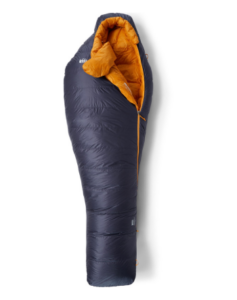
- Contains recycled and bluesign® approved materials
- Nine different sizes available, from short-narrow to long-wide
- Contoured hood that shapes and cinches around your face
- Zipper wraps around the front for easier zipping
- Interior stash pocket for small items
- Shaped foot box with room to move your feet
Why we like it: Very warm and size-inclusive
What we don't like: Not as lofted as other down bags
Shell: 15D recycled ripstop nylon | Insulation: bluesign® approved down | Weight: 2.5 lbs | Packed Volume: 6 to 9L, depending on size | Comfort Temperature Rating: 21°F | Lower Limit Rating: 9°F | Sizes: short (5'4"), medium (5'9"), long (6'4"), as well as narrow and wide
Chelsey's favorite down sleeping bag is the REI Co-op Magma 15 Sleeping Bag ($429). It's her go-to sleeping bag when she's guiding backpacking trips in northern Alaska, where the lower temperature rating compared to other 15° bags keeps her warm when nighttime temperatures dip. Even with its additional insulation, the Magma 15 is lightweight and compresses down into a surprisingly small package, making it a great option for longer trips and heavier backpacks.
It's also environmentally friendly, with a shell made from recycled nylon and bluesign® approved down fill. The updated Magma 15 comes in a huge range of sizes, from short and narrow to long and wide, so you can pick the perfect size for your body.
Best Synthetic Sleeping Bag:
Nemo Forte 20 Sleeping Bag
Features: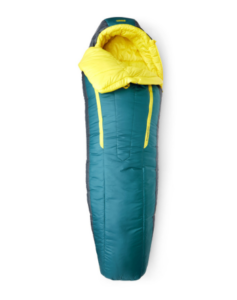
- bluesign® approved DWR shell
- 100% recyclable synthetic insulation
- External draft collar to keep your neck warm
- Integrated pillow pocket
- Designed to be comfortable for side sleepers
- Thermo Gills
 with multistage zippers to increase temperature comfort range
with multistage zippers to increase temperature comfort range
Why we like it: Sustainable, budget-friendly with plenty of features
What we don't like: Bulky synthetic insulation
Shell: 30D recycled ripstop polyester | Insulation: Synthetic | Weight: 2.5 lbs | Packed Volume: 9L | Comfort Temperature Rating: 30°F | Lower Limit Rating: 20°F | Sizes: regular (6'), long (6'6")
The Nemo Forte 20 Sleeping Bag ($190) is our favorite synthetic sleeping bag. Nemo upped the sustainable sleeping bag game, prioritizing the use of recycled and reclaimed materials. The Forte shell is bluesign® approved and made of 100% recycled polyester, while the insulation is made from 100% post-consumer recycled content.
Despite using synthetic insulation, the sleeping bag is relatively light. There are also plenty of features, including zippered vents with multistage zippers that you can unzip to cool down on warmer nights. A draft collar tucks in around your neck to keep you warm, or folds down like a blanket to cool you off. An integrated pillow pocket keeps your pillow in your bag while sleeping. We’re also fans of the reasonable price and that the Nemo Forte 20 is available in men's and women's sizes.
Best Sleeping Bag for Women:
Feathered Friends Egret UL 20 Women's Sleeping Bag
Features: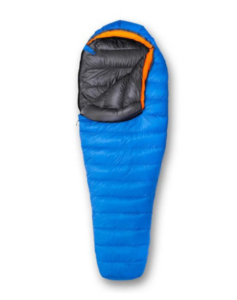
- Designed for women, with tailored fit and extra down at the feet and chest
- Trapezoidal foot box lets your feet rest in a natural position
- Generous draft tube to prevent air from seeping in at the zipper
- Hood opens wide on warmer nights and cinches tight for dropping temps
- Ethically sourced down
Why we like it: High quality, lofted down, lightweight
What we don't like: Expensive, sizing may not fit everyone
Shell: 10D pertex endurance UL | Insulation: Ethically harvested down | Weight: 1.9 lbs | Packed Volume: 9L | Comfort Temperature Rating: 20°F | Lower Limit Rating: N/A | Sizes: small (5'3"), medium (5'9")
The Feathered Friends Egret UL 20 Women's Sleeping Bag ($589) is Chelsey's pick for the Best Sleeping Bag for Women. She's been a Feathered Friends convert for six years, and spends upwards of 100 days a year in their bags. The Egret UL 20 is one of her summer bags, and she loves how warm and light it is.
The Egret is tailored for the female form, with more room at the hips and elbows, and extra down in the foot box and chest to keep you warmer. Chelsey particularly likes the large draft tube down the side of the bag, which prevents cold air from sneaking past the zipper. There's also extra cushioning around the collar to help trap heat in at your neck. All in all, the bag is incredibly toasty, with the highest quality down filling. At 950+ fill power, the down used in the Egret is warmer per square inch than other down options. This means less fill is needed, making the Egret the lightest sleeping bags on our list.
It's available in small (5'3") and medium (5'9") sizes, as well as a 30° temperature rating.
Check Price at Feathered Friends
Most Versatile Sleeping Bag:
Big Agnes Lost Ranger 3N1 15 Sleeping Bag
Features: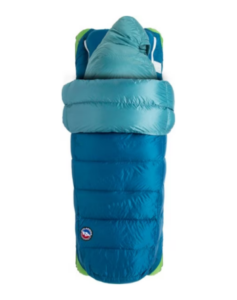
- Three-in-one sleeping bag system
- Inner and outer bags have different temperature ratings
- Attachment system for a sleeping pad
- Great for side sleepers
- PFAS-free water repellent finish
- Also comes in women's sizes
- Available in 0°, 15°, and 30° (women's only) temperature ratings
Why we like it: Suitable for a wide range of temperatures, roomy and comfortable for side sleeping
What we don't like: Sleeping pad attachment system won't work with every pad
Shell: Polyester | Insulation: Synthetic Primaloft, 35% recycled | Weight: 2.8 lbs | Packed Volume: N/A | Comfort Temperature Rating: 27°F | Lower Limit Rating: 15°F | Sizes: regular (6'), long (6'6")
While most of us have several sleeping bags with different temperature ratings, the Big Agnes Lost Ranger 3N1 15 Sleeping Bag ($399) is a great way to slim down your sleeping bag quiver. It's a modular bag system that provides you with one quality system for most adventures. An inner and outer bag combine to create three different bag configurations, depending on the temperature. The inner bag is a mummy bag that mimics Big Agne's Sidewinder bag, perfect for side sleepers. Used alone, it's rated to 35°. The outer bag is a classic rectangular bag, and used alone it's rated to 50°. Used together, the bags are rated to 15°. There's also a cinching system to attach your pad to your sleeping bag for extra stability.
Both the inner and the outer sleeping bags have 650 fill down insulation, with a PFAS-free water-repellent chemistry. There's also a women's version, called the Big Agnes Roxy Ann 3N1 15 Sleeping Bag. It's available in two sizes, regular (5'5") and long (6'), and is one of Kirby's favorite women's sleeping bags.
Best Wearable Sleeping Bag:
Sitka Gear Kelvin Aerolite 30 Sleeping Bag
Features: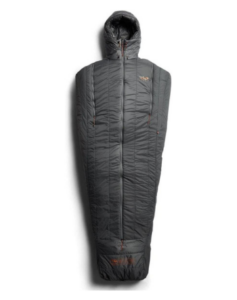
- Lightweight and wearable
- Front two-way zipper
- DWR finish to repel water
- Armholes positioned for functional mobility
- Form-hugging mummy shape
- Foot box can be opened and shortened for walking
Why we like it: Fully featured wearable sleeping bag, perfect for sitting at camp and sleeping
What we don't like: Expensive, not warm enough for spring or fall in most areas
Shell: 20D polyester | Insulation: 35% recycled synthetic | Weight: 2.4 lbs | Packed Volume: N/A | Comfort Temperature Rating: 30°F | Lower Limit Rating: N/A | Sizes: regular (6'), long (6'6")
Wearable sleeping bags have armholes and an open bottom, allowing you to keep your arms free and even walk around. Our favorite is the Sitka Gear Kelvin Aerolite 30 Sleeping Bag ($300). Kirby loved how she could sit by the campfire, walk around camp, and even brew her morning coffee, all without ever leaving her sleeping bag. The foot box zips open, and there's a hidden hook in the middle of the bag to shorten the sleeping bag for walking. There's also an adjustable hood, a shaped foot box, and every zipper can be unzipped from both inside and outside the bag.
The classic mummy shape of the bag locks in heat while the synthetic down keeps you warm even when wet. The shell is made from durable 20D polyester with a DWR finish to help repel moisture. However, it's not the warmest bag on the market, and was designed mostly to be used with other Sitka layers to boost the temperature.
Best Double Sleeping Bag:
Stoic Groundwork Double Sleeping Bag
Features:
- Synthetic shell with a water-repellent finish
- Two interior stash pockets for storage
- Soft, cozy interior lining
- Synthetic fill for insulation even in wet conditions
- Unzip into two bags for versatility
Why we like it: You can unzip it into two separate bags
What we don't like: Only suitable for warm temperatures, comfort rating is only 43°F
Shell: 20D ripstop nylon | Insulation: Synthetic | Weight: 5.6 lbs | Packed Volume: N/A | Comfort Temperature Rating: 43°F | Lower Limit Rating: 20°F| Sizes: one size (6'3")
The Stoic Groundwork Double Sleeping Bag ($109) is a double-wide sleeping bag with room for two, a perfect excuse to get your partner to snuggle more. There's a DWR finish to repel water and synthetic insulation retains heat even when wet. Though the bag is light on features, there is an internal stash pocket on each side of the bag, and the double bag unzips into two separate sleeping bags if you'd rather sleep apart.
The Stoic Groundwork Double Sleeping Bag only has a comfort rating of 43°, so reserve it for warmer nights.
Best Sleeping Bag for Car Camping:
REI Co-op Siesta 25 Hooded Sleeping Bag
Features:
- BlueSign approved shell and fill
- Insulated hood with drawstring
- DWR finish to repel water and stains
- Inner stash pocket
- Two-way main zipper, with a short side zipper to fold down the top
- Plenty of room to sprawl out
- Insulation and shell is 98% recycled
Why we like it: Incredibly roomy, made with recycled materials
What we don't like: Too bulky for backpacking
Shell: Recycled polyester | Insulation: Synthetic recycled polyester | Weight: 5.4 lbs | Packed Volume: 17.7 L | Comfort Temperature Rating: N/A | Lower Limit Rating: 20°F | Sizes: regular (6'), long (6'6")
When it comes to the most bang for your buck, the REI Co-op Siesta 20 Hooded Sleeping Bag ($139) shines as a car camping bag. This was one of our favorite unisex bags, with a roomy, rectangular shape that gave us plenty of room to stretch out. The insulated hood adds warmth, while a drawstring helps pull it tight during particularly cold nights. There's also an interior stash pocket for storing small items like your phone while sleeping.
The Siesta Sleeping bag is also environmentally friendly, with 98% recycled polyester fill and a recycled polyester shell that's treated with a DWR to help repel stains and moisture. Both the shell and the insulation contain materials that meet bluesign® criteria, and REI is Climate Neutral Certified.
At over five pounds, this sleeping bag is too heavy and bulky for backpacking but is a great budget option for car camping.
Best Value Sleeping Bag:
Mountain Hardware Bishop Pass 15 Sleeping Bag
Features:
- Internal stash pocket for storage
- Shaped draft collar and down face gasket to keep cold air out
- Contoured foot box for natural positioning
- Loops to attach to a sleeping pad
- Glow-in-the-dark zipper
- Men's and women's sizes available
Why we like it: Offers warmth and plenty of features at a competitive price
What we don't like: Heavier than other down backpacking bags
Shell: 20D ripstop nylon | Insulation: Fluorine-free, responsible down | Weight: 2.5 lbs | Packed Volume: 8 L | Comfort Temperature Rating: 26°F | Lower Limit Rating: 15°F | Sizes: regular (6'), long (6'6")
The Mountain Hardware Bishop Pass 15 Sleeping Bag ($285) is a great do-it-all bag for those who want a sleeping bag they can backpack, camp, and travel with. It offers a surprising amount of warmth, as well as great features like a glow-in-the-dark zipper and a generous draft collar, all at a competitive price compared to other down bags. While it's not the lightest down bag on the market, Chelsey has used the Bishop Pass backpacking and likes that it compressed down to a relatively small size for a mid-weight bag.
The Bishop Pass 15 is available in men's and women's sizes. The women's version is narrower at the shoulders and wider at the hips, and comes in shorter sizes.
About our testing process

The ExplorersWeb team tested over a dozen sleeping bags to create this guide, at times spending up to a third of the year sleeping in a particular bag to fully vet it. They brought the bags across the United States and the world in order to test them in every temperature and condition possible.
Kirby Kahl started this guide in October 2022. She's an avid outdoorswoman who spends countless days a year camping and backpacking. She's learned the hard way that not having the right sleeping bag for the weather is a miserable experience, and prioritizes warmth and comfort. She tested many of the sleeping bags in the guide while car camping and backpacking. Her and her partner shared the Stoic Groundwork Double Sleeping Bag for a few nights and tested the functionality and movement of the Sitka Gear Kelvin Aerolite 30 Sleeping Bag inside their house.
Gear Editor Chelsey Cook took over this guide in May 2024, bringing with her many years and seasons spent camping. As a mountain guide for over six years, Chelsey often spends more time in her sleeping bag than in her bed. Most of her expeditions are at higher latitudes, where even summertime weather can be volatile and cold, and she appreciates a warm sleeping bag that packs down as small as possible. She's been using the REI Co-op Magma 15 Sleeping Bag and the Feathered Friends Egret UL 20 Women's Sleeping Bag as her summer sleeping bags in Alaska for years.
Kirby and Chelsey tested the sleeping bags in this guide in a range of different climates and terrains. Kirby tested bags while van camping, car camping, and backpacking throughout Oregon and Washington, in temperatures that ranged from 27°F to 60°F. Chelsey tested sleeping bags on backpacking and packrafting expeditions in Alaska, Utah, Washington, Peru, Tanzania, and Scotland. She slept in a range of conditions, from cold and snowy to hot and dry, at various altitudes. Some nights, temperatures dropped well below 10°F, putting the lower limit temperature ratings to the true test.
In the end, we chose bags for this guide that would fit a range of needs, from car camping to backpacking. We've included both synthetic and down bags, as well as high-quality and budget models. There is a range of temperature ratings to cover most three-season needs, and the sleeping bags come with a variety of features. This guide will continue to grow and change as we test new sleeping bags.
Features to look for in sleeping bags

Temperature rating
The temperature rating is the first thing you should look at when choosing the right sleeping bag for you. Many sleeping bags have lab-tested temperature ratings (indicated by "EN" or "ISO" ratings). These tests specify two different temperature ratings. The first is a comfort rating, which is the temperature that a cold sleeper will feel comfortable at in a certain sleeping bag. The second is the lower limit rating. This temperature is always lower than the comfort rating and indicates what outside temperature a warm sleeper might still feel comfortable at.
These ratings are useful when comparing two bags, but keep in mind that real-world comfort may not match lab-tested temperature ratings. Always err on the side of caution, and get a warmer sleeping bag than you think you may need.
If you plan on using your sleeping bag mostly in the summer or are a particularly warm sleeper, a 30° sleeping bag may be enough for you. You can also boost the temperature by wearing extra layers to bed or using a sleeping bag liner. If you want a three-season bag or sleep cold, choose a sleeping bag that is rated closer to 15°. Make sure you look at the comfort rating too; many 15° sleeping bags have a comfort rating closer to 30°. The REI Co-op Magma 15 Sleeping Bag, which has a comfort rating of 21° and a lower temperature rating of 9°, is the warmest-rated bag in this guide.
Insulation type
There are two main types of insulation used in sleeping bags: synthetic insulation and down. Synthetic sleeping bags, like the Nemo Forte 20 Sleeping Bag, are generally filled with polyester and are non-allergenic and more affordable. Synthetic fill continues to insulate when damp and dries fast, but it is heavier and less compressible than down. Synthetic bags are good for wet conditions, or car camping when you don't have to carry your sleeping bag.
Down sleeping bags, such as the REI Co-op Magma 15 Sleeping Bag, use goose or duck down for insulation, which is warmer than synthetic insulation gram for gram. Down sleeping bags are lightweight, compressible, and durable, making them a good choice for backpacking. While down doesn't insulate when wet, some brands have water-resistant treatment to protect the down in damp conditions. Most brands also take steps to ethically source down. Look for down that is labeled with RDS (Responsible Down Standard) or TDS (global Traceable Down Standard.) Down also has a fill power rating, which describes its quality. The higher the number, the higher the quality of the down. Look for a fill power of 600 to 800 for the highest quality bags.
Shape
Sleeping bags come in different shapes, including rectangular, semi-rectangular, mummy, and double bag. Rectangular bags have plenty of room to stretch out and can be unzipped and used like a blanket. They're a good option for car camping, as they tend to be heavier and bulkier. Mummy bags, like the Mountain Hardware Bishop Pass 15 Sleeping Bag, have a snug fit and cinched hood to boost warmth and cut down on weight and packed size, making them a good choice for backpacking. Semi-rectangular bags, like the REI Co-op Siesta 20 Hooded Sleeping Bag, are a happy medium between the two. There are also double bags, such as the Stoic Groundwork Double Sleeping Bag, which are made to fit two people.
Packed size and weight
The packed size and weight of your sleeping bag are particularly important if you are backpacking. Down bags are smaller and lighter than synthetic bags, making them the optimal choice for carrying in a backpack. Look for the lightest and most packable sleeping bag possible, without sacrificing warmth. Most sleeping bags also come with a compression sack, which helps you squish the bag down even further. Just keep in mind that compressing down for long periods can affect the loft of the sleeping bag. Always store your sleeping bag hanging up or in a large cloth sack.
If you're car camping, or won't be carrying your sleeping bag, feel free to go with a bulkier, more affordable bag like the REI Co-op Siesta 20 Hooded Sleeping Bag.
Shell material
Most sleeping bags use synthetic fabrics, like nylon and polyester, for their sleeping bag shells. Both of these fabrics repel water and insulate when wet. They come in different denier counts, which measure the diameter of the fabric threads. A higher denier count, like 40D, is generally thought to offer more durability. Some brands also use ripstop nylon or ripstop polyester. These fabrics have extra threads woven into them that help keep small tears from turning into larger ones.
Durable water repellent (DWR) finishes are also frequently used on sleeping bag shells. This increases the water resistance of the material to help keep you dry in wet or humid conditions. PFAS chemicals have historically been used in DWR finishes, though some companies are now moving towards PFAS-free treatments.
Features
Sleeping bags come with a variety of features, designed to make them more comfortable and functional. Inner stash pockets are great for storing phones and other small items, while glow-in-the-dark zippers make getting out easier in the dark. Draft tubes, like the one the Feathered Friends Egret UL 20 Women's Sleeping Bag has, help keep cold air from seeping in through the zipper, and down collars and cinch hoods keep it from coming in from the top. Other bags, like the Nemo Forte 20 Sleeping Bag, have zippered vents that you can unzip to let warm air out and help regulate your temperature.
Extra features are a great bonus to sleeping bags but don't splurge on them in favor of a sleeping bag that fits well and keeps you warm. Sleeping bag performance should be your first concern, then extra features.
Frequently asked questions
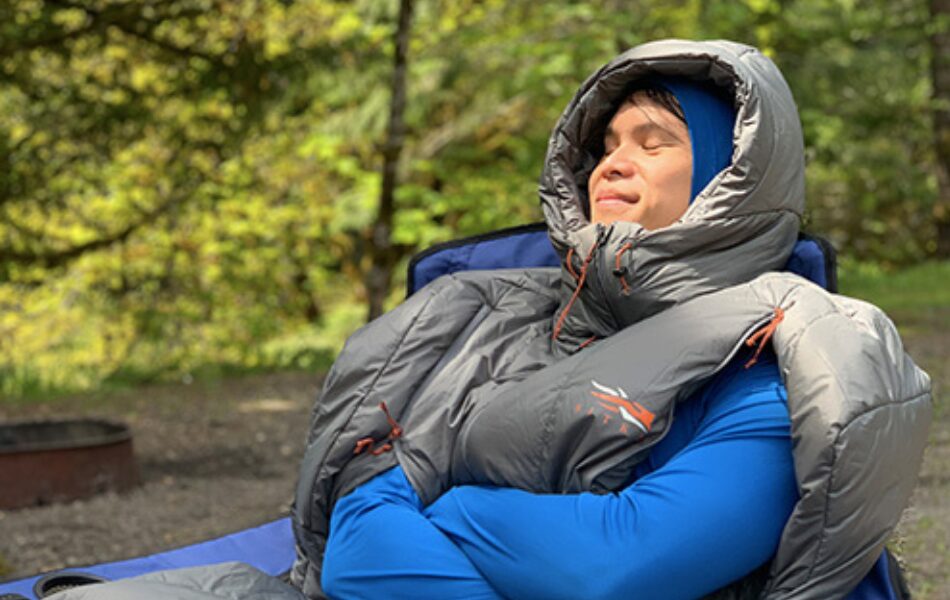
What type of sleeping bag is best?
Rectangular sleeping bags let you stretch out while sleeping but are generally heavier and less packable than other bags. They're a great option for car camping, where weight and packability don't matter as much. Mummy bags, which have a slimmer fit, are typically warmer, lighter, and more packable, making them the choice for backpacking trips.
Should I get a down or a synthetic sleeping bag?
Down is by far the warmer and more packable of the two insulation types. If you're mostly going to be backpacking, or need to pack your sleeping bag frequently, a down bag is probably the best choice for you.
Synthetic bags are heavier and don't pack down as well as down bags. They are more affordable though, and insulate you even when wet. They're a great choice for car camping or particularly wet conditions.
What temperature rating should I get for my sleeping bag?
If you'll mostly be using your sleeping bag in the summer, look for a temperature rating between 10° and 30°. Where you fall in that range depends on whether you're a cold or a hot sleeper. Chelsey prefers to use a 10° bag for spring, summer, and fall because she is a cold sleeper and is often camping at higher altitudes or in northern environments.
How many years does a sleeping bag last?
A quality down sleeping bag can last over a decade if it's well cared for. Chelsey has been using the same bag for over five years, and routinely sleeping in it over 100 days a year. When she's not using it, she makes sure to fluff it out and store it in a large bag in a cool, dry place. She also washes it at least once a season to keep the down clean and fluffy. If dirt and oil are allowed to build up on a bag, it can migrate into the fill and affect its ability to insulate.
Synthetic bags, on the other hand, generally last only a few years. The synthetic filling degrades over time even if well cared for, and gradually loses loft and warmth.
Hiking pants are a critical piece of outdoor gear that protects our legs and helps us regulate our temperature in both hot and cold weather. Finding the right pair of hiking pants for you isn't always easy, however.
The ExplorersWeb team tested over a dozen pairs of hiking pants to create this guide. We looked for pants that were both breathable and protective from the sun and rain, and didn't restrict our movement.
Gear Editor Chelsey Cook routinely spends several consecutive weeks wearing a single pair of hiking pants on expeditions and knows the value of comfortable, durable pants that you don't mind living in. She put several of our favorite pairs through the wringer, wearing them on backpacking and packrafting trips in the Alaskan bush, testing them on the volcanoes of Washington, and relying on them to protect her legs from abrasions on canyoneering trips in Utah.
There's no one-size-fits-all when it comes to hiking pants, so we tested a range of pants, from full-length to convertible to hiking tights. The pants in this guide have a variety of different features, including water-repellent finishes, added sun protection, cargo and zipped pockets, integrated belt systems, and ankle cuffs. Most of the pants in this guide are available in both men's and women's sizes.
If you're looking for the right footwear to pair with your hiking pants, check out our guide to the Best Hiking Boots.
Editor's Note: We updated this guide on May 15, 2024, to announce the Best Overall Hiking Pants as the Arcteryx Gamma Pants after two years of additional testing, and added superlatives for Best Lightweight Hiking Pants and Most Versatile Hiking Pants. We also added Best All-Around Men's and Women's Pants for the pairs we love to wear hiking and in our daily lives.
Our Picks for the Best Hiking Pants of 2024
- Best Overall Hiking Pants: Arcteryx Gamma Pants
- Best All-Around Women's Hiking Pants: 5.11 Shella Pants
- Best All-Around Men's Hiking Pants: Prana Stretch Zion Pants
- Most Versatile Hiking Pants: Norrona Falketind Flex1 Pant
- Best Lightweight Hiking Pants: Arcteryx Gamma Lightweight Pants
- Best Hiking Pants for Scrambling: Outdoor Research Ferrosi Pants
- Best Convertible Zip-Off Hiking Pants: Columbia Silver Ridge Pants
- Best Hiking Leggings: Icebreaker Merino 260 Fastray High Rise Tights
Best Overall Hiking Pants:
Arcteryx Gamma Pants
Features: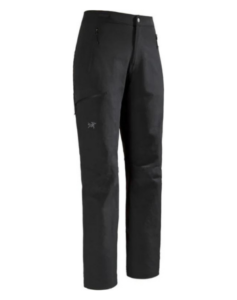
- Laminated cuffs and adjustable pant cuff drawcord
- Gusseted crotch for easy movement
- Three zippered pockets for safe storage
- Thigh pocket sits below a climbing harness
- Low profile belt doesn't rub under a pack or harness
Why we like it: Comfortable softshell pants for hiking, climbing, or mountaineering
What we don't like: Heavier fabric may not be suitable for hot conditions
Fabric: 88% nylon, 12% elastane | Water Resistant: Yes | UPF: No | Men's or Women's: Both
The Arcteryx Gamma Pants ($200), available in men's and women's, are our choice for the best overall hiking pants. They've been Chelsey's go-to pants for backpacking and hiking in Alaska, as well as summer mountaineering and alpine climbing trips in Washington. She loves how stretchy they are, with a gusseted crotch and articulated knee. The waistband and integrated belt are slim and have a soft inner liner, increasing comfort when carrying a heavy backpack. All the pockets are zippered, a must for Chelsey, who likes to store small items in her pockets for easy, on-the-go access. While they aren't 100% waterproof, the DWR finish is one of the best we've seen, and the pants dry quickly.
Check Women's Price at Arcteryx
Best All-Around Women’s Hiking Pants:
5.11 Shella Pants

Features:
- Minimalist design for daily wear
- Reinforced belt loops
- Six total pockets, including large cargo pockets
- DWR finish
- Reinforced belt loops
- Extremely comfortable
Why we like it: Minimalist, casual enough for daily wear, very comfortable waistband
What we don't like: No integrated belt or adjustable cuffs, only zipped back pockets
Fabric: 89% polyester, 11% elastane | Water Resistant: Yes | UPF: No | Men's or Women's: Women's
The 5.11 Shella Pants ($68) are Chelsey's favorite hiking pants for daily wear, long travel days, and day hikes. The stretchy, DWR-treated fabric is ideal for hiking, while the functionally minimalist look doesn't look out of place for casual wear. Kirby and Chelsey thought they were one of the most comfortable pairs of pants they tested. They have two hand pockets, two zippered back pockets, and two cargo pockets, providing ample storage. Additionally, the belt loops are reinforced, so you can hang small items off them with a carabiner if needed. The waistband is also wider than many other women's pants and doesn't cut into our stomachs when sitting, squatting, or bending over.
Best All-Around Men's Hiking Pants:
Prana Stretch Zion Pants
Features: 
- Recycled fabric, Fair Trade, and bluesign® certified
- UPF 50+ for sun protection
- Casual enough for everyday wear
- PFAS-free water-repellent finish
- Adjustable webbing waistbelt
- Double-entry cargo pockets
Why we like it: Comfortable, sustainable pants that look at home at the trailhead or at the brewery
What we don't like: Not very breathable, few zippered pockets
Fabric: 95% recycled nylon, 5% elastane | Water Resistant: Yes | UPF: 50+ | Men's or Women's: Men's
The Prana Stretch Zion Pants ($95) are our male testers' pick for the best all-around men's hiking pants. As it says in the name, these pants are super stretchy and one of our testers uses them for both rock climbing and hiking, as well as for going to yoga classes. At first glance, the Stretch Zion pants look like an everyday pair of pants, perfect for a day in town or even the office on more casual days. The Zion Pants have a double-zippered cargo pocket for safe storage, a low-profile adjustable waistbelt, and snap buttons to secure rolled-up pants legs. The fabric does feel heavier than other pants and can be a little too warm on hot summer days.
Most Versatile Hiking Pants:
Norrona Falketind Flex1 Pant

Features:
- Made with sustainable and eco-friendly materials
- PFC-free DWR finish
- Multiple pockets
- Reinforced knees and seat
- Adjustable lower leg
- Made with recycled materials
Why we like it: Breathable, stretchy, do-it-all pants
What we don't like: Not enough wind resistance for cold conditions
Fabric: 69% recycled polyamide, 19% recycled polyester, 12% elastane | Water Resistant: Yes | UPF: No | Men's or Women's: Both
The Norrona Falketind Flex1 Pants ($199) were our choice for the most versatile pants and one of Kirby's, one of our testers, favorite products thanks to their durability, versatility, and features. Kirby wore them on several hikes and off-trail scouting missions, and while bouldering and rock climbing. The slim fit was comfortable and attractive, and the pants moved well with her. She particularly enjoyed features such as a zippered thigh pocket, a custom-fit waist system that uses velcro, reinforced knees and seat, and an adjustable lower leg with a zipper and a gusset to let your legs breathe.
The Falketind Flex1 Pants are eco-friendly, with bluesign® certified fabric made from recycled fibers, and a PFC-free DWR finish. They come in men’s and women’s models.
Check Women's Price at Backcountry
Best Lightweight Hiking Pants:
Arcteryx Gamma Lightweight Pants
Features: 
- Made from recycled materials
- Low profile belt doesn't rub under a pack or harness
- Three zippered pockets
- UPF rating of 40+ for sun protection
- High elastane percentage for stretch
- Lightweight fabric that balances breathability with wind resistance
Why we like it: All of the best features of the Gamma Pants in incredibly lightweight, breathable material
What we don't like: Thinner fabric may be less abrasion-resistant
Fabric: 86% nylon, 12% elastane | Water Resistant: Yes | UPF: 40+ | Men's or Women's: Both
The Arcteryx Gamma Lightweight Pants ($160) have all of the best features of the Gamma Pants, our best overall pick, in a lighter, more breathable fabric. Chelsey has used the women's version of the Gamma Lightweight Pants for years for her spring and fall backpacking and canyoneering trips in Utah. She likes the flexibility of the four-way stretch fabric and how lightweight the pants feel in hotter temperatures. They also have three zippered pockets for storing valuables and, despite being so lightweight, have adequate wind- and water resistance, as well as UPF 40+ to protect you from the sun's rays.
She's found that the pants are more prone to abrasion than the Gamma Pants, though any pants would be hard-pressed to stand up to repeated seasons of slithering through Utah's slot canyons. They also come in men's sizes.
Check Women's Price at Arcteryx
Best Hiking Pants for Scrambling:
Outdoor Research Ferrosi Pants

Features:
- Stretchy fabric for freedom of movement
- Abrasion resistant fabric
- Harness compatible waist
- Made from bluesign® recycled nylon
- UPF 50+ for sun protection
- Relaxed fit
- Zip pockets
Why we like it: Soft and abrasion-resistant with plenty of stretch
What we don't like: Material is prone to pilling
Fabric: 46% recycled nylon, 40% nylon, 14% spandex | Water Resistant: Yes | UPF: 50+ | Men's or Women's: Both
The Outdoor Research Ferrosi Pants ($99) are made from OR's famous Ferrosi fabric, one of Chelsey's favorite softshell fabrics because of its softness and stretchiness. She wears these pants during alpine scrambles and rock climbs, where durability and freedom of movement are key. They offer a relaxed fit and good wind and water resistance. Some features we love are the zippered thigh pocket that is accessible when wearing a harness, the articulated knees, and the adjustable ankle cuffs, which help keep out debris. There's also an internal drawcord waist to refine the fit, and the pants are rated to UPF 50+ to protect your legs from the sun.
The Outdoor Research Ferrosi Pants are available in men's and women's sizes.
Best Convertible Zip-Off Hiking Pants:
Columbia Silver Ridge Hiking Pants

- Durable 100% nylon construction
- Converts to shorts with easy zip-off legs
- UPF 50 fabric offers UV protection
- Omni-Wick
 technology pulls moisture to the fabric's surface to evaporate
technology pulls moisture to the fabric's surface to evaporate - Mesh pocket bags increase airflow
- Partial elastic waist for comfort
Why we like it: Breathable, lightweight fabric that wicks sweat
What we don't like: No water-resistant finish
Fabric: 100% nylon | Water Resistant: No | UPF: 50 | Men's or Women's: Both
In our opinion, the Columbia Silver Ridge Hiking Pants ($65) are some of the best-looking convertible pants and they’re as comfortable and functional as they are attractive. These pants are perfect for hot, dry hiking adventures. They're lightweight wonders, with UPF 50 protection from the sun and an Omni-Wick technology that pulls moisture to the fabric's surface to evaporate in warm weather. Most importantly, they easily convert into shorts with zip-off legs. We love the integrated belt and the breathability that a gusseted crotch offers. These convertible pants are surprisingly effective against the wind and offer pockets with flaps and zippers to hold small items, including a cargo pocket for your phone.
technology that pulls moisture to the fabric's surface to evaporate in warm weather. Most importantly, they easily convert into shorts with zip-off legs. We love the integrated belt and the breathability that a gusseted crotch offers. These convertible pants are surprisingly effective against the wind and offer pockets with flaps and zippers to hold small items, including a cargo pocket for your phone.
The Silver Ridge Hiking Pants are also a great option for budget hiking pants, with plenty of features at a low price. They're available in a women's utility version as well.
Check Men's Price at Backcountry
Check Women's Price at Backcountry
Best Hiking Leggings:
Icebreaker Merino 260 Fastray High Rise Tights

Features:
- 97% merino wool
- Stash pocket large enough for a phone
- High-rise waist
- Body contouring details
- Flatlock seams to prevent friction
Why we like it: Comfortable high waist, stash pocket for phones
What we don't like: Not water or wind-resistant, expensive
Fabric: 97% merino wool, 3% elastane | Water Resistant: No | UPF: No | Men's or Women's: Women's
Leggings are a popular choice for hiking because they are stretchy and can pull double duty at yoga, the gym, or layered under hiking pants during colder seasons. The IceBreaker Fastray High Rise Tights ($120) are Kirby's favorite hiking tights. She likes the insulation the merino wool provides and how easy it is to move in them. The high waist also gives them a form-hugging and flattering fit, and there's a gusseted crotch for increased mobility and airflow. While most leggings don’t have pockets, these feature a thigh stash pocket large enough for a phone. Like most leggings, these are not water or wind resistant.
Icebreaker also offers men's hiking tights.
Check Women's Price at Icebreaker
Honorable Mentions:
Prana&subId2=explorersweb Halle Pants

Features:
- Trouser-like pants for both active or casual wear
- Option to roll up pants and secure with a button closure
- Stretch Zion fabric
- Five total pockets
- DWR finish
- Women's only
Our first runner-up is the Prana Halle Pants, which Kirby and Chelsey tested while hiking, backpacking, and climbing. They liked the durability, the pockets, and the option to roll up the pants legs and secure them. However, Chelsey found that the pants stretched out a lot over a few days of wear, making for a baggy fit on backpacking trips. There's also no integrated belt, and having to wear a belt with them makes them less ideal for carrying heavy backpacks.
While there are no men’s Halle Pants, the Prana Stretch Zion are comparable.
5.11 Meridian Pants

Features:
- Front pockets, back pockets, and cargo pockets
- Vents for breathability
- Hand-washing required
- Extremely durable
- Articulated knees
- Slim-fit
- Men's only
The 5.11 Meridian Pants are a slim-fit pair of pants that are a great choice for climbing, scrambling, or hiking. Our tester wore these pants for an alpine rock climb that required a brutal 4.5-hour hike on both ends. In total, he spent 30 hours straight in these pants, and he liked the slim fit that still allowed him to bend and stretch, the venting, and the numerous pockets.
The downside is that the fabric dye requires hand-washing.
Buck Mason Trail Roam Pants

- Cotton and nylon construction with a DWR finish
- Elastic waist with drawcord closure
- Great for relaxed hiking days
- Four total pockets
- Loose fit
- Men's only
The Buck Mason Trail Roam Pants ($118) feature a cotton nylon blend with a DWR coating. The back pockets close with buttons and there are two hand pockets on the front. The waist is elastic with drawcord tightening.
The hips are baggy, and our tester wasn’t thrilled with the overall fit of the pants. While the loose fit is good for ventilation and comfort, it felt a little sloppy and wouldn't be ideal for technical hiking or scrambling where the pants leg could catch on things.
Check Men's Price at Buck Mason
About our testing process
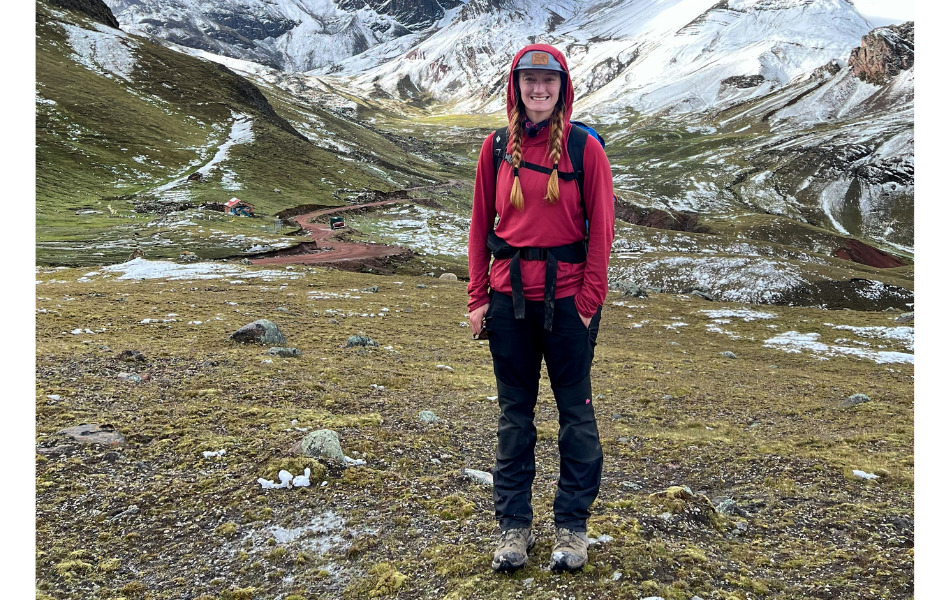
The ExplorersWeb team has tested over a dozen different hiking pants, racking up countless hours and miles of hiking and backpacking around the world in our search for the best pair.
Kirby Kahl started this guide in October 2022 and has been hiking for her entire life. She's well-versed in technical apparel and looks for hiking pants that can do it all. She and her partner tested most of the pants selected in this guide and wore them on hiking trips and long alpine climbs. Kirby also looked in the closets of her broad network of climbing, hiking, and backpacking friends, and their experiences and opinions on hiking pants helped shape this guide.
Gear Editor Chelsey Cook took over the guide in May 2024. She has over twenty years of experience hiking, backpacking, and mountaineering. She tested the pants in this guide on day hikes, backpacking trips, and longer expeditions in Alaska, Washington, Utah, Scotland, Peru, and the Faroe Islands. Chelsey also incorporated several pairs into her daily wear in Alaska, to see how their comfort and style stood up in the front country.
When testing the durability of hiking pants, we wore them as much as possible. Chelsey took a few of our favorite pairs canyoneering in Utah, and squeezing through slot canyons and stemming rough canyon walls quickly separated out which pants could stand up to some abuse. When testing the comfort and stretchiness of hiking pants, we wore them scrambling and rock climbing and looked for the pants that hindered us the least. We also tested hiking pants in a range of different conditions, from wet, cold, and snowy to hot and dry, and evaluated each pair for their breathability and wind- and water resistance.
We looked for hiking pants with different fits, from relaxed to slim, as well as budget pants, lightweight and heavier pants, pants with rain and sun protection, and pants with features like roll-up and zip-off legs. This guide will continue to grow and change as we test new hiking pants.
Things to consider when buying hiking pants
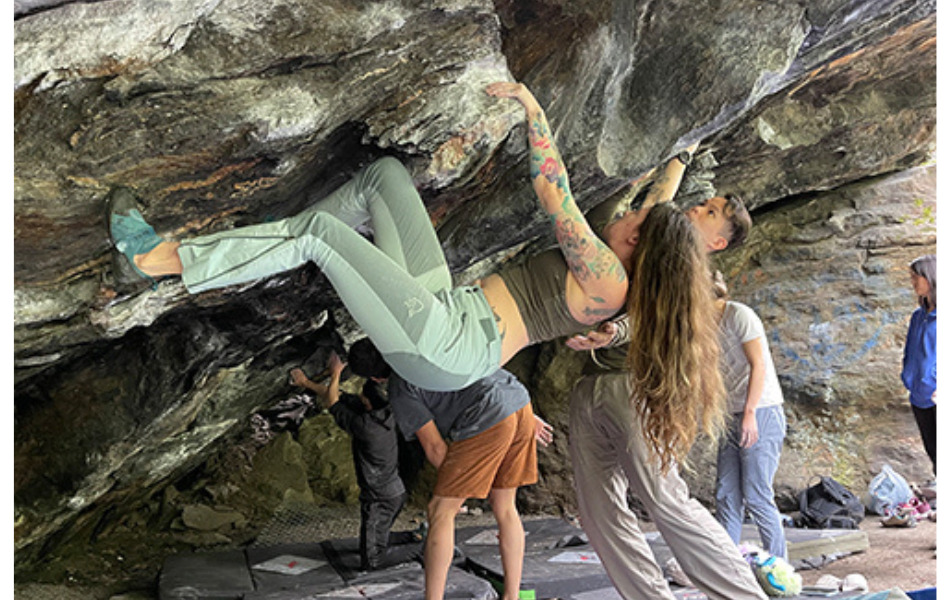
Types of hiking pants
Hiking pants come in a variety of different types, including traditional, convertible, roll-up, and tights. Traditional pants are typically full-length and water-resistant. These are a versatile option for most hiking needs, as the DWR finish will keep you warm and dry during bad weather while the full-length legs will protect you from the sun and any bushwhacking.
Convertible hiking pants have zip-off legs that turn the pants into shorts. This gives you more options on long hikes when the weather might warm significantly. However, they can look a little strange and you have to remove your hiking boots to pull the legs off. Roll-up pants are a happy medium between traditional and convertible pants. They have a button or drawcord that secures the pant cuff when you roll them up.
There are also hiking tights, like the IceBreaker Fastray High Rise Tights. Some people may find tights more comfortable than hiking pants. However, they don't offer any weather protection and snag easily on rocks and branches.
Materials
Most of the hiking pants in this guide and on the market are made of a mix of polyester or nylon and an elastic fiber like elastane. Polyester and nylon are both durable fibers, while elastane gives hiking pants some stretch. Coupled with a water-repellent finish, this fabric is often called 'soft-shell', and is both breathable and protective.
Cotton blends are also occasionally used in hiking pants. Cotton is very breathable, however, it absorbs moisture and isn't insulating when wet. Cotton pants should be reserved only for hot, dry climates.
Hiking tights are generally made of the same materials as hiking pants, though some feature merino wool, which wicks away moisture, prevents odor buildup, and will keep you warm even when wet.
Weather protection
Hiking pants, particularly soft-shell ones, often have a durable water-repellent finish (DWR). A DWR coating doesn't necessarily mean waterproof, but it does add enough water resistance to keep you dry when hiking in light rain or through wet foliage. It does breathability, however, and water resistant pants often feel heavier. DWR treatments have also historically used PFAS chemicals, which are now thought to pose long-term risks to the environment and our health. Many outdoor brands are now moving towards PFAS-free DWR treatments.
Some hiking pants, like the Prana Stretch Zion Pants and the Arcteryx Gamma Lightweight Pants, have a UPF, or ultraviolet protection factor, rating, which measures how well the fabric blocks harmful UV radiation from the sun. The higher the UPF rating, the more UV radiation the fabric blocks. If you hike in the desert or at high altitudes, consider hiking pants with a high UPF for added protection.
Mobility and fit
Hiking pants should move with you. If you usually hike well-groomed trails, you may not need the stretchiest hiking pants on the market. However, if you plan on scrambling or climbing in your pants. you'll want pants with a higher percentage of stretchy materials like elastane. Features like a gusseted crotch and articulated knees also improve the range of motion.
Hiking pants come in a variety of fits. Slim fits may restrict motion, while baggier fits could snag on rocks and undergrowth. Because everyone is shaped differently, it's best to try on several different pairs of hiking pants before settling on one you like. You want your pants to fit snuggly, but not restrict your movement. If you'll be carrying a heavy backpack, look for hiking pants that don't require you to wear a belt, as a belt can rub against a pack and your skin.
Additional features
Hiking pants run the gamut from fully featured to minimalist when it comes to design. Ideally, you want a pair of pants to have all the features you find necessary, without adding weight or restricting movement. If you like carrying things in your pockets, look for pants with a mix of large cargo pockets and zipped pockets for extra protection. Integrated belts can also be a nice option, but make sure the system is comfortable and stays in place on your body. Some pants come with adjustable cuffs, which can be helpful if you wear a variety of different shoes and boots when hiking.
Frequently asked questions about hiking pants
What types of pants are best for hiking?
The type of hiking pants that works best for you depends on where you hike, what weather you hike in, the duration of your hiking trips, and your personal preferences. If you hike in cold, wet conditions, look for pants with a DWR finish. If you prefer to hike in the desert or hot conditions, look for lighter fabrics with a UPF rating, convertible pants, or roll-up pants. Above all, make sure your hiking pants fit you well and don't restrict your movement.
Should hiking pants be loose or tight?
Hiking pants should be comfortable and not impede your movement. They should neither be too tight nor too loose. Here’s how you can test your pants before you venture onto the trail with them.
Squat – Your pants shouldn't be pinching you anywhere when squatting, or riding up more than a few inches. The waist should still be flush against your back.
Sit – If the pants are tight or uncomfortable when sitting, you may need another size or another design.
Raise one knee at a time – Raise each knee as high as possible. Your pants shouldn't block your movement, pinch at your hips, split at the crotch, or ride up more than a few inches.
Do I need to wear long pants when hiking?
This is a personal preference. We generally wear full-length hiking pants because they not only protect us from the sun and rain but also from mosquitoes and abrasions from rocks or undergrowth. If you're hiking in the desert, however, you may appreciate the breathability of shorts. A convertible pair of pants is a good way to have all of your bases covered.
Can I hike in jeans?
Jeans are not a great option for hiking. They're made of cotton, which doesn't wick away moisture or insulate when wet. They're also not breathable, don't stretch, and are heavy compared to hiking pants.
What shoes should I wear with hiking pants?
You should wear sturdy shoes that offer your feet support and protection, as well as traction on a variety of terrain. Check out our Best Hiking Boots of 2024 for a full guide.
No matter what activities you enjoy outside, sunscreen should be a critical piece of your day-to-day self-care and your outdoor gear kit. Skin cancer is the most common cancer in the United States, with one in five Americans developing skin cancer in their lifetime. One of the main risk factors is excessive UV exposure and sunburn. While everyone is at risk of excessive UV exposure, people who spend a lot of time outdoors hiking, biking, skiing, and swimming are at a higher risk simply due to the duration of exposure.
Thankfully, one of the easiest ways to mitigate this is by consistent use of sunscreen. Sunscreen protects you from harmful rays, and consistent sunscreen use has been shown to prevent sunburns and premature aging.
While there are plenty of sunscreens on the market to choose from, some are better than others. To help you pick the right sunscreen for you, we tested a dozen sunscreens over the course of two years, wearing them as our daily protection, trying them at the beach and while hiking, and using them to protect our tattoos. Gear Editor Chelsey Cook also tested several products on the high-altitude glaciers of the Alaska Range, where the sun is relentless and sometimes shines for over 20 hours a day.
From our extensive testing, we chose a range of mineral- and chemical-based sunscreens, in lotion, face stick, and spray applications for the best sunscreens of 2024. We prioritized sunscreens that were easy to apply, offered good protection, didn't irritate our skin, and were healthy for the environment. All of the sunscreens on this list are water-resistant and offer broad-spectrum protection.
Editor's Note: We updated this guide on May 10, 2024, to ensure our product selection and buying advice were up to date with 2024’s sunscreen market. We also added superlatives such as Best Face Stick Sunscreen, Best Spray Sunscreen, and Best Sunscreen Chapstick. We updated the Best-Reef Safe from Badger SPF 35 Sport Mineral Sunscreen to Badger SPF 40 Sport Mineral Sunscreen after additional testing.
Our picks for the best sunscreen of 2024
- Best Overall Sunscreen: Sun Bum Original SPF 50 Sunscreen
- Best Reef-Safe Sunscreen: Badger SPF 40 Sport Mineral Sunscreen
- Best Face Stick Sunscreen: Sun Bum Mineral SPF 50 Face Stick
- Best Mineral Sunscreen: Coppertone Sport Mineral Sunscreen SPF 50
- Best Tinted Sunscreen: Amavara Tinted Mineral Sunscreen SPF 50
- Best Scented Sunscreen: Alba Botanica SPF 45 Sunscreen Lotion
- Best Spray Sunscreen: Supergoop! PLAY SPF 50 Body Mist
- Best Sunscreen Chapstick: Sun Bum SPF 30 Lip Balm
Best Overall:
Sun Bum Original SPF 50 Sunscreen
Features: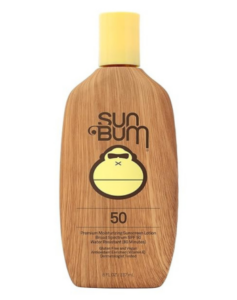
- Dermatologist recommended
- Moisturizing with added vitamin E
- Sweat- and water-resistant
- Reef friendly
- Broad spectrum protection from UVA and UVB rays
- Vegan and cruelty-free
Why We Like It: Easy to apply and rub in, nongreasy feeling, smells great
What We Don't Like: Comes in a large container that isn't easy to pack away
Active Ingredients: Avobenzone, Homosalate, Octisalate, Octocrylene | Water-Resistant: Yes, 80 minutes | Reef Friendly: Possibly | Size: 8 ounces
Sun Bum Original SPF 50 Sunscreen ($18) is our pick for the best overall sunscreen. It's Chelsey's go-to sunscreen for summer adventures, and she loves how easily it spreads and blends in, making application on her legs and arms quick and easy. Our tester Kirby uses it as her daily sunscreen to protect her tattoos.
Sun Bum Original SPF 50 Sunscreen is water-resistant, nongreasy, fragrant, and has added vitamin E to leave your skin feeling soft. It's paraben-free, cruelty-free, vegan, and hypoallergenic, and our skin didn't break out after repeated uses. While it is considered reef-safe under Hawaii’s sunscreen law, it contains octocrylene, which the Coral Reef Alliance does not recommend for use in the ocean.
It does come in a large bottle that isn't the greatest for stashing in a backpack. Chelsey transfers some to small travel tubes, like the GoToob+ Squeeze Bottles before heading out on any day hikes or backpacking trips. Read Kirby's in-depth review on Sun Bum Original SPF 50.
Best Environmentally Friendly Sunscreen:
Badger SPF 40 Sport Mineral Sunscreen
Features: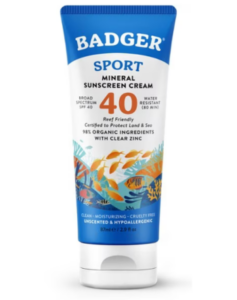
- Made with 98 percent organic ingredients
- Clear zinc for easier application
- Certified reef safe
- Only includes four ingredients
- Packaged sustainably in a 50 percent PCR tube
- Broad spectrum protection
- Vitamin E and sunflower oil added to moisturize
Why We Like It: Organic, reef-safe ingredients that offer great sun protection
What We Don't Like: Thick, difficult to apply
Active Ingredient: Zinc oxide | Water-Resistant: Yes, 80 minutes | Reef Friendly: Yes | Size: 2.9 ounces
Badger SPF 40 Sport Mineral Sunscreen ($18) is replacing our previous Best Reef-Safe Sunscreen, Badger SPF 35 Zinc Oxide Sport Sunscreen after more testing because of the additional SPF protection. This sunscreen is one of Chelsey's favorite sunscreens on personal expeditions involving glacier or snow travel because it is thick and very protective, containing 22.5 percent zinc oxide. It's also a very environmentally friendly option, with only four, mostly organic, ingredients. It's reef-friendly, cruelty-free, and made with solar power. Badger, a family-owned brand, added sunflower oil, beeswax, and vitamin E to soothe and moisturize your skin.
Because of the high zinc oxide content, this sunscreen is thick and a little hard to apply. It often leaves a white residue, but it’s worth it if maximum protection is your main objective.
Best Face Stick Sunscreen:
Sun Bum Mineral SPF 50 Face Stick
Features: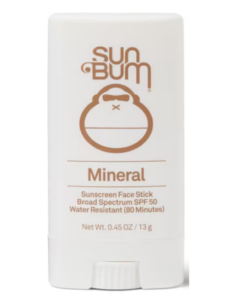
- Easy to apply face stick
- Broad spectrum sun protection
- Free from paraben, mineral oil, silicone, and dyes
- Hypoallergenic
- Vegan and cruelty-free
- Tiny container for easy travel
Why We Like It: Easy to apply on the go, small enough to stash in your pants pocket
What We Don't Like: Difficult to spread when cold, leaves a white film on skin if not rubbed in
Active Ingredient: Zinc oxide | Water-Resistant: Yes, 80 minutes | Reef Friendly: Yes | Size: 0.5 ounces
Sunscreen face sticks look like little deodorant sticks and contain sunscreen in a solid form. They're incredibly easy to apply; take off the cap, roll up some sunscreen, and rub the stick on your face. Chelsey swears by this quick, no-mess sunscreen option and her favorite is the Sun Bum Mineral SPF 50 Face Stick. ($13.50) Containing 19 percent zinc oxide, it's a surprisingly powerful sunscreen in a tiny container. Chelsey keeps it in the pocket of her soft-shell pants while traveling on the glaciers of Alaska, and likes that she can quickly apply it one-handed while moving on a rope team. It's also a great option for on-the-go applications while hiking or paddling.
The solid sunscreen can be difficult to apply if it gets cold, so Chelsey keeps the stick in a pocket close to her body to keep it warm.
Best Mineral Sunscreen:
Coppertone SPF 50 Sport Mineral Sunscreen SPF 50
Features:
 Budget-friendly mineral-based option
Budget-friendly mineral-based option- 100 percent naturally sourced zinc oxide
- Broad spectrum coverage
- Paraben-free and dye-free
- Hypoallergenic and friendly for sensitive skin
Why We Like It: Spreads easily, particularly for a zinc oxide-based sunscreen
What We Don't Like: Like many mineral-based sunscreens, it doesn't smell the best
Active Ingredient: Zinc oxide | Water-Resistant: Yes, 80 minutes | Reef Friendly: Yes | Size: 5 ounces
While we like that mineral sunscreens are all-natural, zinc oxide is infamous for spreading like cream cheese and leaving a white film on your face. We like Coppertone's SPF 50 Sport Mineral Sunscreen ($19 for a two-bottle bundle) because it's easy to apply and barely leaves a white sheen on your skin, which fades quickly once fully rubbed in.
Coppertone uses 100 percent naturally sourced zinc, and the sunscreen is dye-free, paraben-free, and hypoallergenic. It's also less expensive than many other sunscreens we tested, making it a great budget-friendly option for people wanting to try mineral-based sunscreen.
Best Tinted Sunscreen:
Amavara Tinted SPF 50 Mineral Sunscreen
Features:
 Tinted mineral sunscreen
Tinted mineral sunscreen- Broad spectrum protection=
- 100 percent non-nano zinc oxide
- Vegan and cruelty-free product
- No artificial colors
- Great for sensitive skin
Why We Like It: Easy to apply, tint provides coverage and smoothes complexion
What We Don't Like: Expensive for a small amount of sunscreen, only one tint
Active Ingredient: Zinc oxide | Water-Resistant: Yes, 80 minutes | Reef Friendly: Yes | Size: 1.65 ounces
Our tester Kirby wears Amvara Tinted SPF 50 Mineral Sunscreen ($25) on her face every day. She rarely wears makeup and prefers this lotion to add some color and coverage to her face while protecting her skin from the sun. She's found that she can even apply this sunscreen when sweaty or wet, making it easy to throw on after washing her face in the morning or after the gym.
Protecting your skin and protecting the earth go hand in hand, and Amvara does both equally well. Their commitment to the environment includes post-consumer recycled packaging, a vegan and cruelty-free product, and reef-safe ingredients. Read Kirby's in-depth review on Amvara Tinted SPF 50 Mineral Sunscreen.
Best Scented Sunscreen:
Alba Botanica SPF 45 Sunscreen Lotion
Features:
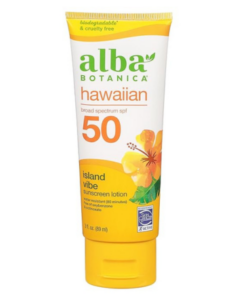 Refreshing green tea scent
Refreshing green tea scent- Easy to apply
- Contains aloe to soothe skin
- 100 percent vegetarian formula
- Never tested on animals
- Biodegradable formula
Why We Like It: Smells great, non-greasy, cruelty-free
What We Don't Like: Leaves a white cast initially
Active Ingredients: Avobenzone, homosalate, octocrylene, octisalate | Water-Resistant: Yes, 80 minutes | Reef Friendly: Possibly | Size: 3 ounces
Due to its pleasing scent and ease of application, Alba Botanica SPF 45 Sunscreen Lotion ($11) is one of Kirby's favorite sunscreens. She likes that it applies easily and smells great. It also contains refreshing aloe vera, to soothe your skin, and is paraben-, phthalate-, and petroleum-free.
Alba Botanica never tests its products on animals and this sunscreen does not contain any animal byproducts. It does not contain oxybenzone, octinoxate, or gluten, making it technically reef-safe under Hawaii's laws, however, it does contain octocrylene.
See Alba Botanica Sunscreen Lotion SPF 45 on Amazon
See Alba Botanica Sunscreen Lotion SPF 45 on Walmart
Best Spray Sunscreen:
Supergoop! PLAY SPF 50 Body Mist
Features:
 Spray sunscreen with non-aerosol application
Spray sunscreen with non-aerosol application- Acai and green tea extract to nourish skin
- Cruelty-free and reef-friendly
- Sweat- and water-resistant
- No white cast
- Bag-on-valve technology allows you to spray at any angle
Why We Like It: Non-aerosol spray for air travel, easy application
What We Don't Like: Barely enough for more than one full-body application
Active Ingredient: Avobenzone, Homosalate Octisalate, Octocrylene | Water-Resistant: Yes, 80 minutes | Reef Friendly: Possibly | Size: 3 ounces, 6 ounces available
Supergoop! Play SPF 50 Body Mist ($18) gained popularity through bright and clean social media marketing, and we decided to try the sunscreen for ourselves. The non-aerosol container spritzes a refreshing body mist sunscreen that is SPF 50. It also contains green tea extract, acai extract, and vitamin C to refresh and protect your skin. The brand uses environmentally friendly packaging and never includes oxybenzone or octinoxate, making it reef-friendly by some standards. It does contain octocrylene.
The sunscreen is very easy to apply, even in hard-to-reach areas of your body. Supergoop's bag-on-valve technology also allows you to spray the body mist at any angle. We tested the three-ounce version, and while we liked it, the container is a little small for full-body application. We recommend the six-ounce bottle if you're a heavy sunscreen user.
Best Sunscreen Chapstick:
Sun Bum SPF 30 Lip Balm
Features: 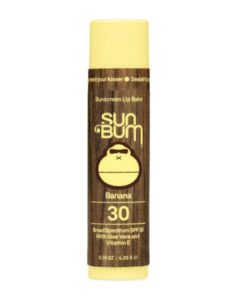
- Added aloe and Vitamin E for moisturizing
- Vegan, gluten-free, and cruelty-free
- Broad spectrum protection
- Multiple tasty flavors are available
What We Like: Tastes incredible, multiple flavors
What We Don't Like: Thin texture feels like it needs frequent reapplication
Active Ingredients: Avobenzone, Homosalate, Octisalate, Octocrylene | Water-Resistant: Yes | Reef Friendly: Possibly | Size: 0.15 ounces
Your lips are just as susceptible to sunscreen as the rest of your skin, and it's a good idea to wear chapstick with SPF anytime you'll be spending the day outside. Chelsey carries Sun Bum SPF 30 Lip Balm ($4) on all of her expeditions and uses it as her daily chapstick, too. This sunscreen chapstick is almost tasty enough to eat and comes in a variety of flavors like banana, coconut, and watermelon. It goes on easily and doesn't feel greasy on your lips. Sun Bum added aloe and vitamin E to keep your lips soft, even after a long day in the sun and wind.
Sun Bum also has a Mineral SPF 30 Sunscreen Lip Balm which we like, but it leaves a white cast and doesn't taste as good.
About our testing process
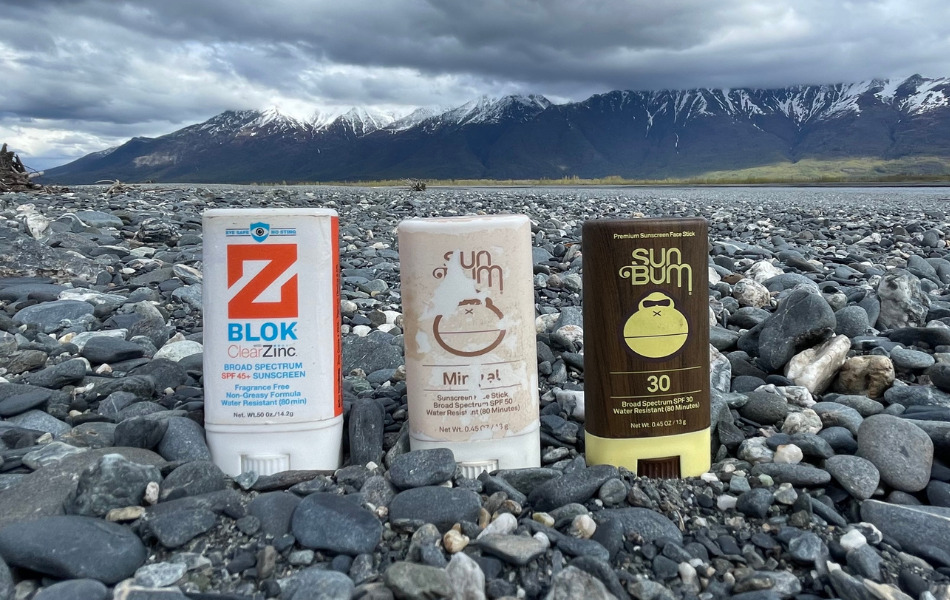
The ExplorersWeb team tested the sunscreens on this list over the course of two years, wearing them while working, adventuring, and going about our daily lives. We skied, hiked, climbed, gardened, and read in the sun. We sweated and swam and even got sunburned, all to find the best sunscreen on the market for your own outdoor adventures.
Ilana Newman started this guide in October 2022. When she's not on the computer writing, you can find her outside running, rock climbing, skiing, and hiking. She's also guided on a glacier in Alaska and worked for ski resorts, so she knows all too well the damage the sun can do when reflected off the snow. Sunscreen is a must for her, and she's tested almost all of the sunscreens on this list and put hours into researching what makes sunscreens protective, good for your skin, and safe for the environment.
Gear Editor Chelsey Cook took over this guide in May 2024. She lives in Alaska where the sun literally doesn't set in the summers, and has spent six years guiding high-altitude mountaineering in the Alaska Range and remote backpacking trips. When she's not in Alaska, she's usually traveling in other high-altitude areas of the world, including the Andes of Peru, where a thinner atmosphere makes UV rays much more intense.
After seeing several of her guiding friends get diagnosed with skin cancer and getting a scary, second-degree sunburn on her nose after summiting Denali one year, Chelsey takes her sunscreen seriously. Most days, you'll find her wearing a ballcap and sun shirt with the hood pulled up, even in the front country. She's tried most sunscreens on the market, and prioritizes sunscreens that spread easily, are long-lasting, protective, and gentle on her sensitive skin. She particularly likes face sticks, because they are easy to apply on the move and small enough to fit in her pants pocket. She tried five different ones in her quest to find the best one, testing them on glaciers and rivers.
Kirby Kahl also tested many of the sunscreens on this list. She spends much of her time outside and is heavily tattooed. UV rays break down tattoo ink, so she looks for sunscreens that offer the most protection.
After several years of testing sunscreens, we crafted this list of our top choices. We chose the sunscreens in this guide based on their SPF levels, their water- and sweat-resistance, and how safe they are for your skin and the environment. We also looked for sunscreen that was easy to apply and long-lasting.
All the sunscreens on this list offer broad-spectrum protection and are water resistant. They are also reef-friendly by Hawaii's laws. We looked for mineral- and chemical-based sunscreens, as well as different-sized containers and different applications, from creams to face sticks to sprays. After extensive testing, we incorporated the best sunscreens we found for adults of all skin tones, genders, and ages.
Things to consider when buying sunscreen
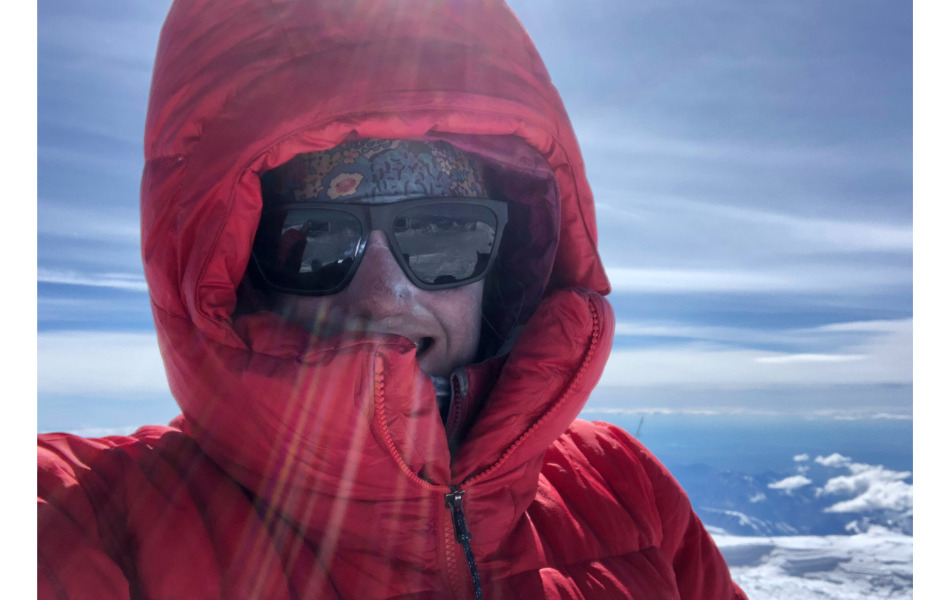
SPF
Sunscreens come in SPF options from 10 to 100, with higher numbers representing stronger protection. Dermatologists recommend sunscreen between 30 SPF and 50 SPF. Lower SPFs often advertise themselves as "tanning sunscreens," and we don't recommend them for outdoor use. Higher SPF sunscreens offer more protection, especially for activities involving water, snow, and sand, which reflect UV rays. However, the actual added protection between an SPF 50 sunscreen and an SPF 30 sunscreen is minimal.
Ingredients
Active ingredients in sunscreens are either chemicals or minerals. Mineral sunscreens provide safer, more natural protection, while chemical sunscreens often cost less and apply more easily. However, many of the chemicals may cause harmful effects on the environment and your health.
Sunscreens also come with a host of inactive ingredients. Some sunscreens include oils and extracts to help moisturize and soothe your skin.
Ease of application
Some sunscreens are easier to apply and blend in than others. Chemical-based sunscreens typically go on easily and rub in clear, while mineral-based sunscreens are thicker and may leave a white cast. Consider choosing chemical-based sunscreens for your daily-wear sunscreen, and using mineral sunscreen while hiking, backpacking, and skiing.
It's recommended that sunscreen be reapplied every 2 hours. All the sunscreens on our list are also sweat- and water-resistant, which is an important factor to look for if you're using sunscreen during outdoor activities.
Reef-Friendly
Good sunscreen should protect your skin and be healthy for both you and the environment. "Reef-friendly" and "reef-safe" are commonly used to describe sunscreen that is safe for the ocean, but they are not regulated labels. If you want to be sure you're buying an environmentally friendly sunscreen, you'll have to look at the active ingredients list.
Under Hawaii's sunscreen laws, oxybenzone and octinoxate are banned because of their harmful impacts on marine environments, and none of the sunscreens on our list contain these chemicals. However, the Coral Reef Alliance also does not recommend octocrylene, which is in most chemical-based sunscreens. Octocrylene is thought to disrupt coral reproductive cycles, damage DNA, and exacerbate coral bleaching.
Mineral-based sunscreens, made primarily with zinc oxide, are generally reef-friendly.
Size
Sunscreens come in all different-sized containers. Look at how much sunscreen you are getting, and how much you are paying for that amount in comparison to other brands. Buying in bulk can save money, but having a smaller container is useful for traveling or stashing in your backpack.
Frequently Asked Questions

Should you wear sunscreen every day?
Yes, you should wear sunscreen every day to protect yourself from sun damage and skin cancer. Apply it in the morning and reapply throughout the day, even on cloudy days. Up to 80 percent of UV rays can penetrate through clouds.
Make sure to use more sunscreen and reapply more frequently when around sand, snow, and water as they amplify the effect of the sun.
How long does sunscreen last?
Sunscreen lasts for two hours or, if you have waterproof-resistant sunscreen, about 80 minutes after swimming or sweating. Reapply often, and double-check your sunscreen bottle to see if your specific product includes any additional information about how often to apply. Sunscreen also generally takes 15 minutes to bond with your skin after reapplication before it begins to work.
Is a higher SPF better?
Dermatologists recommend using a broad-spectrum sunscreen that is SPF 30 or above. However, SPF 50 offers only marginally better protection from UV than SPF 30. SPF 30 filters out about 97 percent of UV radiation, while SPF 50 filters out 98 percent, and SPF 100 filters out 99 percent.
What is the best sunscreen for your face?
We prefer to use sunscreens that are thin and non-greasy on our faces for daily wear, like the Sun Bum Original SPF 50 Sunscreen, or tinted sunscreen, like the Amvara SPF 50 Tinted Sunscreen. If we'll be adventuring outside all day, we opt for a mineral-based sunscreen that is thicker but may leave a white cast.
You can also use SPF products such as foundation or moisturizer on your face that include SPF, but make sure that these products are SPF 30 or higher. Layering a foundation that is SPF 15 and a moisturizer that is SPF 15 does not equate to an SPF 30.
What's the difference between chemical and mineral sunscreen?
Two common types of sunscreen include chemical and mineral sunscreen. Chemical sunscreen uses chemicals such as oxybenzone and avobenzone to create a chemical reaction. Upon exposure to the sun, these chemicals absorb the harmful UV rays, turn the rays into heat, and release them from your skin.
Mineral sunscreens protect your skin like a shield rather than a chemical reaction. Ingredients like zinc oxide and titanium dioxide reflect and scatter the sun's rays before they soak into your skin.
Chemical sunscreens often absorb better than mineral sunscreens and mineral sunscreens can leave a white coating on your skin. However, mineral sunscreens are often better for the environment and the ocean.
What negative side effects can sunscreen have?
Sunscreen is vital to protect your skin from the sun, but it can irritate your skin. If you have sensitive skin, finding a sunscreen that doesn't irritate your skin can be challenging. Sunscreen can cause acne, redness, burning or itchy skin, or dry skin.
There are some concerns regarding chemicals that have historically been used in sunscreens, including avobenzone, homosalate, octinoxate, octisalate, oxybenzone, octocrylene, and others. Studies by the FDA show that many of these chemicals are absorbed into the body after use and can be detected on the skin and in blood weeks after they have been used. The constant exposure to sunscreen chemicals may be concerning, as there is not yet enough safety data for most of these ingredients.
The FDA has recognized only two sunscreen ingredients, zinc oxide and titanium dioxide, as generally safe and effective.
What makes a sunscreen reef-friendly?
Two ingredients to avoid in sunscreens are oxybenzone and octinoxate. These ingredients were recently banned from Hawaii and Key West because they cause coral bleaching and are not great for your skin. Other sunscreen chemicals that may or may not be bad for your skin and the environment include avobenzone, octisalate, octocrylene, and homosalate. Research is not currently conclusive about these chemicals, but many environmental groups advocate not using them in the oceans. Some of these chemicals also have been known to cause hormone disruption through skin absorption.
Most natural sunscreens use minerals instead of chemicals to provide sun protection. The most popular mineral sunscreens use zinc oxide, which many people recognize from the white residue often left after application. However, many brands have found ways to reduce the ghost-like pallor of zinc, making zinc sunscreens more attractive to many customers.
How much sunscreen do I need?
Most adults need about one ounce, or the equivalent of a shot glass, of sunscreen to cover their face and exposed skin. If you're at the beach, or wearing shorts or a tank top, you may need more. Also, be aware that sunscreen has its limits. Make sure to wear sun-protective clothing to help prevent sunburn and skin damage.
Sources:
- Skin Cancer – American Academy of Dermatology Association
- Sunscreen 101: Protect Your Skin and Coral Reefs – Coral Reef Alliance
- Sunscreen and Cosmetics Compound May Harm Coral by Altering Fatty Acids – Analytical Chemistry
- The Trouble with Ingredients in Sunscreens – Environmental Working Group